GENERATION CHANGE
10 YEARS OF XI JINPING’S SINIFICATION AND SECURITIZATION OF TIBETANS
GENERATION CHANGE
10 YEARS OF XI JINPING’S SINIFICATION AND SECURITIZATION OF TIBETANS
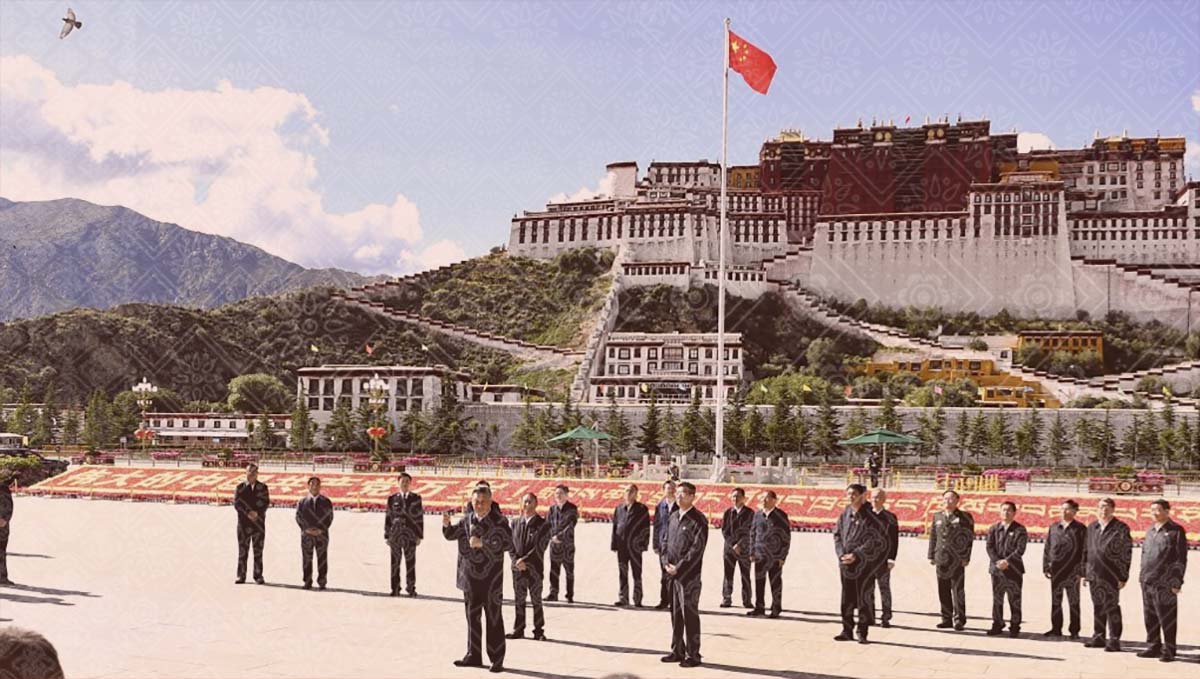
KEY FINDINGS
- Looking at the past 10 years of Xi Jinping rule (2012-2022), Tibetan optimism about him ushering in a more lenient policy, including a possible solution of the Tibetan issue, was misplaced. Rather, Xi has brought forth a new period of strengthened control.
- Xi’s focus was on two primary goals: securitize Tibet and Sinify[1] the Tibetan people in the Chinese nation-state.
- Xi’s Tibet policy revolves around the issue of Tibetan identity and the associated apprehensions. His proposed solution and path to address this concern involve the reconstitution of Tibet and Tibetans as an integrated part of the Chinese identity. The historical concept of “Zhonghua Minzu,” or the Chinese nation, that was utilized by Chinese rulers became a central theme in Xi Jinping’s speeches. Although Sinification of non-Chinese has already been underway, there had been strategic ambiguity in the policy until recently. By 2019, the party-state stopped the pretense and publicly declared Sinification as a policy unambiguously in terms of religion.
- Xi has embraced the hardline “ethnic” policy advocated by a mix of Chinese policymakers and public intellectuals in the early 2000s, thereby instigating a “second generation ethnic policy” aimed at dismantling the nationalities policies that were central to the formation of the People’s Republic of China. The objective is to foster a unified Chinese identity for the goal of Zhonghua Minzu.
- Tibetans were foremost in this long-term assimilationist drive because of their socio-political identity based on the Tibetan tradition of Buddhism. Although Buddhism in general is one of the five religions (Buddhism, Daoism, Islam, Catholicism and Protestantism) recognized by the PRC, the CCP continues to hold an antagonistic view toward Tibetan Buddhism. While the Chinese tradition of Buddhism is held as part of the indigenous Chinese culture, Tibetan Buddhism is viewed as a deviant needing guidance from the party.
- While Xi presented a positive view of Buddhism in his 2014 UNESCO speech, the reality on the ground differed significantly. Although Chinese Buddhists, too, suffer under Xi, far worse treatment is given to the Tibetan Buddhists. They are viewed as needing harmonization, and the strategy to accomplish domestication of Tibetan Buddhism is to methodically assimilate it toward developing “consciousness of the community of the Chinese nation” in order to “contribute to the realization of the Chinese dream of national rejuvenation.”
- The Xi-led administration formally launched an online database of CCP-approved Tibetan Buddhist reincarnations, officially designated as “authentic Living Buddhas” of Tibetan Buddhism, in January 2016. The database was a clear effort by the CCP to assert control over the Dalai Lama’s reincarnation and undermine the authority of legitimate Tibetan religious leaders. The legal groundwork for the CCP’s initiative was already laid down in 2007 with the issuance of Order No. 5, titled “Management measures for the reincarnation of living Buddhas in Tibetan Buddhism.”
- Creating a new generation of Sinified Tibetans for the vision of a “Chinese nation” included assimilating an entire Tibetan youth demographic. This has led to schools in Tibet being one of the primary domains for Sinification policy by strictly enforcing Chinese as the primary language over the Tibetan language in the education system to construct a new generation of Tibetans being able to identify themselves as Chinese with loyalty to the Chinese nation.
- Xi Jinping is casting the CCP’s political security as national security and accordingly frames Tibet and Tibetans as a national security issue of China. His “Overall National Security Concept” now involves everything in Tibetans’ lives, from politics, economy, development, culture, environment, etc. Xi’s version of national security is more problematic, as the new highly expansionist political-ideological construct behind the new national security concept means that any activity Tibetans undertake can be perceived as a threat to China’s sovereignty and marked as “secessionist.”
- Xi’s focus on the political security of the CCP being China’s national security has shifted the paradigm to the preemptive prevention and control model for security in Tibet. Through the mix of facial recognition and artificial intelligence technology, genome surveillance on top of the prevailing technology, the object of surveillance under Xi is to preempt any challenge to his and the CCP’s rule. Research revealed that unlike the past sporadic Tibetan DNA harvesting done by public health authorities as early as in 2012, following Xi Jinping’s coming to power, China’s police have begun collecting DNA from entire populations.
- The genome data collection of Tibetans is disturbing since both the DNA and iris collection of Tibetans is outside any ongoing criminal investigation, thus conflating crime control and social control. By targeting Tibetans from elementary school students to the elderly for genome collection, in the absence of ongoing criminal investigation, Xi views Tibetans as a threat to the national security of China.
- One of the consequences of the securitization of Tibet under Xi Jinping has been the drastic reduction in the flow of refugees from Tibet. From the 1980s until 2008 there was a steady flow of several thousand new refugees from Tibet arriving in India. In 2008, the number of refugees from Tibet dropped to 588 from 2,338 in 2007. After a gradual climb up to 753 in 2011, the number of refugees dropped to 375 in 2012, the year Xi Jinping assumed leadership. The number of refugees trickled steadily throughout the decade of Xi Jinping’s rule with only five refugees, according to the most recent available statistics, being able to flee out of Tibet in 2022.
- Similarly, there was an upsurge in the number of Tibetan self-immolations recorded in 2012. In the record 84 cases in that whole year, there were 23 self-immolations that took place in the last one and a half months of 2012 after Xi took over.
- Successive Chinese leaders, including Xi Jinping, have emphasized the importance of the unity of “all ethnic groups,” social stability and territorial integrity. Equality among peoples means that irrespective of population size, economy or military strength, everyone can co-exist on an equal footing, without one community being considered superior or better than the others. If the Tibetan and Chinese peoples can co-exist on an equal footing, this will serve as the basis for guaranteeing social stability itself. This means it is in China’s own interest to work for a mutually beneficial solution to the Tibetan issue with the Dalai Lama.
- Finally, traditional Chinese society holds filial piety important, and Xi Jinping is being projected someone who adheres to it and sees his father, Xi Zhongxun, as an inspiration. Xi senior was known to be among those advocating for a softer approach on Tibet, so Xi Jinping might uphold his father’s legacy on Tibet despite his track record to date on the contrary.
KEY FINDINGS
- Looking at the past 10 years of Xi Jinping rule (2012-2022), Tibetan optimism about him ushering in a more lenient policy, including a possible solution of the Tibetan issue, was misplaced. Rather, Xi has brought forth a new period of strengthened control.
- Xi’s focus was on two primary goals: securitize Tibet and Sinify[1] the Tibetan people in the Chinese nation-state.
- Xi’s Tibet policy revolves around the issue of Tibetan identity and the associated apprehensions. His proposed solution and path to address this concern involve the reconstitution of Tibet and Tibetans as an integrated part of the Chinese identity. The historical concept of “Zhonghua Minzu,” or the Chinese nation, that was utilized by Chinese rulers became a central theme in Xi Jinping’s speeches. Although Sinification of non-Chinese has already been underway, there had been strategic ambiguity in the policy until recently. By 2019, the party-state stopped the pretense and publicly declared Sinification as a policy unambiguously in terms of religion.
- Xi has embraced the hardline “ethnic” policy advocated by a mix of Chinese policymakers and public intellectuals in the early 2000s, thereby instigating a “second generation ethnic policy” aimed at dismantling the nationalities policies that were central to the formation of the People’s Republic of China. The objective is to foster a unified Chinese identity for the goal of Zhonghua Minzu.
- Tibetans were foremost in this long-term assimilationist drive because of their socio-political identity based on the Tibetan tradition of Buddhism. Although Buddhism in general is one of the five religions (Buddhism, Daoism, Islam, Catholicism and Protestantism) recognized by the PRC, the CCP continues to hold an antagonistic view toward Tibetan Buddhism. While the Chinese tradition of Buddhism is held as part of the indigenous Chinese culture, Tibetan Buddhism is viewed as a deviant needing guidance from the party.
- While Xi presented a positive view of Buddhism in his 2014 UNESCO speech, the reality on the ground differed significantly. Although Chinese Buddhists, too, suffer under Xi, far worse treatment is given to the Tibetan Buddhists. They are viewed as needing harmonization, and the strategy to accomplish domestication of Tibetan Buddhism is to methodically assimilate it toward developing “consciousness of the community of the Chinese nation” in order to “contribute to the realization of the Chinese dream of national rejuvenation.”
- The Xi-led administration formally launched an online database of CCP-approved Tibetan Buddhist reincarnations, officially designated as “authentic Living Buddhas” of Tibetan Buddhism, in January 2016. The database was a clear effort by the CCP to assert control over the Dalai Lama’s reincarnation and undermine the authority of legitimate Tibetan religious leaders. The legal groundwork for the CCP’s initiative was already laid down in 2007 with the issuance of Order No. 5, titled “Management measures for the reincarnation of living Buddhas in Tibetan Buddhism.”
- Creating a new generation of Sinified Tibetans for the vision of a “Chinese nation” included assimilating an entire Tibetan youth demographic. This has led to schools in Tibet being one of the primary domains for Sinification policy by strictly enforcing Chinese as the primary language over the Tibetan language in the education system to construct a new generation of Tibetans being able to identify themselves as Chinese with loyalty to the Chinese nation.
- Xi Jinping is casting the CCP’s political security as national security and accordingly frames Tibet and Tibetans as a national security issue of China. His “Overall National Security Concept” now involves everything in Tibetans’ lives, from politics, economy, development, culture, environment, etc. Xi’s version of national security is more problematic, as the new highly expansionist political-ideological construct behind the new national security concept means that any activity Tibetans undertake can be perceived as a threat to China’s sovereignty and marked as “secessionist.”
- Xi’s focus on the political security of the CCP being China’s national security has shifted the paradigm to the preemptive prevention and control model for security in Tibet. Through the mix of facial recognition and artificial intelligence technology, genome surveillance on top of the prevailing technology, the object of surveillance under Xi is to preempt any challenge to his and the CCP’s rule. Research revealed that unlike the past sporadic Tibetan DNA harvesting done by public health authorities as early as in 2012, following Xi Jinping’s coming to power, China’s police have begun collecting DNA from entire populations.
- The genome data collection of Tibetans is disturbing since both the DNA and iris collection of Tibetans is outside any ongoing criminal investigation, thus conflating crime control and social control. By targeting Tibetans from elementary school students to the elderly for genome collection, in the absence of ongoing criminal investigation, Xi views Tibetans as a threat to the national security of China.
- One of the consequences of the securitization of Tibet under Xi Jinping has been the drastic reduction in the flow of refugees from Tibet. From the 1980s until 2008 there was a steady flow of several thousand new refugees from Tibet arriving in India. In 2008, the number of refugees from Tibet dropped to 588 from 2,338 in 2007. After a gradual climb up to 753 in 2011, the number of refugees dropped to 375 in 2012, the year Xi Jinping assumed leadership. The number of refugees trickled steadily throughout the decade of Xi Jinping’s rule with only five refugees, according to the most recent available statistics, being able to flee out of Tibet in 2022.
- Similarly, there was an upsurge in the number of Tibetan self-immolations recorded in 2012. In the record 84 cases in that whole year, there were 23 self-immolations that took place in the last one and a half months of 2012 after Xi took over.
- Successive Chinese leaders, including Xi Jinping, have emphasized the importance of the unity of “all ethnic groups,” social stability and territorial integrity. Equality among peoples means that irrespective of population size, economy or military strength, everyone can co-exist on an equal footing, without one community being considered superior or better than the others. If the Tibetan and Chinese peoples can co-exist on an equal footing, this will serve as the basis for guaranteeing social stability itself. This means it is in China’s own interest to work for a mutually beneficial solution to the Tibetan issue with the Dalai Lama.
- Finally, traditional Chinese society holds filial piety important, and Xi Jinping is being projected someone who adheres to it and sees his father, Xi Zhongxun, as an inspiration. Xi senior was known to be among those advocating for a softer approach on Tibet, so Xi Jinping might uphold his father’s legacy on Tibet despite his track record to date on the contrary.
INTRODUCTION
In 2012-2013, Xi Jinping took over as the top leader of the People’s Republic of China, first as the General Secretary of the Chinese Communist Party in November 2012 and then President of the People’s Republic of China in March 2013. At that time, much of the international community was hopeful of his ushering in “reform” of China. In 2011 when it was clear that Xi was going to be the next Chinese leader, he was projected as “pragmatic” in the West.[2]
Tibetans were also among those filled with optimism over Xi and hoping for forward movement on the resolution of the Tibet-China conflict. In November 2012, on the eve of Xi Jinping taking over, the Dalai Lama, who was on a visit to Japan, responded to media questions about Xi, saying, “Now Hu Jintao’s era (is the) past, now Xi Jinping is coming as president. I think there’s no alternative except some political change, so political reform. Economy reform (is) already there.”[3] He was more explicit in 2014 when the media asked him about Xi, who was visiting India then. The Dalai Lama responded saying, “Xi Jinping’s thinking is more realistic, and he is more open minded.”[4]
Tibetan optimism about Xi did have some legitimate basis. Xi’s family is believed to be interested in Buddhism and also had positive links to Tibetan affairs. His father, Xi Zhongxun, was considered a moderate leader and was involved on Tibet in the initial period of the Chinese incursion into Tibet. He continued his interest thereafter. In the process, he established a personal relationship with many important Tibetan political and religious figures, including the Dalai Lama, as well as Bapa Phuntso Wangye (who also credits Xi Zhongxun for coming to his aid when he was being sidelined in the 1980s)[5]. Xi Jinping’s mother, Qi Xin, and wife, Peng Liyuan, were believed to be devout Buddhists, with Peng also said to have a Tibetan Buddhist master.
It was not just Tibetans, but even among Chinese there were those who were hoping for better days under Xi Jinping. “To understand what kind of leader Xi Jinping will be, one must study his father’s (policies),” Bao Tong, one-time top aide to Chinese leader Zhao Ziyang, was quoted by Reuters as saying in September 2012.[6] “No (Chinese) Communist will betray his father,” Bao added.
Similarly, Lin Chong-Pin, a former Taiwan defense minister and China policymaker, was also quoted by Reuters in 2012 about Xi’s possible approach, saying, “There will be a more tolerant policy not only (towards) Tibet, but also Xinjiang.”[7]
Ten years later, and contrary to certain expectations, Xi Jinping has shown himself to be among the most ruthless of Chinese leaders as he has gone on to consolidate his power to the extent of virtually making himself the leader for life. Contrary to hopes of liberal-minded reforms, China today has turned out to be one of the most controlled nations.
While leaders may have some influence in the Chinese political system, it is the institutional interests that overwhelmingly take precedence. China watcher Dr. David Shambaugh, in response to the question of reforms to policy and governance challenges when Xi took over in November 2012, wrote, “Those inside and outside of China anticipating a return to an ambitious reformist agenda that will further open and decentralize the economy; liberalize the polity; reduce social inequities and tackle pervasive corruption; and rectify strains in China’s relations with its neighbors in Asia, the European Union and the United States will be disappointed. China is in dire need of visionary and strong leadership—the complex challenges facing the nation have grown more acute during Hu Jintao’s presidency—but don’t expect it from the new team in Beijing.”[8]
Xi showed himself to be first and foremost the top guardian of the Chinese Communist Party, entrusted with the mandate to guarantee the party’s monopoly on power and steer China toward becoming a global superpower, navigating the structural and systemic challenges it faces.
When Xi assumed the role of Party General Secretary, the party was facing numerous domestic and international challenges to its ongoing governance. Identifying corruption as the foremost obstacle to its legitimacy, the party recognized that influential political clans were deeply entrenched in corrupt practices, thus undermining its authority in the eyes of the Chinese populace. The party confronted the dual challenge of combating corruption within the party while simultaneously safeguarding the interests of influential political families. This resulted in the appointment of “princelings,” the offspring of senior Communist Party officials, to key positions within the powerful Political Bureau of the Standing Committee of the CCP (PBSC). It was in 2012 that four princelings, including Xi Jinping, attained membership in the influential seven-member PBSC, with Xi assuming the top leadership position. It is believed that the opaque and influential party elders’ conviction was that the princelings are the most dependable guardians of the party’s ruling status and the individuals least inclined to expose the corrupt undertakings of influential political clans.[9]
According to Boguz et al. of the Polish think tank OSW, “When Xi Jinping assumed power as General Secretary in 2012, he received a mandate from the CCP’s leaders to make a major adjustment in the structures of the Party and state, a kind of conservative turn aimed at completing the transition from a revolutionary party to a permanently ruling party, restoring the prospects for the CCP’s continued, indivisible rule in China … His response to the problems facing the Party has been a conservative – more precisely, in the Chinese context, a neoconservative – renewal of the foundations of the PRC as established in 1949, including the strengthening of the Party at the expense of the state, a return to ideology as a tool of social control, and the rejection of previous experiments in limiting the Party’s power by means of the rule of law and political liberalization.”[10]
Upon coming to power, Xi not only continued many of the political policies initiated by his predecessors but intensified and accelerated the pace of the programs for his “China dream” signature project outlined by the “Two Centennial Goals” to “build a moderately prosperous society in all respects” by 2021, the centennial year of the establishment of the Chinese Communist Party, and to “build a modern socialist country that is prosperous, strong, democratic, culturally advanced and harmonious” by 2049, the centennial year of the establishment of the People’s Republic of China.[11]
The second prominent feature of Xi Jinping’s rule is the securitization of all aspects of life for “national security,” which has meant expanding and consolidating the regime security of the CCP.
INTRODUCTION
In 2012-2013, Xi Jinping took over as the top leader of the People’s Republic of China, first as the General Secretary of the Chinese Communist Party in November 2012 and then President of the People’s Republic of China in March 2013. At that time, much of the international community was hopeful of his ushering in “reform” of China. In 2011 when it was clear that Xi was going to be the next Chinese leader, he was projected as “pragmatic” in the West.[2]
Tibetans were also among those filled with optimism over Xi and hoping for forward movement on the resolution of the Tibet-China conflict. In November 2012, on the eve of Xi Jinping taking over, the Dalai Lama, who was on a visit to Japan, responded to media questions about Xi, saying, “Now Hu Jintao’s era (is the) past, now Xi Jinping is coming as president. I think there’s no alternative except some political change, so political reform. Economy reform (is) already there.”[3] He was more explicit in 2014 when the media asked him about Xi, who was visiting India then. The Dalai Lama responded saying, “Xi Jinping’s thinking is more realistic, and he is more open minded.”[4]
Tibetan optimism about Xi did have some legitimate basis. Xi’s family is believed to be interested in Buddhism and also had positive links to Tibetan affairs. His father, Xi Zhongxun, was considered a moderate leader and was involved on Tibet in the initial period of the Chinese incursion into Tibet. He continued his interest thereafter. In the process, he established a personal relationship with many important Tibetan political and religious figures, including the Dalai Lama, as well as Bapa Phuntso Wangye (who also credits Xi Zhongxun for coming to his aid when he was being sidelined in the 1980s)[5]. Xi Jinping’s mother, Qi Xin, and wife, Peng Liyuan, were believed to be devout Buddhists, with Peng also said to have a Tibetan Buddhist master.
It was not just Tibetans, but even among Chinese there were those who were hoping for better days under Xi Jinping. “To understand what kind of leader Xi Jinping will be, one must study his father’s (policies),” Bao Tong, one-time top aide to Chinese leader Zhao Ziyang, was quoted by Reuters as saying in September 2012.[6] “No (Chinese) Communist will betray his father,” Bao added.
Similarly, Lin Chong-Pin, a former Taiwan defense minister and China policymaker, was also quoted by Reuters in 2012 about Xi’s possible approach, saying, “There will be a more tolerant policy not only (towards) Tibet, but also Xinjiang.”[7]
Ten years later, and contrary to certain expectations, Xi Jinping has shown himself to be among the most ruthless of Chinese leaders as he has gone on to consolidate his power to the extent of virtually making himself the leader for life. Contrary to hopes of liberal-minded reforms, China today has turned out to be one of the most controlled nations.
While leaders may have some influence in the Chinese political system, it is the institutional interests that overwhelmingly take precedence. China watcher Dr. David Shambaugh, in response to the question of reforms to policy and governance challenges when Xi took over in November 2012, wrote, “Those inside and outside of China anticipating a return to an ambitious reformist agenda that will further open and decentralize the economy; liberalize the polity; reduce social inequities and tackle pervasive corruption; and rectify strains in China’s relations with its neighbors in Asia, the European Union and the United States will be disappointed. China is in dire need of visionary and strong leadership—the complex challenges facing the nation have grown more acute during Hu Jintao’s presidency—but don’t expect it from the new team in Beijing.”[8]
Xi showed himself to be first and foremost the top guardian of the Chinese Communist Party, entrusted with the mandate to guarantee the party’s monopoly on power and steer China toward becoming a global superpower, navigating the structural and systemic challenges it faces.
When Xi assumed the role of Party General Secretary, the party was facing numerous domestic and international challenges to its ongoing governance. Identifying corruption as the foremost obstacle to its legitimacy, the party recognized that influential political clans were deeply entrenched in corrupt practices, thus undermining its authority in the eyes of the Chinese populace. The party confronted the dual challenge of combating corruption within the party while simultaneously safeguarding the interests of influential political families. This resulted in the appointment of “princelings,” the offspring of senior Communist Party officials, to key positions within the powerful Political Bureau of the Standing Committee of the CCP (PBSC). It was in 2012 that four princelings, including Xi Jinping, attained membership in the influential seven-member PBSC, with Xi assuming the top leadership position. It is believed that the opaque and influential party elders’ conviction was that the princelings are the most dependable guardians of the party’s ruling status and the individuals least inclined to expose the corrupt undertakings of influential political clans.[9]
According to Boguz et al. of the Polish think tank OSW, “When Xi Jinping assumed power as General Secretary in 2012, he received a mandate from the CCP’s leaders to make a major adjustment in the structures of the Party and state, a kind of conservative turn aimed at completing the transition from a revolutionary party to a permanently ruling party, restoring the prospects for the CCP’s continued, indivisible rule in China … His response to the problems facing the Party has been a conservative – more precisely, in the Chinese context, a neoconservative – renewal of the foundations of the PRC as established in 1949, including the strengthening of the Party at the expense of the state, a return to ideology as a tool of social control, and the rejection of previous experiments in limiting the Party’s power by means of the rule of law and political liberalization.”[10]
Upon coming to power, Xi not only continued many of the political policies initiated by his predecessors but intensified and accelerated the pace of the programs for his “China dream” signature project outlined by the “Two Centennial Goals” to “build a moderately prosperous society in all respects” by 2021, the centennial year of the establishment of the Chinese Communist Party, and to “build a modern socialist country that is prosperous, strong, democratic, culturally advanced and harmonious” by 2049, the centennial year of the establishment of the People’s Republic of China.[11]
The second prominent feature of Xi Jinping’s rule is the securitization of all aspects of life for “national security,” which has meant expanding and consolidating the regime security of the CCP.
SECURITIZATION AND SINIFICATION OF TIBETANS
In hindsight, Tibetan optimism about Xi Jinping ushering in a more lenient policy, even a possible solution of the Tibetan issue, was misplaced. Rather, Xi has brought forth a new period of strengthened control and assimilation resulting in the Sinification and securitization of Tibetans.
Xi Jinping’s focus was on two primary goals: securitize Tibet and Sinify the Tibetan people within the Chinese nation-state. This report focuses on a discourse analysis of speeches of Chinese leaders and draws upon various think tanks, NGO reports and academic publications to understand the thrust of the Xi Jinping administration’s Tibet policy to Sinify and securitize Tibet and Tibetans in the Chinese nation-state. The speeches of Chinese leaders provide insights into the priorities, strategies, policies and intentions of the Chinese party-state.
Xi Jinping has placed significant emphasis on Tibet’s role within China’s security framework. In 2011, even before he assumed the top leadership position, during the commemoration of the 60th anniversary of China’s so-called “peaceful liberation” of Tibet, Xi, who was serving as China’s vice president at the time, highlighted the crucial position of Tibet as a key national security barrier. This enabled China to direct its attention toward the perceived threat of Taiwan, as the Tibetan massif provides protection against the perceived remote threat from India. Since assuming top party leadership, Xi has consistently underscored the strategic importance of governing the “frontiers” and, in particular, focusing on “the four major issues of stability, development, ecology and border-area consolidation” in Tibet.[12]
Xi laid out his thinking on Tibet and China’s stability in a speech on March 9, 2013, while participating in a panel discussion with the Tibetan delegation during the first session of the 12th National People’s Congress. Xi stated, “To effectively govern the country, we must first govern the frontiers, and to govern the frontiers effectively, we must ensure stability in Tibet.”[13] This statement further reinforces the importance placed on Tibet’s stability in the overall governance of China.
During the 6th and 7th Tibet Work Forums held in 2015 and 2020 respectively, Xi Jinping reiterated the critical relationship between the security and stability of China and the security and stability of Tibet. These affirmations solidified the understanding that Tibet plays a vital role in maintaining the overall security and stability of China as a nation.
One of the results of the securitization of Tibet under Xi Jinping was visible in the flow of refugees from Tibet, which correlates to security policies being implemented in Tibet.
In the immediate years following the Dalai Lama’s escape from Tibet in 1959, over 80,000 Tibetans were also able to flee to India. Thereafter, until a brief period of liberalization in the 1980s, Tibetan borders were closed, and there were hardly any Tibetans able to escape. From the 1980s until 2008, there was a steady flow of new refugees from Tibet arriving in India.
The flow of refugees from Tibet dropped dramatically in the wake of the party’s response to the pan-Tibet protests in spring 2008. In 2008, the number of refugees from Tibet dropped to 588 from 2,338 in 2007. After a gradual climb up to 753 in 2011, the number of refugees dropped by 50% to 375 in 2012, the year Xi Jinping assumed leadership. With intensive securitization of Tibet, the number of refugees from Tibet trickled down steadily throughout the decade of Xi Jinping’s rule, with only five refugees able to flee Tibet during the last count in 2022. With the party turning Tibet into a securitized black box, it is hard for anyone to conduct independent research in Tibet, but the trickling of refugees from Tibet is the clearest indication of hardening policies and social securitization taking place inside Tibet.
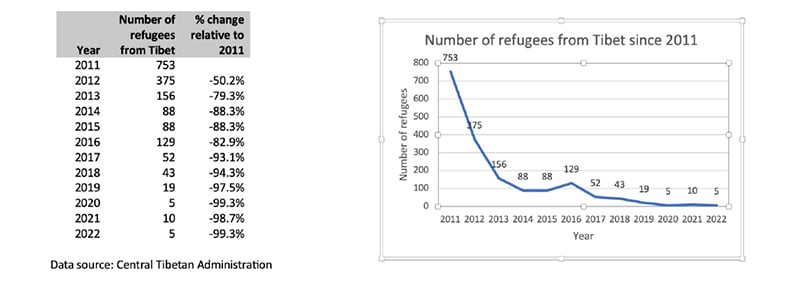
Similarly, the wave of self-immolations in Tibet began after the Chinese government cracked down on human rights following mostly peaceful widespread protests by Tibetans in 2008. Notably, there was an upsurge in the number of Tibetan self-immolations recorded in 2012. In the record 84 cases in the whole year, there were 23 self-immolations that took place in the last one and a half months of 2012 after Xi took over. Tibetans can be sentenced on homicide charges based on their alleged “intent” and presumed ability to influence a Tibetan who has self-immolated.
In December 2012, a month after Xi Jinping became head of the Chinese Communist Party, new measures were adopted under which Tibetans could be sentenced on homicide charges based on their alleged “intent” and presumed ability to influence a Tibetan who has self-immolated.[14] According to the new guidelines, “anyone who organizes, plots, incites, coerces, entices, abets, or assists others to commit self-immolations shall be held criminally liable for intentional homicide in accordance with the Criminal Law.” Within two years after this new guideline, at least 11 Tibetans were sentenced to prison terms or even to death on “intentional homicide” charges, because they allegedly “aided” or “incited” others to self-immolate. In order to signify the seriousness of the guidelines, “the Supreme People’s Court of the People’s Republic of China, the Supreme People’s Procuratorate and the Ministry of Public Security jointly issued the “Opinions on Handling Self-immolation Cases in Tibetan Areas in accordance with the Law.”[15] The Opinion sternly stated that the self-immolating Tibetans and related Tibetans would be “held legally responsible.”
The approval of the new guidelines” involving three of the highest institutions in the Chinese political system may have reflected a political imperative of the new leadership under Xi to adopt hardline policies and crackdown in Tibet.
The self-immolators include Tibetans monks, nuns and laypeople who chose to harm themselves rather than harm their oppressors. The vast majority of them are known to have died following their protests. No foreign journalist has ever been allowed to independently investigate cases of self-immolations because China blocks outside access to Tibet.
SECURITIZATION AND SINIFICATION OF TIBETANS
In hindsight, Tibetan optimism about Xi Jinping ushering in a more lenient policy, even a possible solution of the Tibetan issue, was misplaced. Rather, Xi has brought forth a new period of strengthened control and assimilation resulting in the Sinification and securitization of Tibetans.
Xi Jinping’s focus was on two primary goals: securitize Tibet and Sinify the Tibetan people within the Chinese nation-state. This report focuses on a discourse analysis of speeches of Chinese leaders and draws upon various think tanks, NGO reports and academic publications to understand the thrust of the Xi Jinping administration’s Tibet policy to Sinify and securitize Tibet and Tibetans in the Chinese nation-state. The speeches of Chinese leaders provide insights into the priorities, strategies, policies and intentions of the Chinese party-state.
Xi Jinping has placed significant emphasis on Tibet’s role within China’s security framework. In 2011, even before he assumed the top leadership position, during the commemoration of the 60th anniversary of China’s so-called “peaceful liberation” of Tibet, Xi, who was serving as China’s vice president at the time, highlighted the crucial position of Tibet as a key national security barrier. This enabled China to direct its attention toward the perceived threat of Taiwan, as the Tibetan massif provides protection against the perceived remote threat from India. Since assuming top party leadership, Xi has consistently underscored the strategic importance of governing the “frontiers” and, in particular, focusing on “the four major issues of stability, development, ecology and border-area consolidation” in Tibet.[12]
Xi laid out his thinking on Tibet and China’s stability in a speech on March 9, 2013, while participating in a panel discussion with the Tibetan delegation during the first session of the 12th National People’s Congress. Xi stated, “To effectively govern the country, we must first govern the frontiers, and to govern the frontiers effectively, we must ensure stability in Tibet.”[13] This statement further reinforces the importance placed on Tibet’s stability in the overall governance of China.
During the 6th and 7th Tibet Work Forums held in 2015 and 2020 respectively, Xi Jinping reiterated the critical relationship between the security and stability of China and the security and stability of Tibet. These affirmations solidified the understanding that Tibet plays a vital role in maintaining the overall security and stability of China as a nation.
One of the results of the securitization of Tibet under Xi Jinping was visible in the flow of refugees from Tibet, which correlates to security policies being implemented in Tibet.
In the immediate years following the Dalai Lama’s escape from Tibet in 1959, over 80,000 Tibetans were also able to flee to India. Thereafter, until a brief period of liberalization in the 1980s, Tibetan borders were closed, and there were hardly any Tibetans able to escape. From the 1980s until 2008, there was a steady flow of new refugees from Tibet arriving in India.
The flow of refugees from Tibet dropped dramatically in the wake of the party’s response to the pan-Tibet protests in spring 2008. In 2008, the number of refugees from Tibet dropped to 588 from 2,338 in 2007. After a gradual climb up to 753 in 2011, the number of refugees dropped by 50% to 375 in 2012, the year Xi Jinping assumed leadership. With intensive securitization of Tibet, the number of refugees from Tibet trickled down steadily throughout the decade of Xi Jinping’s rule, with only five refugees able to flee Tibet during the last count in 2022. With the party turning Tibet into a securitized black box, it is hard for anyone to conduct independent research in Tibet, but the trickling of refugees from Tibet is the clearest indication of hardening policies and social securitization taking place inside Tibet.

Similarly, the wave of self-immolations in Tibet began after the Chinese government cracked down on human rights following mostly peaceful widespread protests by Tibetans in 2008. Notably, there was an upsurge in the number of Tibetan self-immolations recorded in 2012. In the record 84 cases in the whole year, there were 23 self-immolations that took place in the last one and a half months of 2012 after Xi took over. Tibetans can be sentenced on homicide charges based on their alleged “intent” and presumed ability to influence a Tibetan who has self-immolated.
In December 2012, a month after Xi Jinping became head of the Chinese Communist Party, new measures were adopted under which Tibetans could be sentenced on homicide charges based on their alleged “intent” and presumed ability to influence a Tibetan who has self-immolated.[14] According to the new guidelines, “anyone who organizes, plots, incites, coerces, entices, abets, or assists others to commit self-immolations shall be held criminally liable for intentional homicide in accordance with the Criminal Law.” Within two years after this new guideline, at least 11 Tibetans were sentenced to prison terms or even to death on “intentional homicide” charges, because they allegedly “aided” or “incited” others to self-immolate. In order to signify the seriousness of the guidelines, “the Supreme People’s Court of the People’s Republic of China, the Supreme People’s Procuratorate and the Ministry of Public Security jointly issued the “Opinions on Handling Self-immolation Cases in Tibetan Areas in accordance with the Law.”[15] The Opinion sternly stated that the self-immolating Tibetans and related Tibetans would be “held legally responsible.”
The approval of the new guidelines” involving three of the highest institutions in the Chinese political system may have reflected a political imperative of the new leadership under Xi to adopt hardline policies and crackdown in Tibet.
The self-immolators include Tibetans monks, nuns and laypeople who chose to harm themselves rather than harm their oppressors. The vast majority of them are known to have died following their protests. No foreign journalist has ever been allowed to independently investigate cases of self-immolations because China blocks outside access to Tibet.
TIBETAN SELF-IMMOLATIONS
Throughout the past decade and continuing to this day, Tibetans have adopted the most drastic form of protest in the hopes of effecting change, sacrificing their lives in order to be heard. Tibetan self-immolations are a call for change, and that call was most prominent in the year when Xi Jinping took charge as the General Secretary of the Chinese Communist Party. The number of self-immolations in Tibet peaked in 2012, the year Xi took charge of the CCP, with 84 recorded cases. The number of self-immolations in 2012 account for 53% of the total self-immolations to date.
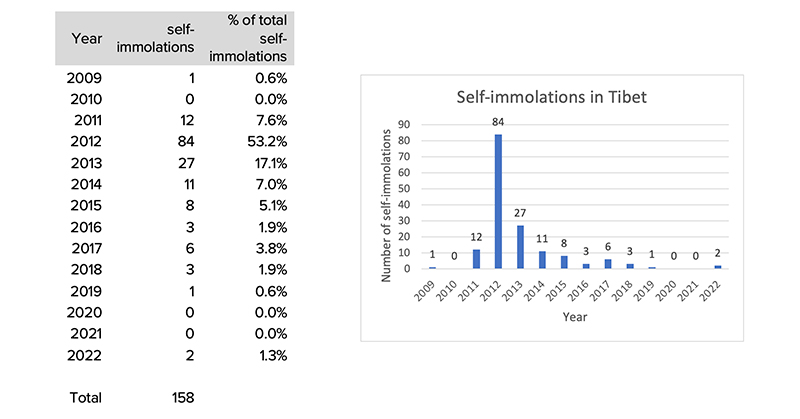
Despite the adoption of this very drastic form of protest, the legitimate interests and aspirations of the Tibetans—designated as one of the ethnic minorities in the party’s parlance (although Tibetans do not consider themselves minorities since Tibet is their own land)—in the People’s Republic of China are not legitimately addressed but instead continue to be sidelined and dominated by the interests of the party-state of “long term stability” and “high quality development.” Instead of the party-state liberalizing progressively as hoped for by Tibetans as well as liberals globally, China took an about turn with Xi steering the country back toward the foundations of the party-state through Leninist-Stalinist methods, albeit stopping short of Mao’s tyranny.[16]
TIBETAN SELF-IMMOLATIONS
Throughout the past decade and continuing to this day, Tibetans have adopted the most drastic form of protest in the hopes of effecting change, sacrificing their lives in order to be heard. Tibetan self-immolations are a call for change, and that call was most prominent in the year when Xi Jinping took charge as the General Secretary of the Chinese Communist Party. The number of self-immolations in Tibet peaked in 2012, the year Xi took charge of the CCP, with 84 recorded cases. The number of self-immolations in 2012 account for 53% of the total self-immolations to date.

Despite the adoption of this very drastic form of protest, the legitimate interests and aspirations of the Tibetans—designated as one of the ethnic minorities in the party’s parlance (although Tibetans do not consider themselves minorities since Tibet is their own land)—in the People’s Republic of China are not legitimately addressed but instead continue to be sidelined and dominated by the interests of the party-state of “long term stability” and “high quality development.” Instead of the party-state liberalizing progressively as hoped for by Tibetans as well as liberals globally, China took an about turn with Xi steering the country back toward the foundations of the party-state through Leninist-Stalinist methods, albeit stopping short of Mao’s tyranny.[16]
ACTION PLANS ON SINIFICATION OF TIBETANS
A significant aspect of Xi Jinping’s approach revolves around the issue of Tibetan identity and the associated apprehensions. According to his proposed solution, the path to address this concern involves the reconstitution of Tibet and Tibetans as an integrated part of the Chinese identity, rather than a strategy solely based on assimilation. This is clear in the directives “Six Musts” and “10 Musts” that he issued during the 6th and 7th Tibet Work Forums, which point to Sinification of Tibet and Tibetans.
The “6 musts” laid out during the 6th Tibet Work Forum in 2015 are:[17]
- Uphold the leadership of the Communist Party of China, uphold the socialist system, and uphold the system of regional ethnic autonomy.
- Adhere to the strategic thinking that governing the country must govern the borders, and the borders must first stabilize Tibet.
- Adhere to the important principles of governing Tibet according to the law, enriching the people and rejuvenating Tibet, building Tibet for a long time, uniting people’s hearts, and consolidating the foundation.
- Fully and correctly implement the party’s ethnic policy and religious policy, strengthen ethnic unity, and continuously increase the recognition of the people of all ethnic groups to the great motherland, the Chinese nation, Chinese culture, the Communist Party of China, and socialism with Chinese characteristics.
- Closely combine the care of the central government and the support of the whole country with the hard work of the cadres and masses of all ethnic groups in Tibet, and do a good job in Tibet while coordinating the overall domestic and international situations.
- Strengthen the construction of party organizations and cadres at all levels to consolidate the party’s ruling foundation in Tibet.
The “10 musts” Xi laid out during the 7th Tibet Work Forum in 2020 are:[18]
- Adhere to the leadership of the Communist Party of China, the socialist system with Chinese characteristics, and the system of regional ethnic autonomy.
- Adhere to the strategic thinking that governing the country must govern the border, and governing the border first stabilizes Tibet.
- Maintaining the unity of the motherland and strengthening national unity must be the focus and the focus of work in Tibet.
- We must adhere to the important principles of governing Tibet according to the law, enriching the people and rejuvenating Tibet, building Tibet for a long time, uniting people’s hearts and laying a solid foundation.
- Take into account both domestic and international situations.
- Improving people’s livelihood and uniting people’s hearts must be taken as the starting point and goal of economic and social development.
- Promote exchange and integration of various ethnic groups.
- Adhere to the direction of Sinicization of religion in our country and manage religious affairs according to law.
- Insist on ecological protection first.
- Strengthen party building, especially political building must be strengthened.
The 2020 agenda is not only more elaborate than 2015, but also more insistent on assimilation.
ACTION PLANS ON SINIFICATION OF TIBETANS
A significant aspect of Xi Jinping’s approach revolves around the issue of Tibetan identity and the associated apprehensions. According to his proposed solution, the path to address this concern involves the reconstitution of Tibet and Tibetans as an integrated part of the Chinese identity, rather than a strategy solely based on assimilation. This is clear in the directives “Six Musts” and “10 Musts” that he issued during the 6th and 7th Tibet Work Forums, which point to Sinification of Tibet and Tibetans.
The “6 musts” laid out during the 6th Tibet Work Forum in 2015 are:[17]
- Uphold the leadership of the Communist Party of China, uphold the socialist system, and uphold the system of regional ethnic autonomy.
- Adhere to the strategic thinking that governing the country must govern the borders, and the borders must first stabilize Tibet.
- Adhere to the important principles of governing Tibet according to the law, enriching the people and rejuvenating Tibet, building Tibet for a long time, uniting people’s hearts, and consolidating the foundation.
- Fully and correctly implement the party’s ethnic policy and religious policy, strengthen ethnic unity, and continuously increase the recognition of the people of all ethnic groups to the great motherland, the Chinese nation, Chinese culture, the Communist Party of China, and socialism with Chinese characteristics.
- Closely combine the care of the central government and the support of the whole country with the hard work of the cadres and masses of all ethnic groups in Tibet, and do a good job in Tibet while coordinating the overall domestic and international situations.
- Strengthen the construction of party organizations and cadres at all levels to consolidate the party’s ruling foundation in Tibet.
The “10 musts” Xi laid out during the 7th Tibet Work Forum in 2020 are:[18]
- Adhere to the leadership of the Communist Party of China, the socialist system with Chinese characteristics, and the system of regional ethnic autonomy.
- Adhere to the strategic thinking that governing the country must govern the border, and governing the border first stabilizes Tibet.
- Maintaining the unity of the motherland and strengthening national unity must be the focus and the focus of work in Tibet.
- We must adhere to the important principles of governing Tibet according to the law, enriching the people and rejuvenating Tibet, building Tibet for a long time, uniting people’s hearts and laying a solid foundation.
- Take into account both domestic and international situations.
- Improving people’s livelihood and uniting people’s hearts must be taken as the starting point and goal of economic and social development.
- Promote exchange and integration of various ethnic groups.
- Adhere to the direction of Sinicization of religion in our country and manage religious affairs according to law.
- Insist on ecological protection first.
- Strengthen party building, especially political building must be strengthened.
The 2020 agenda is not only more elaborate than 2015, but also more insistent on assimilation.
SINIFICATION OF TIBETANS FOR THE CHINESE NATION-STATE
The historical concept of “Zhonghua Minzu,” or the Chinese nation, that was utilized by Chinese rulers became a central theme in Xi Jinping’s speeches after he took over in 2012. Leaders, philosophers, thinkers and policymakers throughout the modern history of China have imagined and envisioned the Chinese nation differently prior to and after the establishment of the People’s Republic of China. However, Xi Jinping’s vision for building the Chinese nation is derived from the dominant hardliners stream of thought in envisioning his signature China Dream project, consolidating the Chinese nationalist narrative of the “century of humiliation.”
Speaking as the newly selected General Secretary of the CCP during an official visit to an exhibition titled “The Road to Rejuvenation” on Nov. 29, 2012 only a few days after he took over, Xi stated: “Having reviewed our historical experience and made painstaking efforts to probe our way forward in the past 30 years and more since the reform and opening-up process was started, we have finally embarked on the right path to achieve the rejuvenation of the Chinese nation and made impressive achievements in this pursuit.”[19] For the goal of “great rejuvenation of the Chinese nation” by 2049, Xi envisioned “forging the consciousness of the community of the Chinese nation as the main line and the cause of national unity and progress as the basic cause.”[20]
The discourse surrounding Sinification is disproportionately centered on the Sinification of religions in China. Observers have commented extensively on Sinification of religion, as the CCP situates Sinification in terms of religions in China. At the heart of Sinification is the idea of Sinifying all peoples and their identity characteristics to make them Chinese for a Zhonghua Minzu, or Chinese nation-state. Max Oidtmann of the University of Munich succinctly clarifies the misunderstanding over Sinification by stating that “the purpose of “Chinafication” is not simply the assimilation of “minority groups” into the “Han,” the ethnic category that was used for Chinese, but rather the creation of a new supra-ethnic identity animated by loyalty to the PRC state and the messianic world-historical mission of the CCP. The Xi Jinping cohort have revived the somewhat moribund phrase Zhonghua Minzu (中华民族) to serve as a unifying label for the “Chinafied” people of the PRC.”[21]
To understand the evolution in the semantics of Zhonghua Minzu and its significance in relation to Xi Jinping’s adoption of a hardliner approach, it is important to provide a brief background and delve into the discussions surrounding the Chinese term “Minzu.”
SINIFICATION OF TIBETANS FOR THE CHINESE NATION-STATE
The historical concept of “Zhonghua Minzu,” or the Chinese nation, that was utilized by Chinese rulers became a central theme in Xi Jinping’s speeches after he took over in 2012. Leaders, philosophers, thinkers and policymakers throughout the modern history of China have imagined and envisioned the Chinese nation differently prior to and after the establishment of the People’s Republic of China. However, Xi Jinping’s vision for building the Chinese nation is derived from the dominant hardliners stream of thought in envisioning his signature China Dream project, consolidating the Chinese nationalist narrative of the “century of humiliation.”
Speaking as the newly selected General Secretary of the CCP during an official visit to an exhibition titled “The Road to Rejuvenation” on Nov. 29, 2012 only a few days after he took over, Xi stated: “Having reviewed our historical experience and made painstaking efforts to probe our way forward in the past 30 years and more since the reform and opening-up process was started, we have finally embarked on the right path to achieve the rejuvenation of the Chinese nation and made impressive achievements in this pursuit.”[19] For the goal of “great rejuvenation of the Chinese nation” by 2049, Xi envisioned “forging the consciousness of the community of the Chinese nation as the main line and the cause of national unity and progress as the basic cause.”[20]
The discourse surrounding Sinification is disproportionately centered on the Sinification of religions in China. Observers have commented extensively on Sinification of religion, as the CCP situates Sinification in terms of religions in China. At the heart of Sinification is the idea of Sinifying all peoples and their identity characteristics to make them Chinese for a Zhonghua Minzu, or Chinese nation-state. Max Oidtmann of the University of Munich succinctly clarifies the misunderstanding over Sinification by stating that “the purpose of “Chinafication” is not simply the assimilation of “minority groups” into the “Han,” the ethnic category that was used for Chinese, but rather the creation of a new supra-ethnic identity animated by loyalty to the PRC state and the messianic world-historical mission of the CCP. The Xi Jinping cohort have revived the somewhat moribund phrase Zhonghua Minzu (中华民族) to serve as a unifying label for the “Chinafied” people of the PRC.”[21]
To understand the evolution in the semantics of Zhonghua Minzu and its significance in relation to Xi Jinping’s adoption of a hardliner approach, it is important to provide a brief background and delve into the discussions surrounding the Chinese term “Minzu.”
REINVENTING ZHONGHUA MINZU: CHINESE NATION
The connotation of the Sinified term “minzu” is notorious for being untranslatable into any language. However, Chinese intellectuals and policymakers have made various attempts at distilling a denotation for the term relatable to the Western political terms of nationality and ethnicity. Originally a 19th century Japanese loanword (“minzuku” in Japanese), minzu in the Chinese political context had always been understood as equivalent to the political term “nationality.” The CCP adopted Stalin’s four criteria to define minzu based on common territory, common economy, common language and common psychological makeup. But that was problematic to Chinese policymakers and nationalistic public intellectuals in recent decades. To differentiate between Han Chinese and the minority nationalities and to forestall any national political and territorial rights of the latter, “zuqun” (ethnic group) was used to recategorize all those considered minority nationalities in China.
Uradyn E. Bulag, a scholar at Cambridge University, provides critical insights into the Chinese preference for zuqun instead of minzu in inventing the Chinese nation (Zhonghua Minzu).[22] With the renaming of minzu (nationality) as zuqun (ethnic group), he argues that “ethnic minorities are now seen as constitutive lineages of the Chinese nation (Zhonghua Minzu), for zuqun in Chinese literally means “lineage group.” The earlier classification of those considered “minority nationalities” as minzu presupposed that they were then a nation with its own history, territory, language, culture and religion. The implication of recognizing a Tibetan nation and society is that Tibet and Tibetans came to be in China due to expansion, an idea outrightly denied by China as it runs counter to the Chinese victim-oriented narrative of the “century of humiliation.” In the international environment, it also meant accepting that Tibetans as a group have the right to self-determination.
On the other hand, the consequence of categorizing Tibetans as an ethnic group is an automatic subservience to the dominant Han group.[23] In effect this means Tibetans are underlings of the Han Chinese who must be “guided” to become Chinese in the Chinese nation. By categorizing Tibetans as an ethnic group, the Chinese state ensures that Tibetans as a group cannot exercise their collective right to self-determination. To be of an ethnic group becomes the subjective choice of the individual, no longer based on objective and collective criteria.
With the establishment of the PRC in 1949 also began the transformation of the Tibetan nation into a social category. The Chinese classification system of a multinational state was based upon the former Soviet Union model with the promise of autonomy for the minority nationalities to remain different in the People’s Republic. This promise of autonomy was tactical, as was the promise of minority nationalities’ right to secede during the early revolutionary years of the Communist Party of China to defeat the Guomindang (Chinese Nationalist Party). Autonomy as promised could have been a temporary concession and more of an instrument of the party-state to fully integrate Tibetans into the CCP’s goal of a unified community of the Chinese nation.
The nationality policies and promised autonomy for Tibetans to remain different in the People’s Republic was a temporary concession to win over the Tibetans. The Tibetans did enjoy some affirmative policies, including in the form of the relaxation of China’s one child policy in rural Tibet.
In the early 2000s, a mix of Chinese policymakers and public intellectuals identified the right of autonomy for “minorities” as the source of Tibetans espousing their identity and a threat to the Chinese state. They argued that minorities do not identify with the Chinese nation due to China’s nationality policies. They recommended removing autonomy and China’s nationality policies and instead forging a common Chinese identity. The United Front Work Department’s Zhu Weiqun,[24] Beijing University’s Professor Ma Rong, Tsinghua University National Situation Research Center’s Hu Angang and Hu Lianhe and the Chinese Academy of Social Sciences’ Zhu Lun were at the forefront of the advocacy for enforcing a Chinese identity upon all those considered minority nationalities.
While the nuances of their arguments may have varied, a common thread in their arguments undeniably advocated for the Sinification of Tibetans to fit into the Chinese nation. In their perspective, China’s nationality policies were ticking time bombs with the potential to disintegrate the country, drawing parallels to the dissolution of the USSR, although such a comparison lacked factual basis. As expanded by Sinologist June Teufel Dreyer, “These arguments overlook the fact that the USSR’s population was half ethnic minorities, vis-à-vis China’s 8.4 percent, and that the educational and economic levels of more of the Soviet Union’s ethnic minorities were at levels equal to or higher than that of the dominant Russian group. Moreover, there were other factors in the disintegration of the USSR, such as its weak economy, that do not apply to the PRC.”[25]
This new generation of Chinese thought leaders then proposed scrapping the minority nationality policies at the heart of the policy adopted at the establishment of the People’s Republic and in its stead proposed a “second generation ethnic policy” for national integration of the “minorities” by proactively forging a common culture, consciousness and identity. Professor Bulag succinctly summarized that the “second generation ethnic policy” advocated that “the minority nationalities must stop being seen as distinct collectivities; they must be deterritorialized and their members made individual citizens, though their vernacular culture may be respected and incorporated as part of the Chinese national culture.”[26] When this policy would take effect eventually in Tibet, it meant the Sinification of Tibet and Tibetans for the goal of Zhonghua Minzu. Token respect is shown to Tibetan culture, which is labelled as a “folk culture” of China.
REINVENTING ZHONGHUA MINZU: CHINESE NATION
The connotation of the Sinified term “minzu” is notorious for being untranslatable into any language. However, Chinese intellectuals and policymakers have made various attempts at distilling a denotation for the term relatable to the Western political terms of nationality and ethnicity. Originally a 19th century Japanese loanword (“minzuku” in Japanese), minzu in the Chinese political context had always been understood as equivalent to the political term “nationality.” The CCP adopted Stalin’s four criteria to define minzu based on common territory, common economy, common language and common psychological makeup. But that was problematic to Chinese policymakers and nationalistic public intellectuals in recent decades. To differentiate between Han Chinese and the minority nationalities and to forestall any national political and territorial rights of the latter, “zuqun” (ethnic group) was used to recategorize all those considered minority nationalities in China.
Uradyn E. Bulag, a scholar at Cambridge University, provides critical insights into the Chinese preference for zuqun instead of minzu in inventing the Chinese nation (Zhonghua Minzu).[22] With the renaming of minzu (nationality) as zuqun (ethnic group), he argues that “ethnic minorities are now seen as constitutive lineages of the Chinese nation (Zhonghua Minzu), for zuqun in Chinese literally means “lineage group.” The earlier classification of those considered “minority nationalities” as minzu presupposed that they were then a nation with its own history, territory, language, culture and religion. The implication of recognizing a Tibetan nation and society is that Tibet and Tibetans came to be in China due to expansion, an idea outrightly denied by China as it runs counter to the Chinese victim-oriented narrative of the “century of humiliation.” In the international environment, it also meant accepting that Tibetans as a group have the right to self-determination.
On the other hand, the consequence of categorizing Tibetans as an ethnic group is an automatic subservience to the dominant Han group.[23] In effect this means Tibetans are underlings of the Han Chinese who must be “guided” to become Chinese in the Chinese nation. By categorizing Tibetans as an ethnic group, the Chinese state ensures that Tibetans as a group cannot exercise their collective right to self-determination. To be of an ethnic group becomes the subjective choice of the individual, no longer based on objective and collective criteria.
With the establishment of the PRC in 1949 also began the transformation of the Tibetan nation into a social category. The Chinese classification system of a multinational state was based upon the former Soviet Union model with the promise of autonomy for the minority nationalities to remain different in the People’s Republic. This promise of autonomy was tactical, as was the promise of minority nationalities’ right to secede during the early revolutionary years of the Communist Party of China to defeat the Guomindang (Chinese Nationalist Party). Autonomy as promised could have been a temporary concession and more of an instrument of the party-state to fully integrate Tibetans into the CCP’s goal of a unified community of the Chinese nation.
The nationality policies and promised autonomy for Tibetans to remain different in the People’s Republic was a temporary concession to win over the Tibetans. The Tibetans did enjoy some affirmative policies, including in the form of the relaxation of China’s one child policy in rural Tibet.
In the early 2000s, a mix of Chinese policymakers and public intellectuals identified the right of autonomy for “minorities” as the source of Tibetans espousing their identity and a threat to the Chinese state. They argued that minorities do not identify with the Chinese nation due to China’s nationality policies. They recommended removing autonomy and China’s nationality policies and instead forging a common Chinese identity. The United Front Work Department’s Zhu Weiqun,[24] Beijing University’s Professor Ma Rong, Tsinghua University National Situation Research Center’s Hu Angang and Hu Lianhe and the Chinese Academy of Social Sciences’ Zhu Lun were at the forefront of the advocacy for enforcing a Chinese identity upon all those considered minority nationalities.
While the nuances of their arguments may have varied, a common thread in their arguments undeniably advocated for the Sinification of Tibetans to fit into the Chinese nation. In their perspective, China’s nationality policies were ticking time bombs with the potential to disintegrate the country, drawing parallels to the dissolution of the USSR, although such a comparison lacked factual basis. As expanded by Sinologist June Teufel Dreyer, “These arguments overlook the fact that the USSR’s population was half ethnic minorities, vis-à-vis China’s 8.4 percent, and that the educational and economic levels of more of the Soviet Union’s ethnic minorities were at levels equal to or higher than that of the dominant Russian group. Moreover, there were other factors in the disintegration of the USSR, such as its weak economy, that do not apply to the PRC.”[25]
This new generation of Chinese thought leaders then proposed scrapping the minority nationality policies at the heart of the policy adopted at the establishment of the People’s Republic and in its stead proposed a “second generation ethnic policy” for national integration of the “minorities” by proactively forging a common culture, consciousness and identity. Professor Bulag succinctly summarized that the “second generation ethnic policy” advocated that “the minority nationalities must stop being seen as distinct collectivities; they must be deterritorialized and their members made individual citizens, though their vernacular culture may be respected and incorporated as part of the Chinese national culture.”[26] When this policy would take effect eventually in Tibet, it meant the Sinification of Tibet and Tibetans for the goal of Zhonghua Minzu. Token respect is shown to Tibetan culture, which is labelled as a “folk culture” of China.
SHIFT IN STRATEGY
The status quo of the acceptance of cultural heterogeneity as a Leninist solution for the “national” question and the waiting out policy of withering away the national groups under a long-term historical process would be altered significantly with the ascendency of Xi Jinping.[27] The policy prescription of Chinese leaders like Deng Xiaoping and Xi Zhongxun of developing the economy to resolve the “minzu” question and bringing stability in the frontier regions (the population of which was mainly “minorities”) resulted in the launch of the Western Development Strategy in 1999 by Jiang Zemin and carried forward by succeeding leaders to date. However, the advocates of the “second generation ethnic policy” vociferously challenged the premise that economic development would diminish the identity of minority nationalities like the Tibetans. This is clearly articulated by Zhu Weiqun, the former Executive Director of the United Front Work Department and an interlocutor with the envoys of the Dalai Lama during the 2002-2010 Sino-Tibetan dialogue. In his opinion published in the party’s “Study Times” in 2012, Zhu argued: “We must be soberly aware that accelerating economic and social development does not mean that the problems of unity and stability, especially the problem of opposing separatism, can be solved naturally.”[28] In a clear indication of successful stove piping of the advocacy, Xi Jinping in a confidential speech in Xinjiang (known to Uyghurs as East Turkestan) in 2014, leaked to the New York Times, said: “We say that development is the top priority and the basis for achieving lasting security, and that’s right. But it would be wrong to believe that with development every problem solves itself.”[29] With the mass internment of Uyghurs already underway, it became clear that securitization and Sinification have gained higher priority over the “material basis [economic development] for the struggle against separatism,” to quote Zhu Weiqun, in Tibet and Xinjiang.
SHIFT IN STRATEGY
The status quo of the acceptance of cultural heterogeneity as a Leninist solution for the “national” question and the waiting out policy of withering away the national groups under a long-term historical process would be altered significantly with the ascendency of Xi Jinping.[27] The policy prescription of Chinese leaders like Deng Xiaoping and Xi Zhongxun of developing the economy to resolve the “minzu” question and bringing stability in the frontier regions (the population of which was mainly “minorities”) resulted in the launch of the Western Development Strategy in 1999 by Jiang Zemin and carried forward by succeeding leaders to date. However, the advocates of the “second generation ethnic policy” vociferously challenged the premise that economic development would diminish the identity of minority nationalities like the Tibetans. This is clearly articulated by Zhu Weiqun, the former Executive Director of the United Front Work Department and an interlocutor with the envoys of the Dalai Lama during the 2002-2010 Sino-Tibetan dialogue. In his opinion published in the party’s “Study Times” in 2012, Zhu argued: “We must be soberly aware that accelerating economic and social development does not mean that the problems of unity and stability, especially the problem of opposing separatism, can be solved naturally.”[28] In a clear indication of successful stove piping of the advocacy, Xi Jinping in a confidential speech in Xinjiang (known to Uyghurs as East Turkestan) in 2014, leaked to the New York Times, said: “We say that development is the top priority and the basis for achieving lasting security, and that’s right. But it would be wrong to believe that with development every problem solves itself.”[29] With the mass internment of Uyghurs already underway, it became clear that securitization and Sinification have gained higher priority over the “material basis [economic development] for the struggle against separatism,” to quote Zhu Weiqun, in Tibet and Xinjiang.
MANUFACTURING CHINESE CONSCIOUSNESS
Although Sinification of non-Chinese had already been underway, the party-state maintained strategic ambiguity of the policy until recently. By 2019, the party-state stopped the pretense and publicly declared Sinification as a policy. With a note that Xi Jinping’s speech at the National Conference on National Unity and Progress in September 2019 was an authorized release, Xinhua carried the entire speech. In it, Xi lays out in clarity the objectives of the second generation ethnic policy feeding into the goal of “forging the consciousness of the Chinese nation community … and building a common spiritual home for the Chinese nation.”[30] In emphasizing that “cultural identity is the deepest identity … [and] Chinese culture is the culmination of all ethnic cultures,” Xi cites examples of the epic Gesar Tibetan literature and the Tibetan architecture of the Potala Palace as part of the “eclectic and inclusive” Chinese culture.
In the same speech, Xi took immense pride in stating that “…the Chinese civilization has an unparalleled inclusiveness and absorbing power…” In stating that, Xi unwittingly drew the meaning of inclusivity and “endogenous Chinese culture” as equivalent to assimilation in the Chinese context. Most recently, during a meeting on cultural inheritance and development on June 2, 2023, Xi delivered an extensive speech in which he portrayed Chinese civilization as “characterized by strong uniformity,” thus emphasizing the integration of various ethnic cultures within the Chinese nation. Xi asserted that Chinese civilization is inherently inclusive, asserting its historical trajectory to be defined by exchanges and integration. Employing ethical rhetoric, Xi defended and presented Chinese expansion and colonization as manifestations of the integration and inclusivity inherent in Chinese civilization.[31]
In the same speech, Xi legitimized the present by interpreting the past and laid out the future through Sinification of Marxism. Amplifying the element of Sinification of Marxism in Xi’s speech, the People’s Daily commented, “The people’s congress system and political consultation system initiated by our Party are deeply related to the people-oriented thought of Chinese civilization, the concept of co-governance, the traditions of the ‘republicanism’ and ‘consultation’, and the political wisdom of ‘embracing everything and seeking common ground while reserving differences’. Instead of a federal system or a confederation, we established a unitary state and practiced the system of regional ethnic autonomy.”[32]
For the Chinese Communist Party’s goal of the “great rejuvenation of the Chinese nation” by 2049, Xi laid down the role of the CCP as “forging the consciousness of the community of the Chinese nation as the main line and the cause of national unity and progress as the basic cause.” For the goal of “forging the consciousness of the community of the Chinese nation,” Xi emphasized the party’s ethnic theory as the philosophy and its ethnic policy as the methodology to “unify the thoughts and actions of the cadres and masses of all ethnic groups … and continuously enhance the masses of all ethnic groups to the great motherland, the Chinese nation, Chinese culture, the Communist Party of China and the society with Chinese characteristics.” In other words, the party’s ethnic theory and ethnic policy are the vehicle for Sinification of minority nationalities like Tibetans. Xi Jinping’s guiding ideology of Sinification of minorities featured prominently in the sixth Plenary Session of the 19th CCP Central Committee and the Central Ethnic Work Conference.
Following up on the 2020 central ethnic work conference, provincial leadership held their ethnic work conferences to study and reach the deepest levels in their respective provinces. For instance, the Qinghai provincial ethnic work conference was held in Xining on Dec. 17, 2021.[33] Wang Jianjun, then Secretary of the provincial party committee and Chair of the Standing Committee of the Provincial People’s Congress, stressed during the Qinghai ethnic conference the need to fully implement the main line of Xi Jinping’s ideology to forge a consciousness of the community of the Chinese nation. Wang expounded that to build a common spiritual home for the Chinese nation, propaganda and the education campaign of “four histories”—the history of the CCP, of new China, of reform and opening up, and of socialist development[34]—should be sustained for a long term to indoctrinate the people about Chinese culture and coagulate their soul with the “common ideals and beliefs.” Repeating Xi’s dictum word by word, he called on the masses, especially the youth, to rally around “the great motherland, the Chinese nation, Chinese culture, the Communist Party of China, and socialism with Chinese characteristics.”
In an essay published in the party’s magazine “Seeking Truth” on Nov. 1, 2021, You Quan, the then-head of the CCP United Front Work Department, explicated and contextualized Xi’s speech at the second Central Ethnic Conference—the fifth ethnic affairs conference overall—held in August 2021.[35] He wrote that Xi’s dictum of “forging the sense of community of the Chinese nation” emphasized that the “relationship between commonality and difference” is the most important out of the four relationships: the relationship between the commonality and difference, sense of community of the Chinese nation and the culture of various nationalities, and the relationship between matter and spirit. You explicates that “without the commonality, it is impossible to establish the consciousness of the Chinese nation’s community. Ignoring the differences, it is difficult to build a sense of community of the Chinese nation.”
Emphasizing the trumping of commonality over differences, he instructs that “commonality is the dominant, direction, prerequisite, and fundamental.” By commonality, he meant that all the peoples under the CCP’s rule must recognize and identify themselves with “the great motherland, the Chinese nation, Chinese culture, the Communist Party of China, and socialism with Chinese characteristics.” While the peoples’, especially the minority peoples’, food, clothing, customs, culture and art, and architectural styles may be different from the dominant Han group, the difference should be respected and paid attention to but with the qualifier to “shine in the garden of Chinese culture.” In other words, Sinify the different cultures to forge a community of the Chinese nation. As an analogy of the hierarchy between Chinese culture and those of various nationalities, You Quan likened Chinese culture to the backbone and other cultures to the branches or integral parts of Chinese culture. It was in total contradiction to the party leaders’ former slogan of curbing both Han chauvinism and local nationalism for societal harmony. Culture tolerance in the Chinese context means enhancing the identity of the Chinese culture. He further instructs that the ethnic groups must be made to put the interest of the Chinese nation in the first place, and their national consciousness must obey and serve the Chinese national community consciousness.
The specific policy action items he made in the essay are indicative of the party’s focus in the near-term future. You wrote,
“Starting from employment, schooling, housing and other aspects, adjust and improve relevant policies and measures in keeping with the times, guide and encourage the two-way migration and flow of population, promote the migration and settlement of the population of all ethnic groups…Improve the policy guidance and system guarantees that promote the integration of people of all ethnic groups into the city…Unswervingly promote the national common spoken and written language, lay a solid foundation for communication, and at the same time, take measures to ensure the learning and use of minority languages according to actual needs.”
On the instrumentality of the system of ethnic regional autonomy, You wrote:
“to always adhere to the leadership of the party and regard the maintenance of national unity and ethnic unity as the fundamental purpose of the implementing this system. The primary responsibility of the organs of self-government in ethnic autonomous areas is to maintain the authority of the Party Central Committee, ensure the smooth flow of the Party Central Committee’s government orders, and ensure the implementation of national laws and regulations.”
This is perhaps the most direct articulation of the Chinese leadership’s thinking on the vestigial system of regional autonomy, one out of the three political systems in China according to former Party General Secretary and President Hu Jintao. In contrast to the international norm of autonomy for minorities to remain different within a dominant group, the Chinese system of regional autonomy is an outlier in emphasizing national unity and maintenance of the authority of the Chinese Communist Party as the purpose of the system of regional autonomy.
Whatever little protections that were afforded to the “minorities” in the Chinese system of regional autonomy during the establishment of the People’s Republic of China to retain their identity and culture are endangered under Xi Jinping’s administration with its efforts toward what is in effect the abolishment of the regional autonomy system. Formal abolishment is not in the cards for the foreseeable future, but the guarantee of regional autonomy is not without the possibility of complete abolishment in the mid to long term. The policy advocates of the “second generation ethnic policy” have already made strong objections to the system of regional autonomy, likening it to a tool for “ethnic consciousness” and separatism. At the sub-provincial level, the most populous Tibetan prefectures have been reclassified as municipalities, which removes altogether any privileging of any named ethnicity as the legal owners of the area with prior rights.
Equality of all before the law is the new rallying cry of the second generation ethnic policy advocates to argue for Sinification of minorities. According to them, minorities should not enjoy affirmative policies which entrench their identity as a minority and forestalls the path toward complete assimilation. According to them, the majority Han group is an “oppressed” group by the system of regional autonomy. As a clever framing for assimilation of minority groups, the policy advocates have argued for equality of all in China for equal application of Chinese law as a legal justification for scrapping the regional autonomy system. The rationale for the argument is that since everyone is equal before the law in China, affirmative policies for minorities are a stumbling block for the Sinification of everyone in China.
The argument for equality of all in China resonated in Xi Jinping’s speech at the Central Ethnic Work Conference in September 2014. Xi then said, “Regional ethnic autonomy includes both ethnic factors and regional factors. Regional ethnic autonomy is not the exclusive autonomy of a certain ethnic group, and an ethnic autonomous area is not unique to a certain ethnic group. This must be clear, otherwise it will go in the wrong direction.”
MANUFACTURING CHINESE CONSCIOUSNESS
Although Sinification of non-Chinese had already been underway, the party-state maintained strategic ambiguity of the policy until recently. By 2019, the party-state stopped the pretense and publicly declared Sinification as a policy. With a note that Xi Jinping’s speech at the National Conference on National Unity and Progress in September 2019 was an authorized release, Xinhua carried the entire speech. In it, Xi lays out in clarity the objectives of the second generation ethnic policy feeding into the goal of “forging the consciousness of the Chinese nation community … and building a common spiritual home for the Chinese nation.”[30] In emphasizing that “cultural identity is the deepest identity … [and] Chinese culture is the culmination of all ethnic cultures,” Xi cites examples of the epic Gesar Tibetan literature and the Tibetan architecture of the Potala Palace as part of the “eclectic and inclusive” Chinese culture.
In the same speech, Xi took immense pride in stating that “…the Chinese civilization has an unparalleled inclusiveness and absorbing power…” In stating that, Xi unwittingly drew the meaning of inclusivity and “endogenous Chinese culture” as equivalent to assimilation in the Chinese context. Most recently, during a meeting on cultural inheritance and development on June 2, 2023, Xi delivered an extensive speech in which he portrayed Chinese civilization as “characterized by strong uniformity,” thus emphasizing the integration of various ethnic cultures within the Chinese nation. Xi asserted that Chinese civilization is inherently inclusive, asserting its historical trajectory to be defined by exchanges and integration. Employing ethical rhetoric, Xi defended and presented Chinese expansion and colonization as manifestations of the integration and inclusivity inherent in Chinese civilization.[31]
In the same speech, Xi legitimized the present by interpreting the past and laid out the future through Sinification of Marxism. Amplifying the element of Sinification of Marxism in Xi’s speech, the People’s Daily commented, “The people’s congress system and political consultation system initiated by our Party are deeply related to the people-oriented thought of Chinese civilization, the concept of co-governance, the traditions of the ‘republicanism’ and ‘consultation’, and the political wisdom of ‘embracing everything and seeking common ground while reserving differences’. Instead of a federal system or a confederation, we established a unitary state and practiced the system of regional ethnic autonomy.”[32]
For the Chinese Communist Party’s goal of the “great rejuvenation of the Chinese nation” by 2049, Xi laid down the role of the CCP as “forging the consciousness of the community of the Chinese nation as the main line and the cause of national unity and progress as the basic cause.” For the goal of “forging the consciousness of the community of the Chinese nation,” Xi emphasized the party’s ethnic theory as the philosophy and its ethnic policy as the methodology to “unify the thoughts and actions of the cadres and masses of all ethnic groups … and continuously enhance the masses of all ethnic groups to the great motherland, the Chinese nation, Chinese culture, the Communist Party of China and the society with Chinese characteristics.” In other words, the party’s ethnic theory and ethnic policy are the vehicle for Sinification of minority nationalities like Tibetans. Xi Jinping’s guiding ideology of Sinification of minorities featured prominently in the sixth Plenary Session of the 19th CCP Central Committee and the Central Ethnic Work Conference.
Following up on the 2020 central ethnic work conference, provincial leadership held their ethnic work conferences to study and reach the deepest levels in their respective provinces. For instance, the Qinghai provincial ethnic work conference was held in Xining on Dec. 17, 2021.[33] Wang Jianjun, then Secretary of the provincial party committee and Chair of the Standing Committee of the Provincial People’s Congress, stressed during the Qinghai ethnic conference the need to fully implement the main line of Xi Jinping’s ideology to forge a consciousness of the community of the Chinese nation. Wang expounded that to build a common spiritual home for the Chinese nation, propaganda and the education campaign of “four histories”—the history of the CCP, of new China, of reform and opening up, and of socialist development[34]—should be sustained for a long term to indoctrinate the people about Chinese culture and coagulate their soul with the “common ideals and beliefs.” Repeating Xi’s dictum word by word, he called on the masses, especially the youth, to rally around “the great motherland, the Chinese nation, Chinese culture, the Communist Party of China, and socialism with Chinese characteristics.”
In an essay published in the party’s magazine “Seeking Truth” on Nov. 1, 2021, You Quan, the then-head of the CCP United Front Work Department, explicated and contextualized Xi’s speech at the second Central Ethnic Conference—the fifth ethnic affairs conference overall—held in August 2021.[35] He wrote that Xi’s dictum of “forging the sense of community of the Chinese nation” emphasized that the “relationship between commonality and difference” is the most important out of the four relationships: the relationship between the commonality and difference, sense of community of the Chinese nation and the culture of various nationalities, and the relationship between matter and spirit. You explicates that “without the commonality, it is impossible to establish the consciousness of the Chinese nation’s community. Ignoring the differences, it is difficult to build a sense of community of the Chinese nation.”
Emphasizing the trumping of commonality over differences, he instructs that “commonality is the dominant, direction, prerequisite, and fundamental.” By commonality, he meant that all the peoples under the CCP’s rule must recognize and identify themselves with “the great motherland, the Chinese nation, Chinese culture, the Communist Party of China, and socialism with Chinese characteristics.” While the peoples’, especially the minority peoples’, food, clothing, customs, culture and art, and architectural styles may be different from the dominant Han group, the difference should be respected and paid attention to but with the qualifier to “shine in the garden of Chinese culture.” In other words, Sinify the different cultures to forge a community of the Chinese nation. As an analogy of the hierarchy between Chinese culture and those of various nationalities, You Quan likened Chinese culture to the backbone and other cultures to the branches or integral parts of Chinese culture. It was in total contradiction to the party leaders’ former slogan of curbing both Han chauvinism and local nationalism for societal harmony. Culture tolerance in the Chinese context means enhancing the identity of the Chinese culture. He further instructs that the ethnic groups must be made to put the interest of the Chinese nation in the first place, and their national consciousness must obey and serve the Chinese national community consciousness.
The specific policy action items he made in the essay are indicative of the party’s focus in the near-term future. You wrote,
“Starting from employment, schooling, housing and other aspects, adjust and improve relevant policies and measures in keeping with the times, guide and encourage the two-way migration and flow of population, promote the migration and settlement of the population of all ethnic groups…Improve the policy guidance and system guarantees that promote the integration of people of all ethnic groups into the city…Unswervingly promote the national common spoken and written language, lay a solid foundation for communication, and at the same time, take measures to ensure the learning and use of minority languages according to actual needs.”
On the instrumentality of the system of ethnic regional autonomy, You wrote:
“to always adhere to the leadership of the party and regard the maintenance of national unity and ethnic unity as the fundamental purpose of the implementing this system. The primary responsibility of the organs of self-government in ethnic autonomous areas is to maintain the authority of the Party Central Committee, ensure the smooth flow of the Party Central Committee’s government orders, and ensure the implementation of national laws and regulations.”
This is perhaps the most direct articulation of the Chinese leadership’s thinking on the vestigial system of regional autonomy, one out of the three political systems in China according to former Party General Secretary and President Hu Jintao. In contrast to the international norm of autonomy for minorities to remain different within a dominant group, the Chinese system of regional autonomy is an outlier in emphasizing national unity and maintenance of the authority of the Chinese Communist Party as the purpose of the system of regional autonomy.
Whatever little protections that were afforded to the “minorities” in the Chinese system of regional autonomy during the establishment of the People’s Republic of China to retain their identity and culture are endangered under Xi Jinping’s administration with its efforts toward what is in effect the abolishment of the regional autonomy system. Formal abolishment is not in the cards for the foreseeable future, but the guarantee of regional autonomy is not without the possibility of complete abolishment in the mid to long term. The policy advocates of the “second generation ethnic policy” have already made strong objections to the system of regional autonomy, likening it to a tool for “ethnic consciousness” and separatism. At the sub-provincial level, the most populous Tibetan prefectures have been reclassified as municipalities, which removes altogether any privileging of any named ethnicity as the legal owners of the area with prior rights.
Equality of all before the law is the new rallying cry of the second generation ethnic policy advocates to argue for Sinification of minorities. According to them, minorities should not enjoy affirmative policies which entrench their identity as a minority and forestalls the path toward complete assimilation. According to them, the majority Han group is an “oppressed” group by the system of regional autonomy. As a clever framing for assimilation of minority groups, the policy advocates have argued for equality of all in China for equal application of Chinese law as a legal justification for scrapping the regional autonomy system. The rationale for the argument is that since everyone is equal before the law in China, affirmative policies for minorities are a stumbling block for the Sinification of everyone in China.
The argument for equality of all in China resonated in Xi Jinping’s speech at the Central Ethnic Work Conference in September 2014. Xi then said, “Regional ethnic autonomy includes both ethnic factors and regional factors. Regional ethnic autonomy is not the exclusive autonomy of a certain ethnic group, and an ethnic autonomous area is not unique to a certain ethnic group. This must be clear, otherwise it will go in the wrong direction.”
EARLY START FOR SINIFICATION OF THE YOUNGER DEMOGRAPHIC
Since “minority nationality” is now redefined as “ethnic group,” collective rights such as regional autonomy no longer apply. Membership of an ethnic group is an individual choice, and individual choices can be socially engineered.
Creating a new generation of Sinified Tibetans for the vision of a “Chinese nation” logically entails assimilating an entire Tibetan youth demographic in the “new era for socialism with Chinese characteristics.” This has led to schools in Tibet being one of the primary domains for Sinification policy by strictly enforcing Chinese as the primary language over Tibetan language in the education system to construct a new generation of Tibetans able to identify themselves as Chinese with loyalty to the Chinese nation as they cross the threshold of the “new era” toward the “national rejuvenation.” This “new era,” as Chinese leaders religiously reiterate, is the intervening three decades of achieving the goal of “national rejuvenation” by the middle of this century, as identified by China scholar Daniel Tobin of the National Intelligence University.[36] Although Sinification of Tibetans in the People’s Republic of China started long ago, the process has been reinvigorated in recent years for the realization of Xi Jinping’s goal of “national rejuvenation” for China.
The Tibetan youth demographic is a clear target group for Sinification, as clearly researched and evidenced by the Tibet Action Institute in its report “Separated from Their Families, Hidden from the World: China’s Vast System of Colonial Boarding Schools Inside Tibet.” Based on official statistics, Tibet Action Institute’s research found that at least 800,000 Tibetan children or 78% of Tibetan children in the age range of 6 to 18 live and study in state-run boarding schools across Tibet. These boarding schools are meant for Sinification of the new generation of Tibetans by requiring Chinese language as the primary medium of instruction, immersing children in state mandated boarding schools with minimal contact with families, learning highly politicized curriculum to make them self-identify as Chinese with “a strong sense of community for the Chinese nation.”
It is noteworthy that although the “school consolidation policy”—shutting down village schools and merging students into larger education centers—that started in 2001 was reversed in 2012 in mainland China due to public outcry, the policy continues to be implemented to date in Tibet.[37] In its report, the Tibet Action Institute points out the divergent policies for Chinese students and minority students as evident in official statistics. While 14.1% of rural elementary school children boarded at schools across China in 2018, 79.8% of elementary school children were immersed in state-run boarding schools in the Tibet Autonomous Region (which are over 90% Tibetan according to official statistics). Mainland Chinese majority provinces like Henan (98.8% Chinese population) and Hunan (89% Chinese population), comparable to the TAR in terms of population composition and urban-rural density, on the contrary had 18.58% and 28.11% respectively of elementary and junior high school children in boarding schools.[38] The prevalence of four times the number of elementary and junior students in state-run boarding schools in Tibetan areas is not coincidental. It is a policy decision taken by the central government of China to Sinify Tibetan children. It is implemented across all Tibetan majority administrative units both inside and outside the Tibet Autonomous Region.
Boarding schools in Tibet existed for decades since the early years of the Chinese occupation of Tibet but with varying degrees of state control over time. The relatively relaxed minority education policy of the 1980s, according to Catriona Bass—author of the influential book “Education in Tibet: Policy and Practice since 1950”—allowed “minority areas to develop their own education programmes, including kinds of schools, curriculum content and the language of instruction.”[39] However, the relatively liberal period was short lived, as China’s central leaders began to adopt tighter controls in Tibet in the aftermath of the third wave of Tibetan resistance to Chinese rule resulting in the pan-Tibet mass protests in 2008. While the policy of “consolidated boarding schools” was being reversed in mainland China in 2012, the controls and ideological brainwashing of Tibetan children turned ever tighter in Tibetan areas, especially after Xi Jinping assumed top leadership of China. On the contrary to relaxing the “consolidated school policy” in line with the policy implementation in mainland China, the central government of China called to “strengthen boarding school construction” in minority areas to “achieve the goal that students of all ethnic minorities will study in a school, live in a school, and grow up in a school,” according to the “Decision on Accelerating the Development of Ethnic Education” issued by the State Council in 2015.[40] The State Council in 2018 ordered the bureaucrats to “actively carry out educational and teaching activities that are conducive to promoting ethnic unity and integration, and guide students to widely use the national language in school life and learning.”[41]
The Legal Affairs Commission of the National People’s Congress Standing Committee, in its review of the adherence to the national political direction and compliance with the Constitution, ruled in January 2021 that the legal safeguards in the minority regions autonomy law providing for use of their native language is “incompatible with the Chinese constitution.”[42] According to the Committee, Article 19, paragraph 5 of the Chinese Constitution, which stipulates that “The State shall promote the common speech—putonghua—use nationwide,” and the provisions of the 2001 Law on the Common National Language and Script, Education Law and other relevant laws are inconsistent to regional laws and regulations providing for the minority areas’ schools to use their common language and script. This is clearly another indication of the general trend toward dilution or even abolishment of the regional minority nationalities autonomy law as advocated by the proponents of the “second generation ethnic policy.”
In July 2021, China’s Ministry of Education issued a notice that required strict enforcement of Mandarin education for preschool children in minority and rural areas. The notice cites the order as implementation of Xi Jinping’s instructions on the national common language education to begin from the preschool children in ethnic minority and rural areas per the national common language conference.[43] Per the notice, enforcement of Mandarin education is to lay down the foundations “to build a sense of community for the Chinese nation.” The Ministry orders that: “Starting from the fall semester of 2021, all kindergartens in ethnic areas and rural areas that have not used the national common language for childcare activities will use the national common language for childcare activities to create a good Mandarin education environment for children.” The goal of promoting Putonghua at the preschool level has been plugged into the work of the 14th Five-Year Plan for implementation to make the preschoolers ready for quicker political indoctrination when they are admitted into the state-run boarding schools. This implementation order from China’s Ministry of Education leaves no doubt that whatever little space there was for minorities to take advantage of in the system to preserve their native language is undoubtedly being undone throughout, even at the preschool children level.
The Sinification of the Tibetan youth demographic is here to stay for a long time. It was strongly emphasized by Xi Jinping in August 2020 at the seventh Tibet Work Forum, the highest policymaking body on Tibet. In his speech at the Forum, Xi said that, “Emphasis will be placed on strengthening ideological and political education in schools, running the spirit of patriotism through the whole process of education at all levels and in all types of schools, and planting the seeds of love for China in the heart of every young person.”[44]
EARLY START FOR SINIFICATION OF THE YOUNGER DEMOGRAPHIC
Since “minority nationality” is now redefined as “ethnic group,” collective rights such as regional autonomy no longer apply. Membership of an ethnic group is an individual choice, and individual choices can be socially engineered.
Creating a new generation of Sinified Tibetans for the vision of a “Chinese nation” logically entails assimilating an entire Tibetan youth demographic in the “new era for socialism with Chinese characteristics.” This has led to schools in Tibet being one of the primary domains for Sinification policy by strictly enforcing Chinese as the primary language over Tibetan language in the education system to construct a new generation of Tibetans able to identify themselves as Chinese with loyalty to the Chinese nation as they cross the threshold of the “new era” toward the “national rejuvenation.” This “new era,” as Chinese leaders religiously reiterate, is the intervening three decades of achieving the goal of “national rejuvenation” by the middle of this century, as identified by China scholar Daniel Tobin of the National Intelligence University.[36] Although Sinification of Tibetans in the People’s Republic of China started long ago, the process has been reinvigorated in recent years for the realization of Xi Jinping’s goal of “national rejuvenation” for China.
The Tibetan youth demographic is a clear target group for Sinification, as clearly researched and evidenced by the Tibet Action Institute in its report “Separated from Their Families, Hidden from the World: China’s Vast System of Colonial Boarding Schools Inside Tibet.” Based on official statistics, Tibet Action Institute’s research found that at least 800,000 Tibetan children or 78% of Tibetan children in the age range of 6 to 18 live and study in state-run boarding schools across Tibet. These boarding schools are meant for Sinification of the new generation of Tibetans by requiring Chinese language as the primary medium of instruction, immersing children in state mandated boarding schools with minimal contact with families, learning highly politicized curriculum to make them self-identify as Chinese with “a strong sense of community for the Chinese nation.”
It is noteworthy that although the “school consolidation policy”—shutting down village schools and merging students into larger education centers—that started in 2001 was reversed in 2012 in mainland China due to public outcry, the policy continues to be implemented to date in Tibet.[37] In its report, the Tibet Action Institute points out the divergent policies for Chinese students and minority students as evident in official statistics. While 14.1% of rural elementary school children boarded at schools across China in 2018, 79.8% of elementary school children were immersed in state-run boarding schools in the Tibet Autonomous Region (which are over 90% Tibetan according to official statistics). Mainland Chinese majority provinces like Henan (98.8% Chinese population) and Hunan (89% Chinese population), comparable to the TAR in terms of population composition and urban-rural density, on the contrary had 18.58% and 28.11% respectively of elementary and junior high school children in boarding schools.[38] The prevalence of four times the number of elementary and junior students in state-run boarding schools in Tibetan areas is not coincidental. It is a policy decision taken by the central government of China to Sinify Tibetan children. It is implemented across all Tibetan majority administrative units both inside and outside the Tibet Autonomous Region.
Boarding schools in Tibet existed for decades since the early years of the Chinese occupation of Tibet but with varying degrees of state control over time. The relatively relaxed minority education policy of the 1980s, according to Catriona Bass—author of the influential book “Education in Tibet: Policy and Practice since 1950”—allowed “minority areas to develop their own education programmes, including kinds of schools, curriculum content and the language of instruction.”[39] However, the relatively liberal period was short lived, as China’s central leaders began to adopt tighter controls in Tibet in the aftermath of the third wave of Tibetan resistance to Chinese rule resulting in the pan-Tibet mass protests in 2008. While the policy of “consolidated boarding schools” was being reversed in mainland China in 2012, the controls and ideological brainwashing of Tibetan children turned ever tighter in Tibetan areas, especially after Xi Jinping assumed top leadership of China. On the contrary to relaxing the “consolidated school policy” in line with the policy implementation in mainland China, the central government of China called to “strengthen boarding school construction” in minority areas to “achieve the goal that students of all ethnic minorities will study in a school, live in a school, and grow up in a school,” according to the “Decision on Accelerating the Development of Ethnic Education” issued by the State Council in 2015.[40] The State Council in 2018 ordered the bureaucrats to “actively carry out educational and teaching activities that are conducive to promoting ethnic unity and integration, and guide students to widely use the national language in school life and learning.”[41]
The Legal Affairs Commission of the National People’s Congress Standing Committee, in its review of the adherence to the national political direction and compliance with the Constitution, ruled in January 2021 that the legal safeguards in the minority regions autonomy law providing for use of their native language is “incompatible with the Chinese constitution.”[42] According to the Committee, Article 19, paragraph 5 of the Chinese Constitution, which stipulates that “The State shall promote the common speech—putonghua—use nationwide,” and the provisions of the 2001 Law on the Common National Language and Script, Education Law and other relevant laws are inconsistent to regional laws and regulations providing for the minority areas’ schools to use their common language and script. This is clearly another indication of the general trend toward dilution or even abolishment of the regional minority nationalities autonomy law as advocated by the proponents of the “second generation ethnic policy.”
In July 2021, China’s Ministry of Education issued a notice that required strict enforcement of Mandarin education for preschool children in minority and rural areas. The notice cites the order as implementation of Xi Jinping’s instructions on the national common language education to begin from the preschool children in ethnic minority and rural areas per the national common language conference.[43] Per the notice, enforcement of Mandarin education is to lay down the foundations “to build a sense of community for the Chinese nation.” The Ministry orders that: “Starting from the fall semester of 2021, all kindergartens in ethnic areas and rural areas that have not used the national common language for childcare activities will use the national common language for childcare activities to create a good Mandarin education environment for children.” The goal of promoting Putonghua at the preschool level has been plugged into the work of the 14th Five-Year Plan for implementation to make the preschoolers ready for quicker political indoctrination when they are admitted into the state-run boarding schools. This implementation order from China’s Ministry of Education leaves no doubt that whatever little space there was for minorities to take advantage of in the system to preserve their native language is undoubtedly being undone throughout, even at the preschool children level.
The Sinification of the Tibetan youth demographic is here to stay for a long time. It was strongly emphasized by Xi Jinping in August 2020 at the seventh Tibet Work Forum, the highest policymaking body on Tibet. In his speech at the Forum, Xi said that, “Emphasis will be placed on strengthening ideological and political education in schools, running the spirit of patriotism through the whole process of education at all levels and in all types of schools, and planting the seeds of love for China in the heart of every young person.”[44]
SINIFICATION OF TIBETAN CHILDREN
State media in China unabashedly reports on the ongoing process of Sinification of Tibetan children, with the explicit goal of fostering loyalty to the state and advancing Chinese indoctrination. The following are notable examples of recent instances of political indoctrination, as documented and disseminated by state media for domestic consumption.
- According to a report from the “Lhasa Evening News” on May 9, 2023, the Propaganda Department of Taktse (Chinese: Dazi) county organized a group trip for 200 Tibetan middle school students to the “Memorial Hall of the Emancipation of a Million Serfs in Tibet” in Lhasa. The exhibition hall promotes the Chinese Communist Party’s perspective on the events that took place in Lhasa in March 1959.
The report from a state-run newspapers state that the tour guide at the Memorial Hall repeatedly recited propaganda slogans equating gratitude and loyalty to the Communist Party with drinking water. Additionally, the instructor told the children that “Tibet has always been an integral part of the sacred territory of the motherland” and described the old Tibet as being under the rule of feudal serfdom under the influence of both religion and the state. According to the report, the children were left with the impression that “without the CCP, there would be no new socialist Tibet, let alone the happy lives of the Tibetan people today.” - In April 2023, the United Front Work Department, a department of the Central Committee of the Chinese Communist Party responsible for managing potential opposition groups outside the Party, reported that authorities organized a poetry recitation competition on April 23 for Gongkar County Middle School in Lhoka (Shannan) in the Tibet Autonomous Region. The theme of the competition was “National unity and family, building the Chinese dream together.”
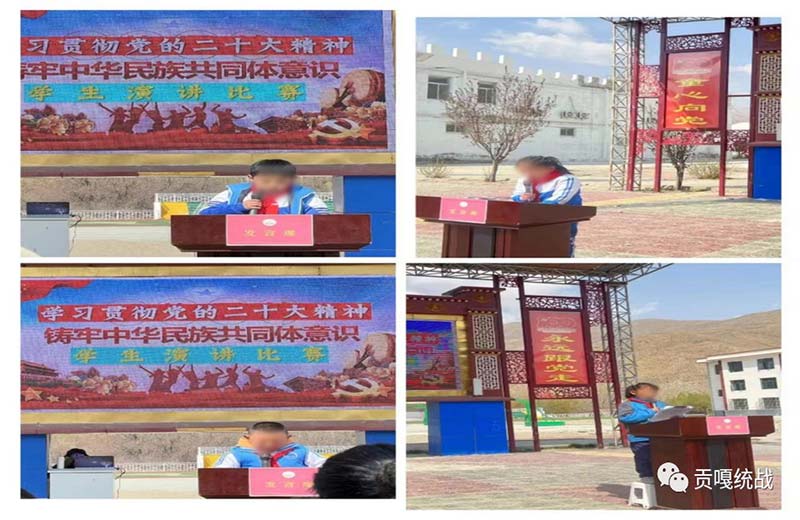
Ideological indoctrination of Namgyal Sholshang Primary School Tibetan children through speech contest on “Building a Consciousness of the Chinese Nation Community.” April 19, 2023. Source: Gongkar United Front.
- Similarly, Namgyal Sholshang (Langjie Xuexiang) Primary School, also located in Gongkar, held a speech contest on April 19, 2023, with the theme of “Building a Consciousness of the Chinese Nation Community” to cultivate students’ loyalty to the Communist Party. The children were required to express their loyalty to China as part of their belief in a better future.
- On May 9, 2023, the Tibetan service of the state-run “China National Radio” reported that 32 Tibetan middle school students from Dhingri (Tingri) County in Shigatse (Rikaze) participated in a week-long “patriotic education” tour to Beijing. The tour was jointly organized by the Civil Affairs Department of the Tibet Autonomous Region and the Charity Federation of the Tibet Autonomous Region.
During the tour, the students attended a flag-raising ceremony at Tiananmen Square and visited various places including the National Museum, the China Monetary Museum, Beijing Aeronautics University and the old Palace Museum.
Similar “patriotic educational activities” are planned for Tibetan children from other counties in the Tibet Autonomous Region, according to the report. - On May 5, 2023, the United Front Work Department reported that the Tibetan County Committee of the Communist Youth League and the County Comprehensive Cultural Service Center in Tsona (Cuona), Tibet Autonomous Region, organized a speech competition for 33 contestants from a Tibetan youth group.
Representatives from the Party Propaganda Department, the United Front Work Department, the Youth League Committee, the Women’s Federation, the Education Bureau, and the Cultural Bureau served as judges for the competition, which aimed to test the children’s understanding of the CCP and its policies with a focus on “building a solid awareness of the Chinese nation community.”
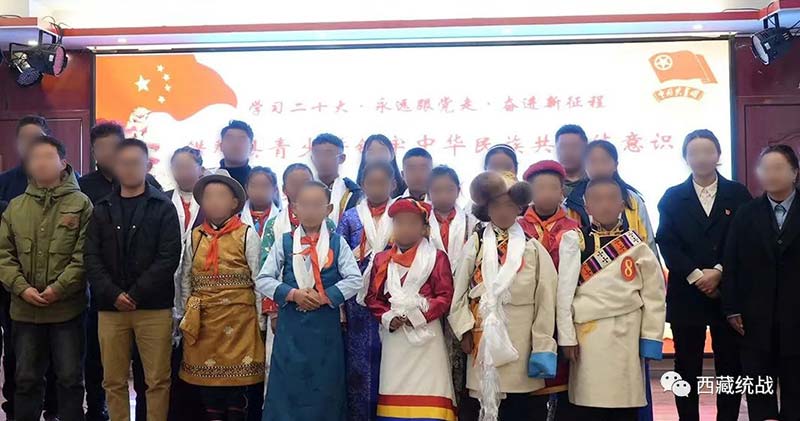
Ideological assimilation of Tibetan children in Tsona (Chinese: Cuona) County, Tibet Autonomous Region, May 9, 2023. Source: The United Front Work Department of Lhoka (Shannan) City, Tsona County
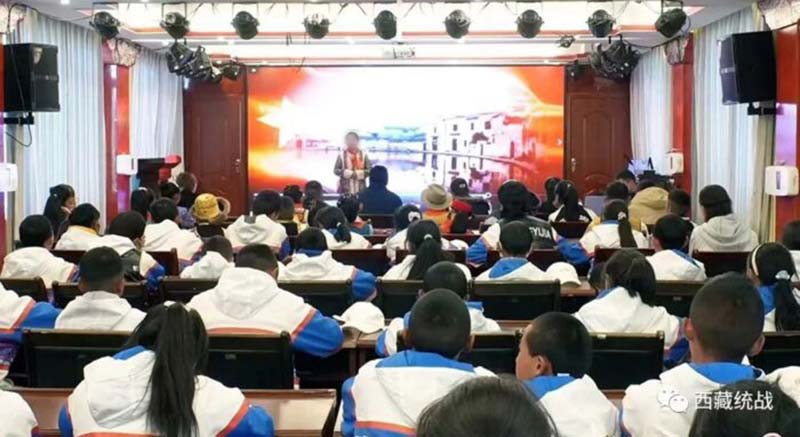
Speech competition to test the Tsona county children on their understanding of the CCP and its policies with an emphasis on “building a solid awareness of the Chinese nation community,” May 9, 2023. Source: The United Front Work Department of Lhoka (Shannan) City, Tsona County
- To coincide with China’s Children’s Day on June 1, 2023, a group of 40 Tibetan children from Yulshul (Yushu), located in the Golog (Guoluo) Tibetan Autonomous Prefecture, were taken on a propaganda tour of Beijing with the aim of instilling loyalty to China and promoting Chinese indoctrination. Pan Yue, the Director of the National Ethnic Affairs Commission, Deputy Minister of the United Front Work Department, and a member of the party’s Central Committee, met with the children at the National Mongolian and Tibetan School in Beijing.
During the meeting, Pan encouraged the Tibetan children not to waste the educational opportunities provided by the party and the country. He urged them to study diligently for the advancement of the Chinese revolution, the construction of a strong nation and China’s rejuvenation. Prior to the meeting with Pan Yue, the children were taken to Tiananmen Square to witness the raising of the Chinese national flag.
The visit to Beijing was jointly organized by the China News Agency, the Yushu Tibetan Autonomous Prefecture People’s Government in Qinghai Province, the relevant departments of the Beijing city government, and the relevant departments of the central government.
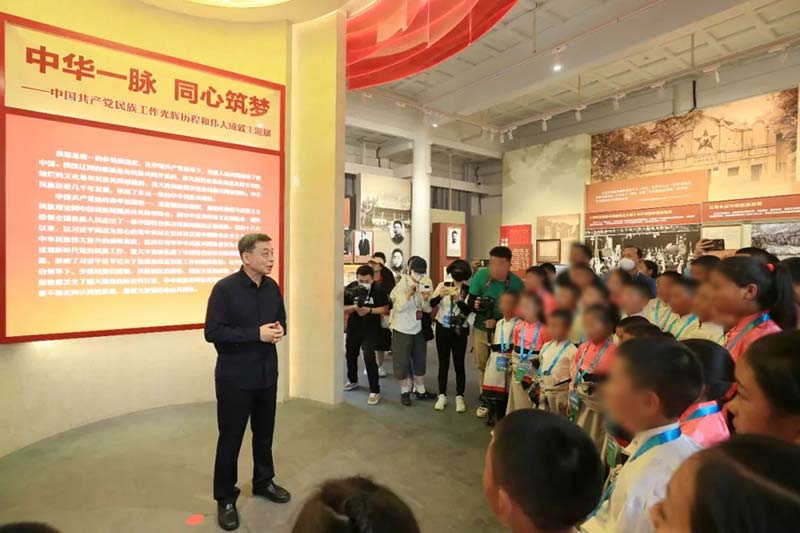
Pan Yue, Secretary of the Party Leadership Group and Director of the National Ethnic Affairs Commission, telling a group of Tibetan children from Yulshul (Yushu) county to learn well for the cause of Chinese revolution and construction of a strong country and China’s rejuvenation.
- On June 13, 2023, the state media outlet Lhasa Daily reported on the Jiangsu Experimental Kindergarten in Lhasa. The kindergarten follows an assimilationist model based on Xi Jinping’s policy of fostering a sense of Chinese national identity. The report states that ethnic unity education is a key focus of the kindergarten, aiming to instill a sense of ethnic unity in Tibetan children from an early age. The kindergarten strives to fulfill its educational mission of “educating people for the party and nurturing talents for the country,” as reported by Lhasa Daily.
The article quotes Dong Shiwen, the director of the Jiangsu Experimental Kindergarten in Lhasa, who mentions that, “General Secretary Xi Jinping has emphasized that strengthening national unity is based on effectively carrying out education on national unity and progress. For a long time, our kindergarten has considered strengthening national unity education as the main objective of cultivating the next generation, which is integrated throughout early childhood education. In the entire teaching process, the consciousness of the Chinese national community can truly be incorporated into textbooks and classrooms, allowing the concept of national unity to permeate the children’s blood and soul. We strive to be at the forefront of creating a model area for national unity and progress.”
These illustrations underscore the persistent endeavors undertaken by the Chinese state to mold the ideological and cultural identities of Tibetan children, aligning them with the values and perspectives espoused by the Communist Party.
SINIFICATION OF TIBETAN CHILDREN
State media in China unabashedly reports on the ongoing process of Sinification of Tibetan children, with the explicit goal of fostering loyalty to the state and advancing Chinese indoctrination. The following are notable examples of recent instances of political indoctrination, as documented and disseminated by state media for domestic consumption.
- According to a report from the “Lhasa Evening News” on May 9, 2023, the Propaganda Department of Taktse (Chinese: Dazi) county organized a group trip for 200 Tibetan middle school students to the “Memorial Hall of the Emancipation of a Million Serfs in Tibet” in Lhasa. The exhibition hall promotes the Chinese Communist Party’s perspective on the events that took place in Lhasa in March 1959.
The report from a state-run newspapers state that the tour guide at the Memorial Hall repeatedly recited propaganda slogans equating gratitude and loyalty to the Communist Party with drinking water. Additionally, the instructor told the children that “Tibet has always been an integral part of the sacred territory of the motherland” and described the old Tibet as being under the rule of feudal serfdom under the influence of both religion and the state. According to the report, the children were left with the impression that “without the CCP, there would be no new socialist Tibet, let alone the happy lives of the Tibetan people today.” - In April 2023, the United Front Work Department, a department of the Central Committee of the Chinese Communist Party responsible for managing potential opposition groups outside the Party, reported that authorities organized a poetry recitation competition on April 23 for Gongkar County Middle School in Lhoka (Shannan) in the Tibet Autonomous Region. The theme of the competition was “National unity and family, building the Chinese dream together.”
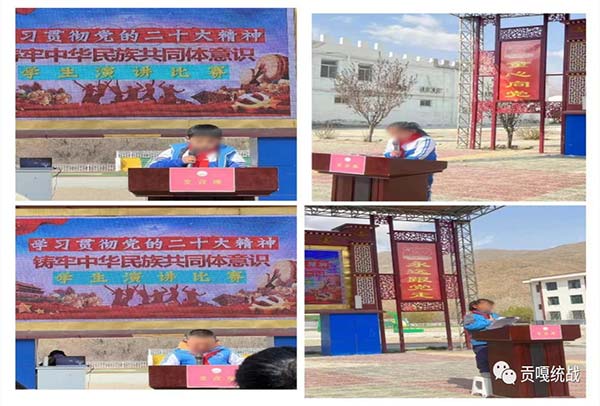
Ideological indoctrination of Namgyal Sholshang Primary School Tibetan children through speech contest on “Building a Consciousness of the Chinese Nation Community.” April 19, 2023. Source: Gongkar United Front.
- Similarly, Namgyal Sholshang (Langjie Xuexiang) Primary School, also located in Gongkar, held a speech contest on April 19, 2023, with the theme of “Building a Consciousness of the Chinese Nation Community” to cultivate students’ loyalty to the Communist Party. The children were required to express their loyalty to China as part of their belief in a better future.
- On May 9, 2023, the Tibetan service of the state-run “China National Radio” reported that 32 Tibetan middle school students from Dhingri (Tingri) County in Shigatse (Rikaze) participated in a week-long “patriotic education” tour to Beijing. The tour was jointly organized by the Civil Affairs Department of the Tibet Autonomous Region and the Charity Federation of the Tibet Autonomous Region.
During the tour, the students attended a flag-raising ceremony at Tiananmen Square and visited various places including the National Museum, the China Monetary Museum, Beijing Aeronautics University and the old Palace Museum.
Similar “patriotic educational activities” are planned for Tibetan children from other counties in the Tibet Autonomous Region, according to the report. - On May 5, 2023, the United Front Work Department reported that the Tibetan County Committee of the Communist Youth League and the County Comprehensive Cultural Service Center in Tsona (Cuona), Tibet Autonomous Region, organized a speech competition for 33 contestants from a Tibetan youth group.
Representatives from the Party Propaganda Department, the United Front Work Department, the Youth League Committee, the Women’s Federation, the Education Bureau, and the Cultural Bureau served as judges for the competition, which aimed to test the children’s understanding of the CCP and its policies with a focus on “building a solid awareness of the Chinese nation community.”
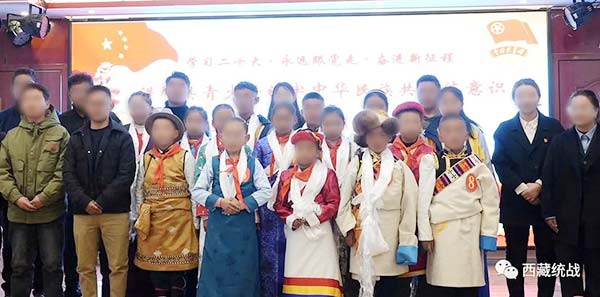
Ideological assimilation of Tibetan children in Tsona (Chinese: Cuona) County, Tibet Autonomous Region, May 9, 2023. Source: The United Front Work Department of Lhoka (Shannan) City, Tsona County
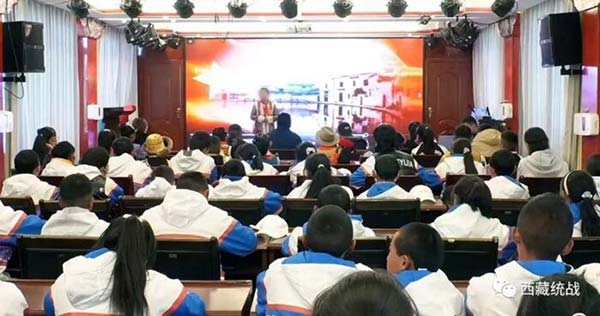
Speech competition to test the Tsona county children on their understanding of the CCP and its policies with an emphasis on “building a solid awareness of the Chinese nation community,” May 9, 2023. Source: The United Front Work Department of Lhoka (Shannan) City, Tsona County
- To coincide with China’s Children’s Day on June 1, 2023, a group of 40 Tibetan children from Yulshul (Yushu), located in the Golog (Guoluo) Tibetan Autonomous Prefecture, were taken on a propaganda tour of Beijing with the aim of instilling loyalty to China and promoting Chinese indoctrination. Pan Yue, the Director of the National Ethnic Affairs Commission, Deputy Minister of the United Front Work Department, and a member of the party’s Central Committee, met with the children at the National Mongolian and Tibetan School in Beijing.
During the meeting, Pan encouraged the Tibetan children not to waste the educational opportunities provided by the party and the country. He urged them to study diligently for the advancement of the Chinese revolution, the construction of a strong nation and China’s rejuvenation. Prior to the meeting with Pan Yue, the children were taken to Tiananmen Square to witness the raising of the Chinese national flag.
The visit to Beijing was jointly organized by the China News Agency, the Yushu Tibetan Autonomous Prefecture People’s Government in Qinghai Province, the relevant departments of the Beijing city government, and the relevant departments of the central government.
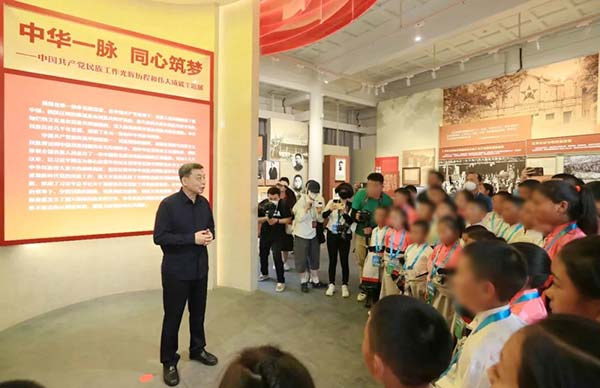
Pan Yue, Secretary of the Party Leadership Group and Director of the National Ethnic Affairs Commission, telling a group of Tibetan children from Yulshul (Yushu) county to learn well for the cause of Chinese revolution and construction of a strong country and China’s rejuvenation.
- On June 13, 2023, the state media outlet Lhasa Daily reported on the Jiangsu Experimental Kindergarten in Lhasa. The kindergarten follows an assimilationist model based on Xi Jinping’s policy of fostering a sense of Chinese national identity. The report states that ethnic unity education is a key focus of the kindergarten, aiming to instill a sense of ethnic unity in Tibetan children from an early age. The kindergarten strives to fulfill its educational mission of “educating people for the party and nurturing talents for the country,” as reported by Lhasa Daily.
The article quotes Dong Shiwen, the director of the Jiangsu Experimental Kindergarten in Lhasa, who mentions that, “General Secretary Xi Jinping has emphasized that strengthening national unity is based on effectively carrying out education on national unity and progress. For a long time, our kindergarten has considered strengthening national unity education as the main objective of cultivating the next generation, which is integrated throughout early childhood education. In the entire teaching process, the consciousness of the Chinese national community can truly be incorporated into textbooks and classrooms, allowing the concept of national unity to permeate the children’s blood and soul. We strive to be at the forefront of creating a model area for national unity and progress.”
These illustrations underscore the persistent endeavors undertaken by the Chinese state to mold the ideological and cultural identities of Tibetan children, aligning them with the values and perspectives espoused by the Communist Party.
SINIFICATION OF RELIGION
The community of religious believers is the pointed target group upon whom Sinification has been declared explicitly and enforced through the party-state apparatus. Religion is at the fault line in the party’s effort to build its political and social legitimacy. Recognizing religious believers as a real social force that the party could not take lightly, Xi Jinping emphasized the adherence to the party’s basic policy for religious work as defined in 2003. The basic policy included the party’s view of what the religious believers can believe as defined by the party, to practice within the bounds of laws regulating their behavior, self-regulation and adapting to the socialist society. Although the first three established the policies and the principles, adapting to the socialist society is the direction and purpose of the policy as proposed by the Central United Front Work Conference in 1993.
Since the party’s adoption of a relatively tolerant view of religion in the post-Mao era to build regime legitimacy, with the conviction that religion will wither away in the process of time, the materialistic trend in China has led to the gradual mushrooming of religious believers beyond the party’s unexpected challenge of maintaining its authority. To check further erosion of its authority and rebuild legitimacy, the party would activate upon the religious community a series of political campaigns demanding them to throw themselves into the great rejuvenation of the Chinese nation being steered by Xi Jinping and the party leadership. Since the party genuinely believes that its vision of a rejuvenated China is predicated upon resolving the problem of local cultural identity to clear the path for the Chinese national identity, Tibetans were foremost in the party-state’s long-term assimilationist drive because of their socio-political identity based on the Tibetan tradition of Buddhism.
Although Buddhism in general is one of the five religions (Buddhism, Daoism, Islam, Catholicism and Protestantism) recognized by the PRC, the party-state continues to hold an antagonistic view of the Tibetan tradition of Buddhism. While the Chinese tradition of Buddhism is held as part of the indigenous Chinese culture, the party-state views Tibetan Buddhism as a deviant needing guidance from the party-defined “fine traditional Chinese culture.” Xi Jinping takes great pride in and emphasizes the “fine traditional Chinese culture” as the authentic indigenous Chinese culture. Buddhism, although recognized as a religion of foreign import, is viewed as an indigenous religion in China and part of the traditional Chinese culture. He spoke glowingly of Buddhism in China during a visit to the UNESCO Headquarters in Paris, France on March 27, 2014:
Buddhism originated in ancient India. After it was introduced into China, the religion went through an extended period of integrated development with the indigenous Confucianism and Taoism and finally became the Buddhism with Chinese characteristics … The Chinese people have enriched Buddhism in the light of Chinese culture and developed some special Buddhist thoughts.[45]
While Xi presented a positive view of Buddhism in his UNESCO speech, in comparison, the reality on the ground differed significantly. Chinese Buddhists, who form the vast majority of the estimated 185 to 250 million Buddhist faithful (according to Freedom House), also faced hardships under Xi’s Sinification policy for not complying with party orders.[46] Far worse treatment is given to the Tibetan Buddhists, as they are viewed as needing harmonization to serve the interests of the party-state rather than liberation of minds. The strategy to accomplish domestication of Tibetan Buddhism is to methodically assimilate it toward developing “consciousness of the community of the Chinese nation” in order to “contribute to the realization of the Chinese dream of national rejuvenation.”[47]
Harmonization of Tibetan Buddhism was strongly signaled during President Xi’s visit to Tibet on July 22, 2021. Speaking to a group of monks at the Drepung Monastery in Lhasa, Xi had said:
The law of the development of religion lies in “harmony”. The survival and development of any religion must be adapted to the society in which it is located. This is the universal law of the development and spread of religions in the world. Religions must be harmonious, and society must be harmonious. The nation must be in harmony.[48]
Xi’s exhortation echoed the position that the party-state maintained for a long time as stated in the State Council’s 1997 “White Paper on Freedom of Religious Belief in China.” But adaptation of religion would be implemented with a much greater force during Xi’s leadership than any other Chinese leaders’ in the post-Mao era. While on the surface, “adapting to the society in which it is located” seemingly means adaptation to Tibetan society, in fact it means adaptation to a Chinese society in the Chinese nation-state. That is the crux of the party-state’s Sinification of Tibetan believers.
Sinification entered Chinese political discourse after the Central United Front Work Conference in 2015. The term was officially sanctioned when President Xi Jinping at the conference spoke of
Actively guiding religion to adapt to the socialist society and must adhere to the direction of sinification. Historically, the adaptation of religion to the society in which it is located is the trend and law of the survival and development of religion. We must use the core socialist values to guide and infiltrate various religions in our country with Chinese culture.[49]
Recognizing religious work as a “mass work,” Xi directed religions to be Sinified. He also laid down the plan to enhance the party’s grip and control on the religious community, building the party’s support base in the religious community and research work to fuse religious philosophy to that of Marxist philosophy on religion. All these plans unfolded in substance in later party-initiated conferences on various topics relevant to religion. Xi’s instructions at the conference were in fact based on the five basic characteristics of religion that the United Front Work Department identified and formalized in the late 1950s and reiterated in 1989. The United Front Work Department then recognized the five basic characteristics of religion as the long-term character of religion, its mass base, national and international aspects, and complexity.[50] In reaffirming religious work as a “mass work,” Xi signaled that Sinification of religions would be a long-term process in controlling hundreds of millions of believers, with the fundamental criterion for evaluating its effectiveness being the masses of religious believers rallying behind the party and the government.
In January 2016, China formally launched an online database of CCP-approved Tibetan Buddhist reincarnations, officially designated as “authentic Living Buddhas” of Tibetan Buddhism, listing names and descriptions of 870 such individuals. “Living Buddha” is the term adopted by the Chinese to refer to reincarnated beings. The Dalai Lama is not included in this database. The online platform was a clear effort by the CCP to assert control over the Dalai Lama’s reincarnation and Tibetan Buddhist institutions and practices. The legal groundwork for this initiative was already laid down in 2007 with the issuance of Order No. 5, titled “Management measures for the reincarnation of living Buddhas in Tibetan Buddhism,” aimed at undermining and supplanting the Tibetan Buddhist religious hierarchy and diminishing the authority of legitimate Tibetan religious leaders.
Sinification was further substantiated at The National Religious Work Conference in April 2016 with the goal to reassert the party’s “guiding” role in religious affairs. Dissatisfied with the then prevailing state of religious affairs, President Xi Jinping chaired the conference, making him the party general secretary chairing the meeting 15 years after Jiang Zemin chaired it in 2001.[51] Xi elaborated what Sinification entails when he spoke of:
Actively guiding religions to adapt to the socialist society is to guide religious believers to love the motherland and the people, maintain the unity of the motherland, maintain the unity of the Chinese nation, obey and serve the highest interests of the country and the overall interests of the Chinese nation; support the leadership of the Communist Party of China and support the socialist system. Adhere to the socialist system with Chinese characteristics; actively practice the core values of socialism, promote Chinese culture and strive to integrate religious teachings with Chinese culture, abide by national laws and regulations, and consciously accept state management in accordance with the law. Dedicated to reforming and opening up and socialist modernization and contribute to the realization of the Chinese dream of the great rejuvenation of the Chinese nation.[52]
At the Central United Front Work Conference in 2015, Xi Jinping emphasized the importance of religious figures taking an active role in guiding religious believers and promoting the adaptation of religion to a socialist society. This would result in the formulation of the “Four Standards” campaign and deployment of it in the Tibetan monastic community to train monks and nuns to become “politically reliable, religiously accomplished, convincing in morals and effective at critical times.”[53] The monastic community in the Tibet Autonomous Region and those in the Tibetan-inhabited areas outside the TAR were subjected to the mechanism led by the United Front Work Department beginning in 2018. The campaign continues to be rolled forward as directed by Xi Jinping at the latest National Religious Work Conference in December 2021.[54]
Through the “four standards” mechanism, the UFWD cadres “reeducate” the Tibetan monastic community to hold “Chinese national consciousness” and compliance with the party-state’s laws and policies governing religious affairs. For instance, the Ngari (Ali) UFWD meeting on May 10, 2020 required strict enforcement of the party’s policy on religious work and regulations governing religious affairs in the monasteries. The meeting emphasized the monastic community’s need to develop consciousness as Chinese nationals and have consciousness only for the country and its laws. This in effect means to make the Tibetan monastics Chinese in the Chinese nation-state.
The “four standards” campaign aims to produce talents in the religious community to speak for the party’s vision of a modern socialist state. Because the Tibetan Buddhist teachers are influential in shaping Tibetan society, as they are held in high esteem, efforts are underway to manufacture talents who can steer the society by persuading the masses to shun Tibetan identity in favor of a Chinese identity for the “great rejuvenation of the Chinese nation.” The China-selected Panchen Lama, Gyaltsen Norbu, regularly amplifies the Sinification of Tibetan Buddhism. At the 11th Council of the TAR branch of the Chinese Buddhist Association in Shigatse on Oct. 13, 2020, he read a speech stating that
…a new navigation mark has been established and a new journey has begun. We must keep in mind the entrustment, be grateful and forge ahead, and demonstrate new responsibilities in promoting the Sinicization of Tibetan Buddhism … Fully carry forward the fine tradition of safeguarding the unity of the motherland and strengthening national unity, promote the “five identities”, and unswervingly adhere to the Sinicization of Tibetan Buddhism. Improve the long-term mechanism of temple management, promote the adaptation of Tibetan Buddhism to socialist society, play its own positive role, and strive to contribute to promoting high-quality development and keeping the bottom line of ecological security. With the practical actions of grasping the four major issues of stability, development, ecology, and strengthening the border, we will make new and greater contributions to the construction of a united, prosperous, civilized, harmonious, and beautiful socialist modernized Tibet, and to the realization of the Chinese dream of the great rejuvenation of the Chinese nation.[55]
Emphasizing that Sinification of Tibetan Buddhism is a systematic approach, the then-Party Secretary of the Tibet Autonomous Region, Wu Yingje, most clearly outlined how the party expects the monastic community to comply with its policy.[56] Speaking at the Forum of Representatives of Religious Circles in the TAR on Dec. 30, 2020, Wu called for denunciation of the Dalai Lama and “ resolutely draw[ing] a clear line with the Dalai clique.” The monastics were told to publicize the state law on reincarnation of Tibetan Buddhist religious leaders. Secondly, he instructed them to “build a strong sense of community for the Chinese nation. Love national unity as you love your own eyes and protect national unity as you protect your own life.” Third, the monastics were expected to feel gratitude for the Communist Party and to drive the believers to support the leadership of the party. Fourth, the monastics are instructed to comply with Xi Jinping’s thoughts on socialism with Chinese characteristics in the new era and to explain and make it clear that Tibetan Buddhist culture is an integral part of Chinese culture. And finally, Wu, as the then-party secretary of the TAR, instructs the monastic community to abide by the laws and regulations on religion affairs. He orders that the monastics “must assist the party and government to guide religious believers to establish a new style of civilization.”
In the party-state structure, Tibetan party members also play a vital role in penetrating the party’s policy on Sinification of Buddhism at the local level. In the words of Xi Jinping at the Central Ethnic Work Conference in September 2014, “To do a good job in ethnic work, ethnic minority cadres are important bridges and bonds. Let them deal with lot of the matters for us because they are more likely to be accepted by ethnic minorities; they will show up at critical moments, and the effect will be better.”[57] Holding concurrent titles as a member of the Standing Committee of the Party Committee of Tibet Autonomous Region, Secretary of the Lhasa City Party Committee, leader of the city’s Party Committee’s Religious Work Leading Group, Tibetan party member Pema Wangdue’s instructions to the religious community reflect the successful fruition of Mr. Xi’s expectations.
Propagating to the representatives of religious circles in Lhasa on Nov. 6, 2020 regarding the Seventh Tibet Work Forum, Pema repeats verbatim a certain portion of Xi Jinping’s speech delivered five years ago at the Central United Front Work Conference. Besides promoting sycophancy to the party by feeling “gratitude to the party,” Pema lays a strong emphasis on the religious community and leading the believers.
“Build a strong sense of the Chinese nation community … to strengthen the recognition of the great motherland, the Chinese nation, Chinese culture, the Communist Party of China, and socialism with Chinese characteristics … to fully understand that Tibetan Buddhism must consciously identify with Chinese politics, consciously integrate into Chinese culture.”
Framing it in terms of progressive language, he instructs the eminent monks to
“make interpretations of the teachings and rules of Tibetan Buddhism in line with the requirements of the progress of the times and make every effort to help Tibetan Buddhism to always move in the direction of sinification. Let Chinese culture always be the emotional bond and spiritual belonging of all ethnic groups in Tibet, make the idea that Tibetan ethnic culture is an inseparable part of Chinese culture deeply rooted in the heart, and promote exchanges and integration of all ethnic groups.”[58]
Sinification of religions was reiterated during the last National Conference on Religious Work held in Beijing between Dec. 3-4, 2021. The central leadership reflected on the achievements of the party’s religious work and expounded new notions and strategies to achieve the goal. Lauding the progress in religious work since the 18th CCP National Congress in 2012, Xi expressed his satisfaction at the effectiveness of Sinification of religions. Signifying that his vision is a work in progress, Xi stressed the implementation of the top-level design for Sinification by further entrenching the religious work system, mechanisms and construction of a religious affairs governance structure involving the party, government, social coordination, and regulations. Toward that, Xi called for cultivating “three teams” for religious work by forming a team of party and government cadres, a team of religious talent who have undergone the “four standards” campaign and a religious research team to innovate and strengthen the discipline construction of Marxist religious studies.
SINIFICATION OF RELIGION
The community of religious believers is the pointed target group upon whom Sinification has been declared explicitly and enforced through the party-state apparatus. Religion is at the fault line in the party’s effort to build its political and social legitimacy. Recognizing religious believers as a real social force that the party could not take lightly, Xi Jinping emphasized the adherence to the party’s basic policy for religious work as defined in 2003. The basic policy included the party’s view of what the religious believers can believe as defined by the party, to practice within the bounds of laws regulating their behavior, self-regulation and adapting to the socialist society. Although the first three established the policies and the principles, adapting to the socialist society is the direction and purpose of the policy as proposed by the Central United Front Work Conference in 1993.
Since the party’s adoption of a relatively tolerant view of religion in the post-Mao era to build regime legitimacy, with the conviction that religion will wither away in the process of time, the materialistic trend in China has led to the gradual mushrooming of religious believers beyond the party’s unexpected challenge of maintaining its authority. To check further erosion of its authority and rebuild legitimacy, the party would activate upon the religious community a series of political campaigns demanding them to throw themselves into the great rejuvenation of the Chinese nation being steered by Xi Jinping and the party leadership. Since the party genuinely believes that its vision of a rejuvenated China is predicated upon resolving the problem of local cultural identity to clear the path for the Chinese national identity, Tibetans were foremost in the party-state’s long-term assimilationist drive because of their socio-political identity based on the Tibetan tradition of Buddhism.
Although Buddhism in general is one of the five religions (Buddhism, Daoism, Islam, Catholicism and Protestantism) recognized by the PRC, the party-state continues to hold an antagonistic view of the Tibetan tradition of Buddhism. While the Chinese tradition of Buddhism is held as part of the indigenous Chinese culture, the party-state views Tibetan Buddhism as a deviant needing guidance from the party-defined “fine traditional Chinese culture.” Xi Jinping takes great pride in and emphasizes the “fine traditional Chinese culture” as the authentic indigenous Chinese culture. Buddhism, although recognized as a religion of foreign import, is viewed as an indigenous religion in China and part of the traditional Chinese culture. He spoke glowingly of Buddhism in China during a visit to the UNESCO Headquarters in Paris, France on March 27, 2014:
Buddhism originated in ancient India. After it was introduced into China, the religion went through an extended period of integrated development with the indigenous Confucianism and Taoism and finally became the Buddhism with Chinese characteristics … The Chinese people have enriched Buddhism in the light of Chinese culture and developed some special Buddhist thoughts.[45]
While Xi presented a positive view of Buddhism in his UNESCO speech, in comparison, the reality on the ground differed significantly. Chinese Buddhists, who form the vast majority of the estimated 185 to 250 million Buddhist faithful (according to Freedom House), also faced hardships under Xi’s Sinification policy for not complying with party orders.[46] Far worse treatment is given to the Tibetan Buddhists, as they are viewed as needing harmonization to serve the interests of the party-state rather than liberation of minds. The strategy to accomplish domestication of Tibetan Buddhism is to methodically assimilate it toward developing “consciousness of the community of the Chinese nation” in order to “contribute to the realization of the Chinese dream of national rejuvenation.”[47]
Harmonization of Tibetan Buddhism was strongly signaled during President Xi’s visit to Tibet on July 22, 2021. Speaking to a group of monks at the Drepung Monastery in Lhasa, Xi had said:
The law of the development of religion lies in “harmony”. The survival and development of any religion must be adapted to the society in which it is located. This is the universal law of the development and spread of religions in the world. Religions must be harmonious, and society must be harmonious. The nation must be in harmony.[48]
Xi’s exhortation echoed the position that the party-state maintained for a long time as stated in the State Council’s 1997 “White Paper on Freedom of Religious Belief in China.” But adaptation of religion would be implemented with a much greater force during Xi’s leadership than any other Chinese leaders’ in the post-Mao era. While on the surface, “adapting to the society in which it is located” seemingly means adaptation to Tibetan society, in fact it means adaptation to a Chinese society in the Chinese nation-state. That is the crux of the party-state’s Sinification of Tibetan believers.
Sinification entered Chinese political discourse after the Central United Front Work Conference in 2015. The term was officially sanctioned when President Xi Jinping at the conference spoke of
Actively guiding religion to adapt to the socialist society and must adhere to the direction of sinification. Historically, the adaptation of religion to the society in which it is located is the trend and law of the survival and development of religion. We must use the core socialist values to guide and infiltrate various religions in our country with Chinese culture.[49]
Recognizing religious work as a “mass work,” Xi directed religions to be Sinified. He also laid down the plan to enhance the party’s grip and control on the religious community, building the party’s support base in the religious community and research work to fuse religious philosophy to that of Marxist philosophy on religion. All these plans unfolded in substance in later party-initiated conferences on various topics relevant to religion. Xi’s instructions at the conference were in fact based on the five basic characteristics of religion that the United Front Work Department identified and formalized in the late 1950s and reiterated in 1989. The United Front Work Department then recognized the five basic characteristics of religion as the long-term character of religion, its mass base, national and international aspects, and complexity.[50] In reaffirming religious work as a “mass work,” Xi signaled that Sinification of religions would be a long-term process in controlling hundreds of millions of believers, with the fundamental criterion for evaluating its effectiveness being the masses of religious believers rallying behind the party and the government.
In January 2016, China formally launched an online database of CCP-approved Tibetan Buddhist reincarnations, officially designated as “authentic Living Buddhas” of Tibetan Buddhism, listing names and descriptions of 870 such individuals. “Living Buddha” is the term adopted by the Chinese to refer to reincarnated beings. The Dalai Lama is not included in this database. The online platform was a clear effort by the CCP to assert control over the Dalai Lama’s reincarnation and Tibetan Buddhist institutions and practices. The legal groundwork for this initiative was already laid down in 2007 with the issuance of Order No. 5, titled “Management measures for the reincarnation of living Buddhas in Tibetan Buddhism,” aimed at undermining and supplanting the Tibetan Buddhist religious hierarchy and diminishing the authority of legitimate Tibetan religious leaders.
Sinification was further substantiated at The National Religious Work Conference in April 2016 with the goal to reassert the party’s “guiding” role in religious affairs. Dissatisfied with the then prevailing state of religious affairs, President Xi Jinping chaired the conference, making him the party general secretary chairing the meeting 15 years after Jiang Zemin chaired it in 2001.[51] Xi elaborated what Sinification entails when he spoke of:
Actively guiding religions to adapt to the socialist society is to guide religious believers to love the motherland and the people, maintain the unity of the motherland, maintain the unity of the Chinese nation, obey and serve the highest interests of the country and the overall interests of the Chinese nation; support the leadership of the Communist Party of China and support the socialist system. Adhere to the socialist system with Chinese characteristics; actively practice the core values of socialism, promote Chinese culture and strive to integrate religious teachings with Chinese culture, abide by national laws and regulations, and consciously accept state management in accordance with the law. Dedicated to reforming and opening up and socialist modernization and contribute to the realization of the Chinese dream of the great rejuvenation of the Chinese nation.[52]
At the Central United Front Work Conference in 2015, Xi Jinping emphasized the importance of religious figures taking an active role in guiding religious believers and promoting the adaptation of religion to a socialist society. This would result in the formulation of the “Four Standards” campaign and deployment of it in the Tibetan monastic community to train monks and nuns to become “politically reliable, religiously accomplished, convincing in morals and effective at critical times.”[53] The monastic community in the Tibet Autonomous Region and those in the Tibetan-inhabited areas outside the TAR were subjected to the mechanism led by the United Front Work Department beginning in 2018. The campaign continues to be rolled forward as directed by Xi Jinping at the latest National Religious Work Conference in December 2021.[54]
Through the “four standards” mechanism, the UFWD cadres “reeducate” the Tibetan monastic community to hold “Chinese national consciousness” and compliance with the party-state’s laws and policies governing religious affairs. For instance, the Ngari (Ali) UFWD meeting on May 10, 2020 required strict enforcement of the party’s policy on religious work and regulations governing religious affairs in the monasteries. The meeting emphasized the monastic community’s need to develop consciousness as Chinese nationals and have consciousness only for the country and its laws. This in effect means to make the Tibetan monastics Chinese in the Chinese nation-state.
The “four standards” campaign aims to produce talents in the religious community to speak for the party’s vision of a modern socialist state. Because the Tibetan Buddhist teachers are influential in shaping Tibetan society, as they are held in high esteem, efforts are underway to manufacture talents who can steer the society by persuading the masses to shun Tibetan identity in favor of a Chinese identity for the “great rejuvenation of the Chinese nation.” The China-selected Panchen Lama, Gyaltsen Norbu, regularly amplifies the Sinification of Tibetan Buddhism. At the 11th Council of the TAR branch of the Chinese Buddhist Association in Shigatse on Oct. 13, 2020, he read a speech stating that
…a new navigation mark has been established and a new journey has begun. We must keep in mind the entrustment, be grateful and forge ahead, and demonstrate new responsibilities in promoting the Sinicization of Tibetan Buddhism … Fully carry forward the fine tradition of safeguarding the unity of the motherland and strengthening national unity, promote the “five identities”, and unswervingly adhere to the Sinicization of Tibetan Buddhism. Improve the long-term mechanism of temple management, promote the adaptation of Tibetan Buddhism to socialist society, play its own positive role, and strive to contribute to promoting high-quality development and keeping the bottom line of ecological security. With the practical actions of grasping the four major issues of stability, development, ecology, and strengthening the border, we will make new and greater contributions to the construction of a united, prosperous, civilized, harmonious, and beautiful socialist modernized Tibet, and to the realization of the Chinese dream of the great rejuvenation of the Chinese nation.[55]
Emphasizing that Sinification of Tibetan Buddhism is a systematic approach, the then-Party Secretary of the Tibet Autonomous Region, Wu Yingje, most clearly outlined how the party expects the monastic community to comply with its policy.[56] Speaking at the Forum of Representatives of Religious Circles in the TAR on Dec. 30, 2020, Wu called for denunciation of the Dalai Lama and “ resolutely draw[ing] a clear line with the Dalai clique.” The monastics were told to publicize the state law on reincarnation of Tibetan Buddhist religious leaders. Secondly, he instructed them to “build a strong sense of community for the Chinese nation. Love national unity as you love your own eyes and protect national unity as you protect your own life.” Third, the monastics were expected to feel gratitude for the Communist Party and to drive the believers to support the leadership of the party. Fourth, the monastics are instructed to comply with Xi Jinping’s thoughts on socialism with Chinese characteristics in the new era and to explain and make it clear that Tibetan Buddhist culture is an integral part of Chinese culture. And finally, Wu, as the then-party secretary of the TAR, instructs the monastic community to abide by the laws and regulations on religion affairs. He orders that the monastics “must assist the party and government to guide religious believers to establish a new style of civilization.”
In the party-state structure, Tibetan party members also play a vital role in penetrating the party’s policy on Sinification of Buddhism at the local level. In the words of Xi Jinping at the Central Ethnic Work Conference in September 2014, “To do a good job in ethnic work, ethnic minority cadres are important bridges and bonds. Let them deal with lot of the matters for us because they are more likely to be accepted by ethnic minorities; they will show up at critical moments, and the effect will be better.”[57] Holding concurrent titles as a member of the Standing Committee of the Party Committee of Tibet Autonomous Region, Secretary of the Lhasa City Party Committee, leader of the city’s Party Committee’s Religious Work Leading Group, Tibetan party member Pema Wangdue’s instructions to the religious community reflect the successful fruition of Mr. Xi’s expectations.
Propagating to the representatives of religious circles in Lhasa on Nov. 6, 2020 regarding the Seventh Tibet Work Forum, Pema repeats verbatim a certain portion of Xi Jinping’s speech delivered five years ago at the Central United Front Work Conference. Besides promoting sycophancy to the party by feeling “gratitude to the party,” Pema lays a strong emphasis on the religious community and leading the believers.
“Build a strong sense of the Chinese nation community … to strengthen the recognition of the great motherland, the Chinese nation, Chinese culture, the Communist Party of China, and socialism with Chinese characteristics … to fully understand that Tibetan Buddhism must consciously identify with Chinese politics, consciously integrate into Chinese culture.”
Framing it in terms of progressive language, he instructs the eminent monks to
“make interpretations of the teachings and rules of Tibetan Buddhism in line with the requirements of the progress of the times and make every effort to help Tibetan Buddhism to always move in the direction of sinification. Let Chinese culture always be the emotional bond and spiritual belonging of all ethnic groups in Tibet, make the idea that Tibetan ethnic culture is an inseparable part of Chinese culture deeply rooted in the heart, and promote exchanges and integration of all ethnic groups.”[58]
Sinification of religions was reiterated during the last National Conference on Religious Work held in Beijing between Dec. 3-4, 2021. The central leadership reflected on the achievements of the party’s religious work and expounded new notions and strategies to achieve the goal. Lauding the progress in religious work since the 18th CCP National Congress in 2012, Xi expressed his satisfaction at the effectiveness of Sinification of religions. Signifying that his vision is a work in progress, Xi stressed the implementation of the top-level design for Sinification by further entrenching the religious work system, mechanisms and construction of a religious affairs governance structure involving the party, government, social coordination, and regulations. Toward that, Xi called for cultivating “three teams” for religious work by forming a team of party and government cadres, a team of religious talent who have undergone the “four standards” campaign and a religious research team to innovate and strengthen the discipline construction of Marxist religious studies.
THREE CONSCIOUSNESS CAMPAIGN
In mid-2022, under Wang Junzheng, the Party Secretary of the TAR, the “Three Consciousness” campaign was launched per Xi Jinping’s instructions on Tibet work and the party’s strategy for “governing Tibet in the new era.” The campaign involves indoctrinating national consciousness, citizenship consciousness and rule of law consciousness in Tibetan society to “forge the consciousness of the Chinese nation community.”[59]
The “Three Consciousness” is an ongoing campaign in all parts of Tibet with a focus on the monastic community. For instance, a Three Consciousness symposium was held in Kharo (Karuo) county in Chamdo on March 1, 2023 for the monastic community. The representatives of religious circles were instructed to identify themselves as citizens of the People’s Republic of China.[60] Similarly the state-controlled Tibetan Buddhist Academy held a special meeting on March 17, 2023 on “firmly establishing the “Three Consciousness” for Sinification of Tibetan Buddhism for “building a beautiful and happy Tibet and fulfilling the dream of great rejuvenation” of the Chinese nation.
Besides holding regional meetings where representatives of the monastic community are called for “Three Consciousness” education at a designated venue, work teams constantly conduct indoctrinations within monastic venues across Tibet. For example, from April 7-10, 2023, work teams conducted the Three Consciousness indoctrinations in four monasteries (Chagri, Bangar, Changdani and Yaktrab monasteries) in Driru (Biru) County in Nagchu (Naqu) prefectural-level city, where feedback collected from other locations were put to the test to improvise the indoctrination process.[61]
The United Front Work Department of the Chinese Communist Party, entrusted with exerting influence over the monastic community, remains steadfast in implementing the “three consciousness” campaign in Tibetan monastic institutions across Tibet. Numerous recent instances in 2023 continue to shed light on the initiatives undertaken by the United Front Work Department within Tibetan monastic venues and communities.
- On April 13, a “Three Consciousness” promotion meeting took place in Nyingtri (Linzhi) City, focusing on enhancing “Three Consciousness” education within the religious community. The meeting outlined various requirements, including aligning the education with the spirit of the 20th National Congress of the Party, implementing the responsibilities of the “Three Consciousnesses,” intensifying preaching efforts, innovating the methods of activities, strengthening supervision and assessment, and exploring the establishment of regulations and systems to consolidate achievements in religious work governance.
- On April 17, a meeting to promote the “Three Consciousness” was held in Gyatsa (Jiacha) County, presided over by the minister of the United Front Work Department. The meeting discussed the progress of “Three Consciousness” education and Chinese language training, identified issues and shortcomings, and planned future steps. The emphasis was on promoting uniform thinking to foster loyalty to China through “Three Consciousness” education.
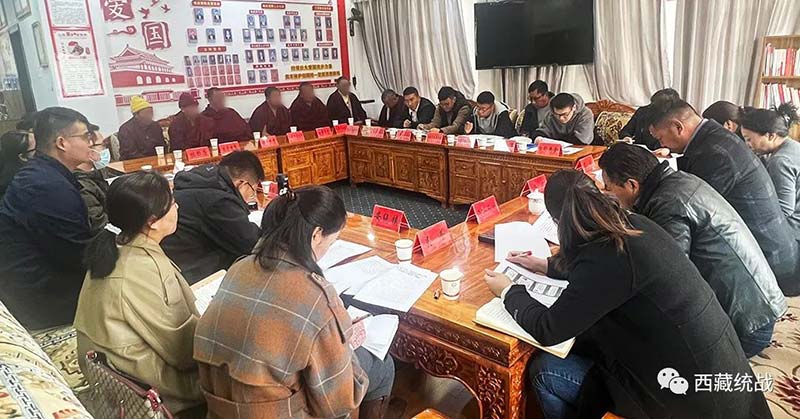
“Three Consciousness” education meeting in progress in Gyatsa (Jiacha) County, Lhoka (Shannan) prefecture-level city, April 20, 2023. Source: United Front Work Department of Jiacha County Party Committee, Shannan City
- The “Three Consciousness” Education Office of the United Front Work Department conducted a work assessment of “Three Consciousness” education in eight monastery-based institutions in Kongpo Gyamda County from April 17 to 18. The assessment evaluated various aspects of educational work, including organization and leadership, publicity and education, seminars and exchanges, guidance, information submission and atmosphere creation. The assessment aimed to provide a foundation for advancing the “three consciousnesses” education in the religious circle.
- The United Front religious departments in Lhasa City organized a knowledge test for “Three Consciousness” education from April 11 to 13, assessing the understanding of the monastic community. The test enabled the cadres to identify shortcomings and provided a basis for future publicity work.
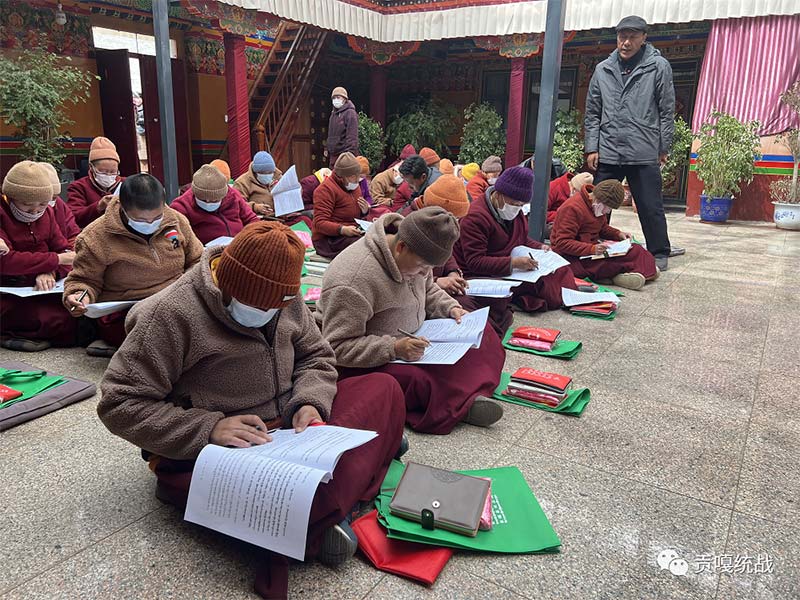
On the spot examination in progress to test the monastics knowledge of “Three Consciousness” ideology in Chilchung Kagyur Nunnery in Gongkar(Gongga) county, Lhoka (Shannan) prefecture-level city. Source: Gongkar United Front. March 20, 2023.
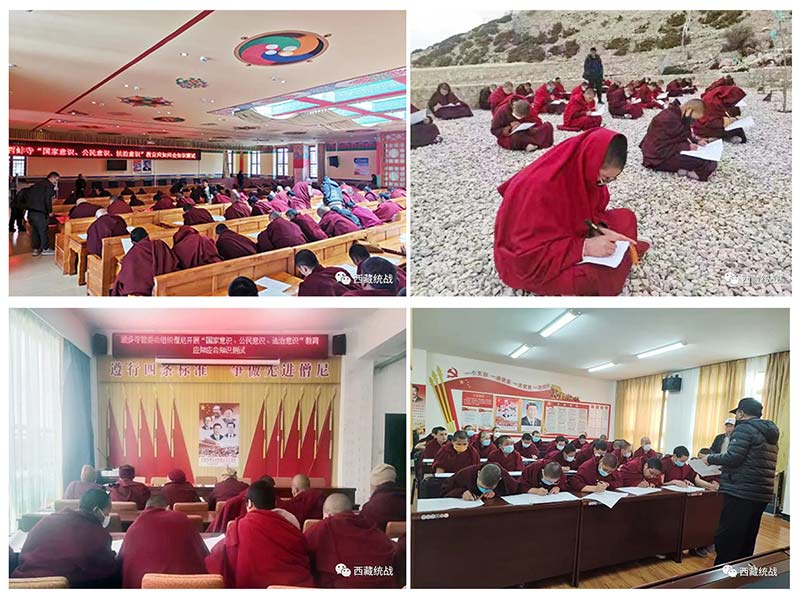
“Three Consciousness” knowledge examination in progress in various monastic venues in Lhasa City conducted by United Front Work Department of Lhasa Municipal Party Committee between April 11-13.
- “Three Consciousness” ideological indoctrination was launched at Rongbu Rabten Monastery in Sog County, Nagchu on Feb. 27, “educating” over 120 monks and nuns on the CCP’s policies and speeches related to religious work, ethnic affairs and Tibet. The “Three Consciousness” encompasses political consciousness, national consciousness and social consciousness.
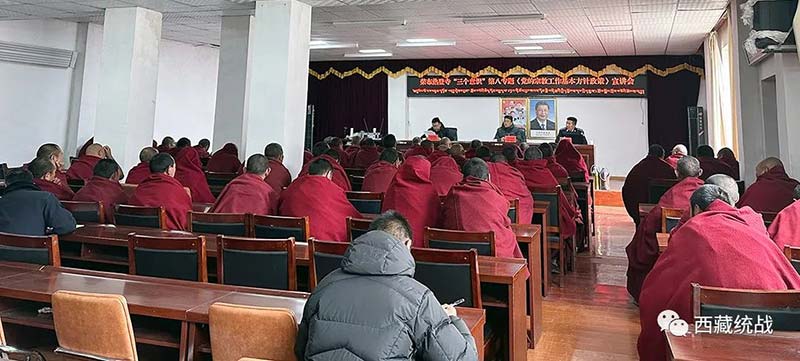
“Three Consciousness” ideological indoctrination session in progress at Rongbu Monastery in Sog (Suo) county, Nagchu (Naqu) prefecture-level city, Feb. 27, 2023. Source: United Front Work Department of Suo County Party Committee, Naqu City
- A symposium in Karuo county, Chamdo on the development of “Three Consciousness” activities in religious circles was held on March 1. The importance of consolidating and expanding the achievements of the activities was emphasized, aiming to promote “healthy development” in the religious field. Representatives of religious circles were instructed to identify themselves as citizens of the People’s Republic of China and to contribute to national unity and progress.
- As part of the “Propaganda of Legal Popularization in Religious Activities Sites” campaign, the United Front Work Department and the County Judicial Bureau conducted a political and legal indoctrination session for nuns at Chilchung Kagyur (Jiqiong Gajiulakang) nunnery in Gongkar county, Lhoka, on March 20. The session emphasized that the state and national law hold greater importance than religious law, and citizens supersede religious individuals. The indoctrination included studying the Chinese Constitution, Regulations on Religious Affairs, the “Three Consciousness” and regulations related to ethnic unity and progress in Tibet.
Since the project to build consciousness of the Chinese national community was launched, the party has gathered plenty of data and experience to take it to the next level. To coordinate and integrate various party and government organs to learn from past experiences to assimilate the Tibetan people in accordance with the party’s political theories, a new Research Center for the Consciousness of the Chinese National Community was established in the Academy of Social Sciences of the Tibet Autonomous Region on March 21, 2023.[62]
Thus, the project to assimilate Tibetans into the Chinese nation-state through Sinification persists.
THREE CONSCIOUSNESS CAMPAIGN
In mid-2022, under Wang Junzheng, the Party Secretary of the TAR, the “Three Consciousness” campaign was launched per Xi Jinping’s instructions on Tibet work and the party’s strategy for “governing Tibet in the new era.” The campaign involves indoctrinating national consciousness, citizenship consciousness and rule of law consciousness in Tibetan society to “forge the consciousness of the Chinese nation community.”[59]
The “Three Consciousness” is an ongoing campaign in all parts of Tibet with a focus on the monastic community. For instance, a Three Consciousness symposium was held in Kharo (Karuo) county in Chamdo on March 1, 2023 for the monastic community. The representatives of religious circles were instructed to identify themselves as citizens of the People’s Republic of China.[60] Similarly the state-controlled Tibetan Buddhist Academy held a special meeting on March 17, 2023 on “firmly establishing the “Three Consciousness” for Sinification of Tibetan Buddhism for “building a beautiful and happy Tibet and fulfilling the dream of great rejuvenation” of the Chinese nation.
Besides holding regional meetings where representatives of the monastic community are called for “Three Consciousness” education at a designated venue, work teams constantly conduct indoctrinations within monastic venues across Tibet. For example, from April 7-10, 2023, work teams conducted the Three Consciousness indoctrinations in four monasteries (Chagri, Bangar, Changdani and Yaktrab monasteries) in Driru (Biru) County in Nagchu (Naqu) prefectural-level city, where feedback collected from other locations were put to the test to improvise the indoctrination process.[61]
The United Front Work Department of the Chinese Communist Party, entrusted with exerting influence over the monastic community, remains steadfast in implementing the “three consciousness” campaign in Tibetan monastic institutions across Tibet. Numerous recent instances in 2023 continue to shed light on the initiatives undertaken by the United Front Work Department within Tibetan monastic venues and communities.
- On April 13, a “Three Consciousness” promotion meeting took place in Nyingtri (Linzhi) City, focusing on enhancing “Three Consciousness” education within the religious community. The meeting outlined various requirements, including aligning the education with the spirit of the 20th National Congress of the Party, implementing the responsibilities of the “Three Consciousnesses,” intensifying preaching efforts, innovating the methods of activities, strengthening supervision and assessment, and exploring the establishment of regulations and systems to consolidate achievements in religious work governance.
- On April 17, a meeting to promote the “Three Consciousness” was held in Gyatsa (Jiacha) County, presided over by the minister of the United Front Work Department. The meeting discussed the progress of “Three Consciousness” education and Chinese language training, identified issues and shortcomings, and planned future steps. The emphasis was on promoting uniform thinking to foster loyalty to China through “Three Consciousness” education.
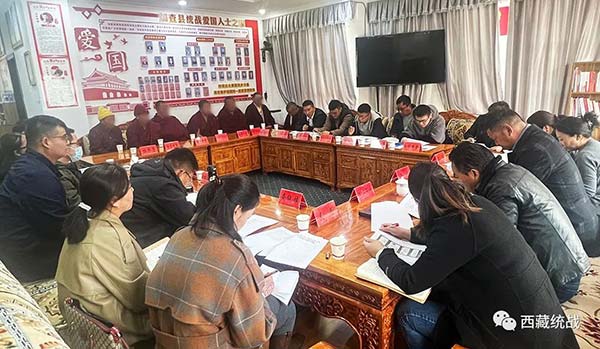
“Three Consciousness” education meeting in progress in Gyatsa (Jiacha) County, Lhoka (Shannan) prefecture-level city, April 20, 2023. Source: United Front Work Department of Jiacha County Party Committee, Shannan City
- The “Three Consciousness” Education Office of the United Front Work Department conducted a work assessment of “Three Consciousness” education in eight monastery-based institutions in Kongpo Gyamda County from April 17 to 18. The assessment evaluated various aspects of educational work, including organization and leadership, publicity and education, seminars and exchanges, guidance, information submission and atmosphere creation. The assessment aimed to provide a foundation for advancing the “three consciousnesses” education in the religious circle.
- The United Front religious departments in Lhasa City organized a knowledge test for “Three Consciousness” education from April 11 to 13, assessing the understanding of the monastic community. The test enabled the cadres to identify shortcomings and provided a basis for future publicity work.
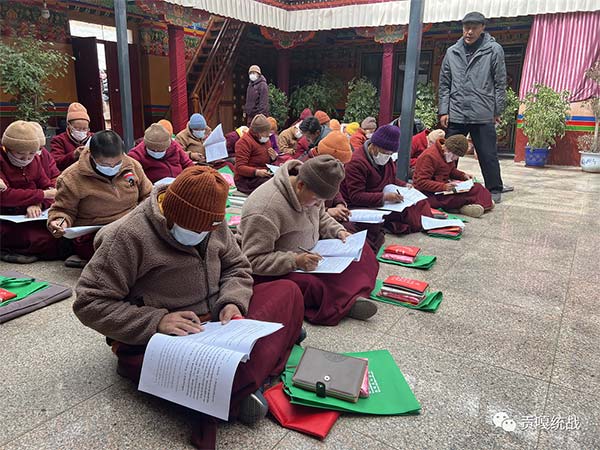
On the spot examination in progress to test the monastics knowledge of “Three Consciousness” ideology in Chilchung Kagyur Nunnery in Gongkar(Gongga) county, Lhoka (Shannan) prefecture-level city. Source: Gongkar United Front. March 20, 2023.
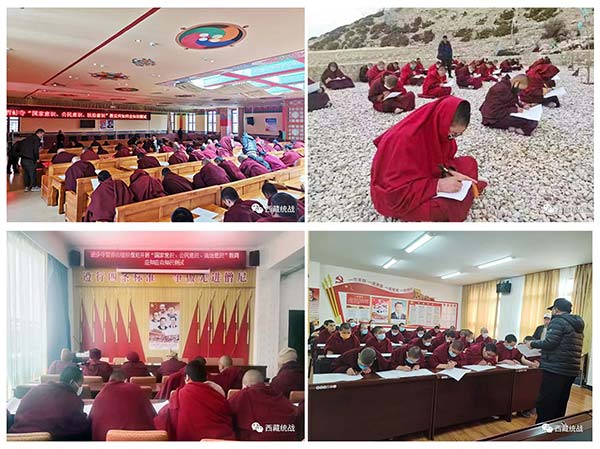
“Three Consciousness” knowledge examination in progress in various monastic venues in Lhasa City conducted by United Front Work Department of Lhasa Municipal Party Committee between April 11-13.
- “Three Consciousness” ideological indoctrination was launched at Rongbu Rabten Monastery in Sog County, Nagchu on Feb. 27, “educating” over 120 monks and nuns on the CCP’s policies and speeches related to religious work, ethnic affairs and Tibet. The “Three Consciousness” encompasses political consciousness, national consciousness and social consciousness.
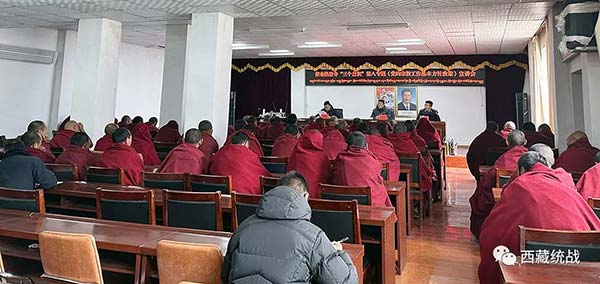
“Three Consciousness” ideological indoctrination session in progress at Rongbu Monastery in Sog (Suo) county, Nagchu (Naqu) prefecture-level city, Feb. 27, 2023. Source: United Front Work Department of Suo County Party Committee, Naqu City
- A symposium in Karuo county, Chamdo on the development of “Three Consciousness” activities in religious circles was held on March 1. The importance of consolidating and expanding the achievements of the activities was emphasized, aiming to promote “healthy development” in the religious field. Representatives of religious circles were instructed to identify themselves as citizens of the People’s Republic of China and to contribute to national unity and progress.
- As part of the “Propaganda of Legal Popularization in Religious Activities Sites” campaign, the United Front Work Department and the County Judicial Bureau conducted a political and legal indoctrination session for nuns at Chilchung Kagyur (Jiqiong Gajiulakang) nunnery in Gongkar county, Lhoka, on March 20. The session emphasized that the state and national law hold greater importance than religious law, and citizens supersede religious individuals. The indoctrination included studying the Chinese Constitution, Regulations on Religious Affairs, the “Three Consciousness” and regulations related to ethnic unity and progress in Tibet.
Since the project to build consciousness of the Chinese national community was launched, the party has gathered plenty of data and experience to take it to the next level. To coordinate and integrate various party and government organs to learn from past experiences to assimilate the Tibetan people in accordance with the party’s political theories, a new Research Center for the Consciousness of the Chinese National Community was established in the Academy of Social Sciences of the Tibet Autonomous Region on March 21, 2023.[62]
Thus, the project to assimilate Tibetans into the Chinese nation-state through Sinification persists.
NATIONAL SECURITIZATION OF TIBET AND TIBETANS
Since the complete occupation of Tibet in 1959, China has maintained two primary policy planks in Tibet over the decades of its rule: development and security. With changes in Chinese leadership in Beijing, and depending on who has greater sway between the hardliners and the globalists, the policy focus on development and security sways in terms of priority in Tibet.
While the decades of Mao Zedong’s rule were extremely destructive in China, the period between the end of Mao’s rule and the rise of Xi Jinping saw a different type of control. With the ascendency of Xi Jinping, his primary focus became political security of the CCP, articulated in the politico-legal language of national security of China.
The focus on security is clear in terms of the increasing frequency of the term in Xi Jinping’s political work reports to the CCP national congresses. Comparing the two work reports he delivered to the congresses, the frequency of the term “security” increased almost 50% in his work report to the 20th Party Congress in 2022 compared to the 19th Congress in 2017. The term “security” appears 80 and 43 times in the 20th and 19th Party Congresses respectively. Similarly, the frequency of the term “national security” increased to 29 from 14 in the 20th and 19th Party Congresses respectively.
This rise in the frequency of the term “security” reflects the CCP’s revision of its priorities and weighing development and security interests equally. The CCP’s internal debate between 2014-2019 over whether the development-first policy over security should be continued or not has ended. Since 2020, the CCP has embraced an integrated development and security approach, and it is no longer a “development first” approach.[63]
Xi Jinping’s turn toward all-encompassing national security since the third plenum of the 18th Party Congress in 2013 impacts everyone’s life in all corners of China, but the lives of subjugated minority peoples like the Tibetans and Uyghurs who are under extra scrutiny become even worse. Compared to the dominant Han Chinese in the Chinese heartland, Tibetans living in occupied Tibet have always faced a worse situation in Tibet than the Han Chinese due to the Chinese party-state’s justification of repression by projecting Tibetans as “separatists” or “secessionists.”
With Xi Jinping’s casting of the CCP’s political security as national security, the evolution of the Xi Jinping-led party-state now frames Tibet and Tibetans as a national security issue of China. National security of China is in fact a euphemism for regime security of the CCP, which is politically articulated as political security of the CCP. Clearing the confusion and misinterpretation of national security of China, Sheena Chestnut Greitens of the University of Texas states, “Chinese writings call political security the ‘foundation’ of national security, and they define political security as ‘safeguard[ing] the party’s leadership, the socialist system, and the authority of the Central Committee with Xi Jinping as the core.’”[64]
NATIONAL SECURITIZATION OF TIBET AND TIBETANS
Since the complete occupation of Tibet in 1959, China has maintained two primary policy planks in Tibet over the decades of its rule: development and security. With changes in Chinese leadership in Beijing, and depending on who has greater sway between the hardliners and the globalists, the policy focus on development and security sways in terms of priority in Tibet.
While the decades of Mao Zedong’s rule were extremely destructive in China, the period between the end of Mao’s rule and the rise of Xi Jinping saw a different type of control. With the ascendency of Xi Jinping, his primary focus became political security of the CCP, articulated in the politico-legal language of national security of China.
The focus on security is clear in terms of the increasing frequency of the term in Xi Jinping’s political work reports to the CCP national congresses. Comparing the two work reports he delivered to the congresses, the frequency of the term “security” increased almost 50% in his work report to the 20th Party Congress in 2022 compared to the 19th Congress in 2017. The term “security” appears 80 and 43 times in the 20th and 19th Party Congresses respectively. Similarly, the frequency of the term “national security” increased to 29 from 14 in the 20th and 19th Party Congresses respectively.
This rise in the frequency of the term “security” reflects the CCP’s revision of its priorities and weighing development and security interests equally. The CCP’s internal debate between 2014-2019 over whether the development-first policy over security should be continued or not has ended. Since 2020, the CCP has embraced an integrated development and security approach, and it is no longer a “development first” approach.[63]
Xi Jinping’s turn toward all-encompassing national security since the third plenum of the 18th Party Congress in 2013 impacts everyone’s life in all corners of China, but the lives of subjugated minority peoples like the Tibetans and Uyghurs who are under extra scrutiny become even worse. Compared to the dominant Han Chinese in the Chinese heartland, Tibetans living in occupied Tibet have always faced a worse situation in Tibet than the Han Chinese due to the Chinese party-state’s justification of repression by projecting Tibetans as “separatists” or “secessionists.”
With Xi Jinping’s casting of the CCP’s political security as national security, the evolution of the Xi Jinping-led party-state now frames Tibet and Tibetans as a national security issue of China. National security of China is in fact a euphemism for regime security of the CCP, which is politically articulated as political security of the CCP. Clearing the confusion and misinterpretation of national security of China, Sheena Chestnut Greitens of the University of Texas states, “Chinese writings call political security the ‘foundation’ of national security, and they define political security as ‘safeguard[ing] the party’s leadership, the socialist system, and the authority of the Central Committee with Xi Jinping as the core.’”[64]
EVOLUTION OF XI JINPING’S NATIONAL SECURITY CONCEPT
The defining feature of Xi Jinping’s rule is the national securitization of China. Xi’s firm and steady national securitization of China with the CCP overseeing national security affairs has led to China turning from a party-state to a national-security-party-state, according to Tai Ming Cheung, a professor at University of California, San Diego specializing in Chinese and East Asian defense and national security affairs.[65]
The first indication of Xi Jinping’s overhauling of China’s state security system was a brief mention of national security matters in the communique of the Third Plenum of the Eighteenth Party Congress in November 2013, which was followed by the public unveiling of a “comprehensive national security concept” in April 2014. With the unveiling of the overarching conceptual framework, the Central National Security Commission was launched for overseeing implementation across the party-state, and national security-related regulations, laws and strategies were subsequently passed.[66] The commission not only exists at the central level but also down to the local level to ensure implementation up and down China’s political system. China’s first national security strategy was issued in 2015.
EVOLUTION OF XI JINPING’S NATIONAL SECURITY CONCEPT
The defining feature of Xi Jinping’s rule is the national securitization of China. Xi’s firm and steady national securitization of China with the CCP overseeing national security affairs has led to China turning from a party-state to a national-security-party-state, according to Tai Ming Cheung, a professor at University of California, San Diego specializing in Chinese and East Asian defense and national security affairs.[65]
The first indication of Xi Jinping’s overhauling of China’s state security system was a brief mention of national security matters in the communique of the Third Plenum of the Eighteenth Party Congress in November 2013, which was followed by the public unveiling of a “comprehensive national security concept” in April 2014. With the unveiling of the overarching conceptual framework, the Central National Security Commission was launched for overseeing implementation across the party-state, and national security-related regulations, laws and strategies were subsequently passed.[66] The commission not only exists at the central level but also down to the local level to ensure implementation up and down China’s political system. China’s first national security strategy was issued in 2015.
GRAVITY OF NATIONAL SECURITY
Although Xi Jinping’s national securitization of China in terms of external implementation is highly debated in the global arena, there is an emerging consensus that the gravity of Xi’s national securitization is tilted prominently inward. Examining the discourse in China’s National Security Commission meetings, internal security matters have a much more prominent role.[67] According to Greitens, “China’s conception of national security has a much more prominent role for internal security questions, and the center of gravity for national security work is explicitly internal. Therefore, most CNSC meetings have involved in internal matters….” Pointing out that Xi’s national security thinking is focused internally, Tai Ming Cheung states, “Based on Xi’s reconceptualization of national security, the most dangerous threats are not external but internal, not traditional but non-traditional, not geo-strategic but political, and not in the here and now but emerging.”
Since Tibet from the earliest days of occupation has been perceived as an issue of sovereignty and security by the CCP, Xi’s implementation of a broad national security policy is not entirely unheard of in Tibet by the Tibetans. Tibetan freedom and rights activists were indicted under the revised Criminal Law of the People’s Republic of China in 1997 under the penal codes on “Crimes of Endangering National Security.” However, Xi’s “Overall National Security Concept” has further aggravated the situation of the Tibetans, as the implementation now involves everything in their lives from political, economy, development, culture and environment, etc. While Tibetans are no strangers to Chinese leaders and the system’s implementation of national security, Xi’s version of national security is even more problematic, as the new highly expansionist political-ideological construct behind the new national security concept means that any activity they undertake can be perceived as a threat to China’s sovereignty with no space for genuine expression of grievances without landing in detention centers or being marked as a potential “secessionist.”
GRAVITY OF NATIONAL SECURITY
Although Xi Jinping’s national securitization of China in terms of external implementation is highly debated in the global arena, there is an emerging consensus that the gravity of Xi’s national securitization is tilted prominently inward. Examining the discourse in China’s National Security Commission meetings, internal security matters have a much more prominent role.[67] According to Greitens, “China’s conception of national security has a much more prominent role for internal security questions, and the center of gravity for national security work is explicitly internal. Therefore, most CNSC meetings have involved in internal matters….” Pointing out that Xi’s national security thinking is focused internally, Tai Ming Cheung states, “Based on Xi’s reconceptualization of national security, the most dangerous threats are not external but internal, not traditional but non-traditional, not geo-strategic but political, and not in the here and now but emerging.”
Since Tibet from the earliest days of occupation has been perceived as an issue of sovereignty and security by the CCP, Xi’s implementation of a broad national security policy is not entirely unheard of in Tibet by the Tibetans. Tibetan freedom and rights activists were indicted under the revised Criminal Law of the People’s Republic of China in 1997 under the penal codes on “Crimes of Endangering National Security.” However, Xi’s “Overall National Security Concept” has further aggravated the situation of the Tibetans, as the implementation now involves everything in their lives from political, economy, development, culture and environment, etc. While Tibetans are no strangers to Chinese leaders and the system’s implementation of national security, Xi’s version of national security is even more problematic, as the new highly expansionist political-ideological construct behind the new national security concept means that any activity they undertake can be perceived as a threat to China’s sovereignty with no space for genuine expression of grievances without landing in detention centers or being marked as a potential “secessionist.”
SHIFT TO PREEMPTION FROM REACTIVITY
National security under Xi Jinping comprises of 16 domains of security for the survival and longevity of the CCP. It covers political security, territorial security, economic security, military security, cultural security, societal security, science and technology security, cyber security, resource security, ecological security, nuclear security, space security, overseas interest security, biosecurity, polar security and deep sea security. The 16 types of security are broadly categorized into traditional and non-traditional security.
Xi Jinping’s concept of “comprehensive national security” is not without foundations as he builds upon the works of his predecessors since the establishment of the People’s Republic of China. Despite the continuity in change, Xi’s shifted its focus from traditional to non-traditional security. While Mao was focused on territorial and military security; two foremost domains of traditional security, Deng Xiaoping and Jiang Zemin held economic security as the priority, whereas Hu Jintao introduced and focused on ecological and resource security.[68] While past Chinese leaders prioritized traditional security, Xi Jinping focused on non-traditional security covering internal and emerging threats.
Unlike the past leaders’ focus, which was broadly external in orientation, Xi’s internal orientation threat perception has led to a preemptive prevent and control approach versus the reactive approach of the past. Xi’s preemptive approach of prevention and control method of quashing emerging threats has moved away from the past Chinese leaders’ policy prescription of “stability maintenance.”[69] The prevention and control approach to perceived internal threats has led to more repression for the minority peoples like Tibetans and Uyghurs.
SHIFT TO PREEMPTION FROM REACTIVITY
National security under Xi Jinping comprises of 16 domains of security for the survival and longevity of the CCP. It covers political security, territorial security, economic security, military security, cultural security, societal security, science and technology security, cyber security, resource security, ecological security, nuclear security, space security, overseas interest security, biosecurity, polar security and deep sea security. The 16 types of security are broadly categorized into traditional and non-traditional security.
Xi Jinping’s concept of “comprehensive national security” is not without foundations as he builds upon the works of his predecessors since the establishment of the People’s Republic of China. Despite the continuity in change, Xi’s shifted its focus from traditional to non-traditional security. While Mao was focused on territorial and military security; two foremost domains of traditional security, Deng Xiaoping and Jiang Zemin held economic security as the priority, whereas Hu Jintao introduced and focused on ecological and resource security.[68] While past Chinese leaders prioritized traditional security, Xi Jinping focused on non-traditional security covering internal and emerging threats.
Unlike the past leaders’ focus, which was broadly external in orientation, Xi’s internal orientation threat perception has led to a preemptive prevent and control approach versus the reactive approach of the past. Xi’s preemptive approach of prevention and control method of quashing emerging threats has moved away from the past Chinese leaders’ policy prescription of “stability maintenance.”[69] The prevention and control approach to perceived internal threats has led to more repression for the minority peoples like Tibetans and Uyghurs.
MEANS TO PREVENTION AND THE CONTROL METHOD IN TIBET
The leak of China’s internal Document No. 9 in 2013 revealed that the CCP rejects foreign ideas infiltrating China. Based on the CCP’s earlier conclusion of foreign ideological infiltration leading to the degeneration of communism worldwide since the end of the 1980s, the CCP perceives that foreign ideals will lead to a weakening of the CCP’s ideological supremacy, control on thoughts of population and subversion of its rule. Document No.9 as one of the cornerstones of Xi Jinping’s ideology reflects the new thinking on “minorities” leading to ultra-securitization in Tibet as a concrete result of this ideology.
In Tibet, the CCP’s perception of Tibetan rights and freedom activism as foreign instigation has a long record prior to the ascendency of Xi Jinping. But under Xi’s administration, that threat perception has shot up even higher, leading to the conversion of Tibet as a black box for outside observers to forestall rights criticism by foreign governments, NGOs and journalists as interference in China’s internal matter.
In tandem with the denial of access to Tibet for rights violations investigation, Xi’s administration doubled down on repression inside Tibet by intensifying its security policy, leveraging advances in modern information and biotechnology.
MEANS TO PREVENTION AND THE CONTROL METHOD IN TIBET
The leak of China’s internal Document No. 9 in 2013 revealed that the CCP rejects foreign ideas infiltrating China. Based on the CCP’s earlier conclusion of foreign ideological infiltration leading to the degeneration of communism worldwide since the end of the 1980s, the CCP perceives that foreign ideals will lead to a weakening of the CCP’s ideological supremacy, control on thoughts of population and subversion of its rule. Document No.9 as one of the cornerstones of Xi Jinping’s ideology reflects the new thinking on “minorities” leading to ultra-securitization in Tibet as a concrete result of this ideology.
In Tibet, the CCP’s perception of Tibetan rights and freedom activism as foreign instigation has a long record prior to the ascendency of Xi Jinping. But under Xi’s administration, that threat perception has shot up even higher, leading to the conversion of Tibet as a black box for outside observers to forestall rights criticism by foreign governments, NGOs and journalists as interference in China’s internal matter.
In tandem with the denial of access to Tibet for rights violations investigation, Xi’s administration doubled down on repression inside Tibet by intensifying its security policy, leveraging advances in modern information and biotechnology.
SURVEILLANCE
China is a surveillance state. Sinologists Jessica Batke and Mareike Ohlberg’s research on the state of surveillance in China, analyzing 76,000 surveillance technology procurement documents, concludes that while the technology and the conceptual framework is the same across China, the scale and purpose of deployment varies from location to location.[70] Unlike the Chinese heartland where dissidents and potential criminals are the object of surveillance, all members of a particular “ethnic” or religious group are targeted for their “ethnic” or religious affiliation. This is true to the Tibetan experience simply due to their distinct identity and the socio-political historical context under which Tibetans became “ethnic” minorities under Beijing’s rule.
There is wide latitude for local authorities to decide the type of surveillance technology, and the scale of deployment according to the Chinese authority’s threat perception. While local authorities in the Chinese heartland perceive threats primarily in terms of Chinese demands for wealth and better standard of living, Chinese authorities in Tibet perceive the entire Tibetan population as a “separatist” threat to China’s sovereignty; a threat perception manufactured and sustained by the CCP despite the Dalai Lama’s almost four-decade-old conflict resolution proposal accepting China’s sovereignty in exchange for implementation of genuine autonomy in Tibet and for the Tibetan people. Therefore, unlike the deployment of surveillance technology in Chinese heartland cities, the scale of deployment pervades the daily life of Tibetans. The object of the scale of deployment is clear. It is to project the infallibility of the CCP and its omnipresence and omniscience due to its surveillance technology prowess.
While the past reactive security policies via the multiagency juggernaut “stability maintenance” for achieving “long-term stability” in Tibet through policing, internet censorship, blacklisting individuals, surveillance technology, grid management etc. continue to prevail, Xi Jinping’s focus on political security of the CCP as China’s national security has shifted the paradigm to the preemptive prevention and control model for security in Tibet. Analyzing the party-state’s security budget, Greitens of the University of Texas concludes that, “Much of the increase [in the security budget] has been for surveillance technology and data integration tools to facilitate the aim of early warning and ‘prevention and control.’”[71] Through the mix of facial recognition and artificial intelligence technology, genome surveillance on top of the prevailing technology, the object of surveillance under Xi Jinping’s national-security party-state is to preempt any challenge to his and the CCP’s rule irrespective of the merit of the grievances expressed.
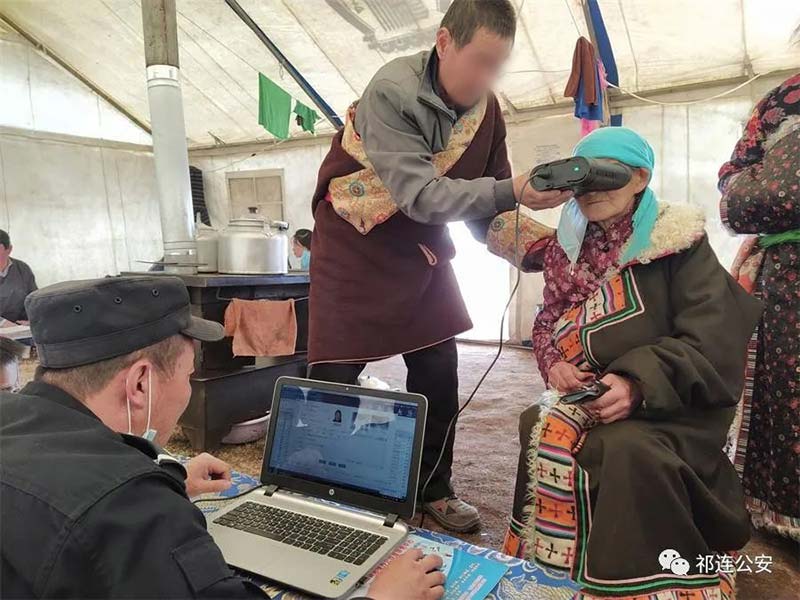
Dola (Qilian) County’s Muri (Mole) Township police scanning iris of an elderly Tibetan woman. Source: The Paper, Qilian County, April 22, 2020, via The Citizen Lab
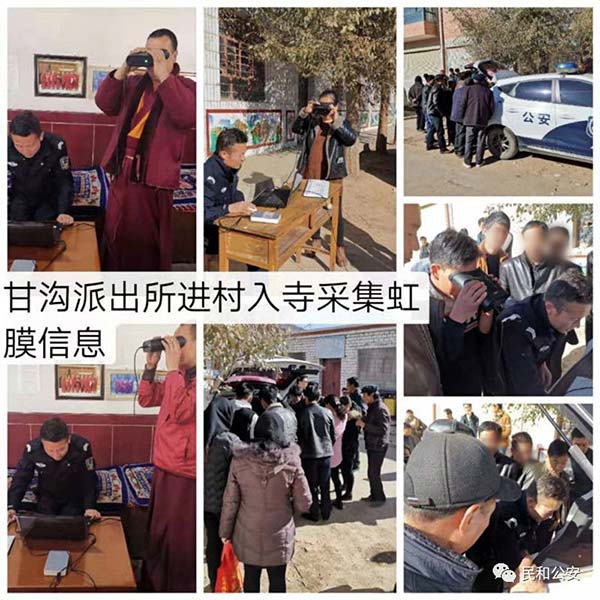
Police media collage depicting iris collection drive in Kamalok (Minhe) County in Tsoshar (Haidong) prefecture-level city. State media brag that Kamalok County Public Security Bureau has collected a total of 308,000 iris information as of December 31, 2019 with a 70% iris collection rate. Source: Kamalok Public Security Bureau, January 5, 2020, via The Citizen Lab
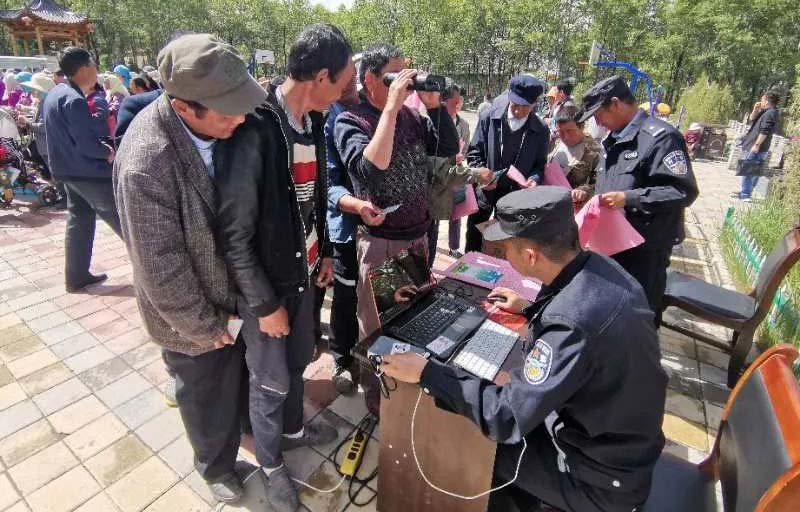
State media reported that Danma and Sangdo (Songduo) police stations went deep into the villages and schools under their jurisdiction for “Comprehensive Management and Safety Construction Publicity Month,” June 24, 2020, via The Citizen Lab
SURVEILLANCE
China is a surveillance state. Sinologists Jessica Batke and Mareike Ohlberg’s research on the state of surveillance in China, analyzing 76,000 surveillance technology procurement documents, concludes that while the technology and the conceptual framework is the same across China, the scale and purpose of deployment varies from location to location.[70] Unlike the Chinese heartland where dissidents and potential criminals are the object of surveillance, all members of a particular “ethnic” or religious group are targeted for their “ethnic” or religious affiliation. This is true to the Tibetan experience simply due to their distinct identity and the socio-political historical context under which Tibetans became “ethnic” minorities under Beijing’s rule.
There is wide latitude for local authorities to decide the type of surveillance technology, and the scale of deployment according to the Chinese authority’s threat perception. While local authorities in the Chinese heartland perceive threats primarily in terms of Chinese demands for wealth and better standard of living, Chinese authorities in Tibet perceive the entire Tibetan population as a “separatist” threat to China’s sovereignty; a threat perception manufactured and sustained by the CCP despite the Dalai Lama’s almost four-decade-old conflict resolution proposal accepting China’s sovereignty in exchange for implementation of genuine autonomy in Tibet and for the Tibetan people. Therefore, unlike the deployment of surveillance technology in Chinese heartland cities, the scale of deployment pervades the daily life of Tibetans. The object of the scale of deployment is clear. It is to project the infallibility of the CCP and its omnipresence and omniscience due to its surveillance technology prowess.
While the past reactive security policies via the multiagency juggernaut “stability maintenance” for achieving “long-term stability” in Tibet through policing, internet censorship, blacklisting individuals, surveillance technology, grid management etc. continue to prevail, Xi Jinping’s focus on political security of the CCP as China’s national security has shifted the paradigm to the preemptive prevention and control model for security in Tibet. Analyzing the party-state’s security budget, Greitens of the University of Texas concludes that, “Much of the increase [in the security budget] has been for surveillance technology and data integration tools to facilitate the aim of early warning and ‘prevention and control.’”[71] Through the mix of facial recognition and artificial intelligence technology, genome surveillance on top of the prevailing technology, the object of surveillance under Xi Jinping’s national-security party-state is to preempt any challenge to his and the CCP’s rule irrespective of the merit of the grievances expressed.
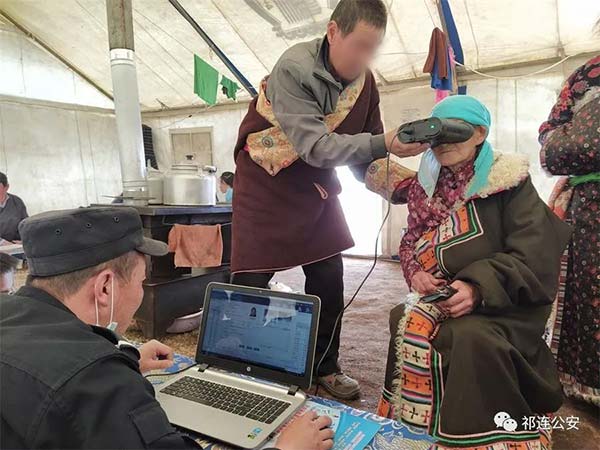
Dola (Qilian) County’s Muri (Mole) Township police scanning iris of an elderly Tibetan woman. Source: The Paper, Qilian County, April 22, 2020, via The Citizen Lab
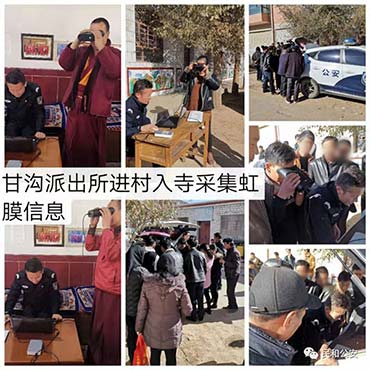
Police media collage depicting iris collection drive in Kamalok (Minhe) County in Tsoshar (Haidong) prefecture-level city. State media brag that Kamalok County Public Security Bureau has collected a total of 308,000 iris information as of December 31, 2019 with a 70% iris collection rate. Source: Kamalok Public Security Bureau, January 5, 2020, via The Citizen Lab
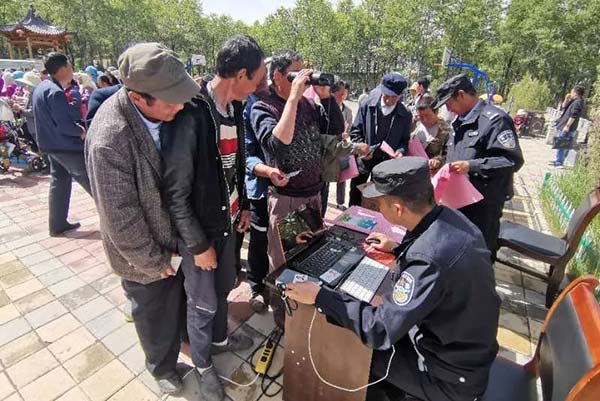
State media reported that Danma and Sangdo (Songduo) police stations went deep into the villages and schools under their jurisdiction for “Comprehensive Management and Safety Construction Publicity Month,” June 24, 2020, via The Citizen Lab
POLICING THE GENOME
Data collection of the population is not unique to Xi Jinping’s administration. With evolutions in technology, the party-state under various leadership in Beijing has taken advantage of the evolving technology in perfecting repression in Tibet and other minority territories. The technological powers of information, surveillance and genome technology have been harnessed by Chinese authorities in Tibet to collect various data of Tibetans. Chinese police have leveraged the information and surveillance technology, although genome technology was formerly leveraged upon by public health authorities. But that changed under Xi Jinping’s administration. Unlike the past sporadic Tibetan DNA harvesting done by public health authorities as early as 2012, “following Xi Jinping’s coming to power, China’s police have begun collecting DNA from entire populations,” according to Emile Dirks of the Munk School of Global Affairs, University of Toronto.[72]
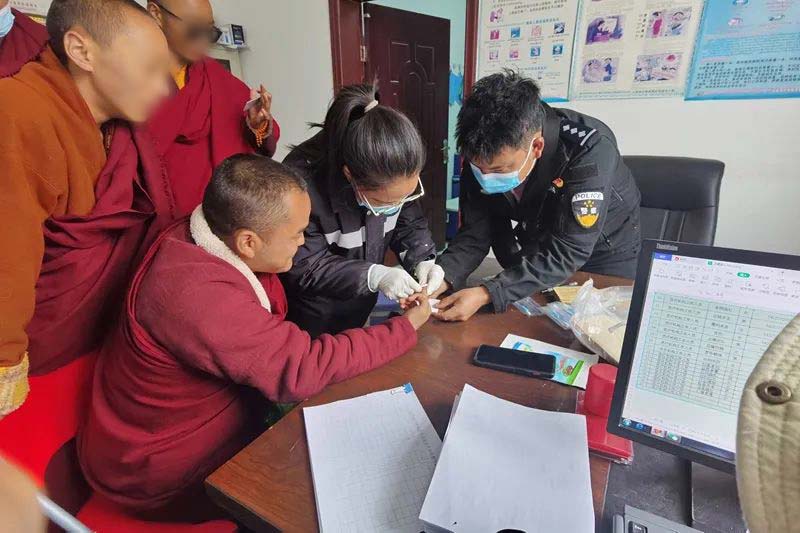
Police taking blood sample from a monk at Ngongha Choede Gon (Talin Qudi Si) in Nakartse (Langkazi) County in Lhoka (Shannan) prefectural-level city. Source: The Paper, June 24, 2020, via The Citizen Lab
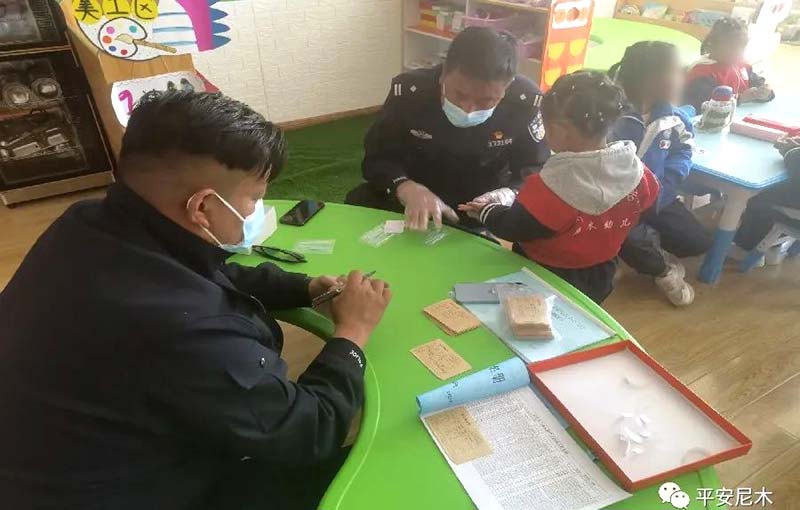
Police DNA collection from a toddler in Nyemo (Nimu) County, Lhasa prefecture-level city, April 22, 2022, via The Citizen Lab
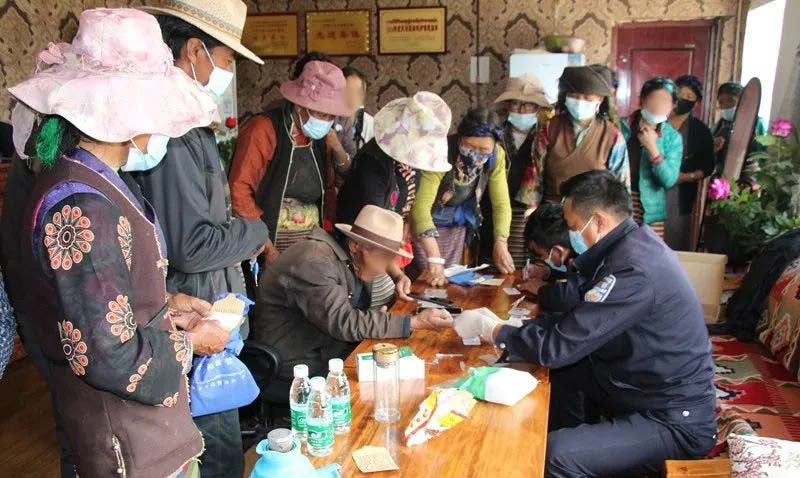
Dramda (Zhangda) Township, Nakartse (Langkazi) County, police collecting blood sample from an elderly Tibetan for DNA collection on August 30, 2021, via The Citizen Lab
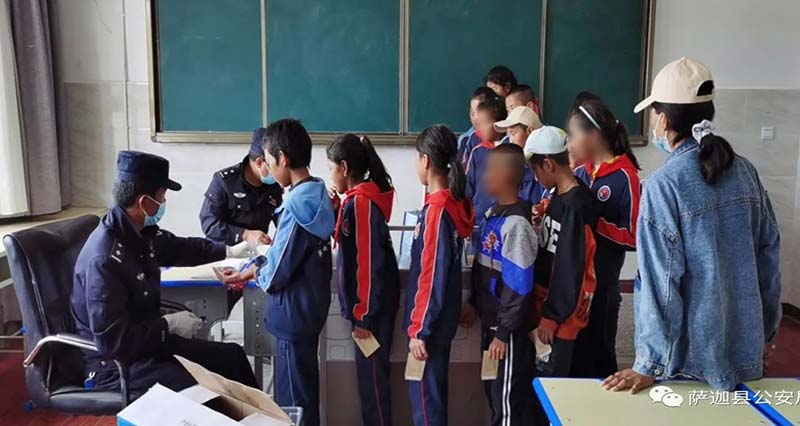
Police take blood sample for DNA collection in Sakya County, Shigatse (Xigaze) prefecture-level city, August 27, 2021, via The Citizen Lab
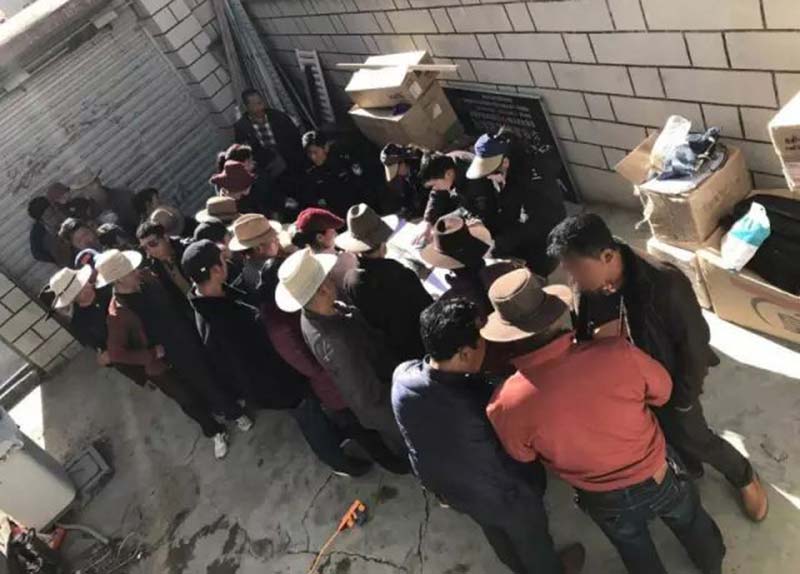
Drakyab (Chaya) County police travel to Lhasa for DNA collection of county Tibetans living in the city, April 7, 2017, via The Citizen Lab
Dirks in his research on DNA data harvesting in the Tibet Autonomous Region estimated that Chinese police may have collected DNA data from around 1 million Tibetans, one third of the TAR, between June 2016 to July 2022. Although outside of his research scope, he suspects that DNA of Tibetans living outside the officially designated Tibet Autonomous Region with equal number of Tibetans may have also been collected. In his research on iris data collection in Qinghai province, where a large population of Tibetans live outside the TAR, he estimated that the iris data of 1.2 to 1.4 million (around a quarter of the Qinghai population) were collected.[73]
The genome data collection of Tibetans is disturbing since both the DNA and iris collection of Tibetans living inside or outside the officially designated Tibet Autonomous Region is outside of any ongoing criminal investigation thus conflating crime control and social control. By targeting Tibetans from the elementary school students to the elderly, genome collection of Tibetans, in the absence of ongoing criminal investigation, leads to the conclusion that Xi Jinping’s party-state views the Tibetans as a threat to the national security of China. According to Dirks, “police surveillance programs – including networks of informants and the “grid management” of urban neighborhoods – are not unique to the Xi administration, nor is police collection of biometric data from criminal suspects. What is unique to the Xi era is police-led mass biometric surveillance of entire populations.”
POLICING THE GENOME
Data collection of the population is not unique to Xi Jinping’s administration. With evolutions in technology, the party-state under various leadership in Beijing has taken advantage of the evolving technology in perfecting repression in Tibet and other minority territories. The technological powers of information, surveillance and genome technology have been harnessed by Chinese authorities in Tibet to collect various data of Tibetans. Chinese police have leveraged the information and surveillance technology, although genome technology was formerly leveraged upon by public health authorities. But that changed under Xi Jinping’s administration. Unlike the past sporadic Tibetan DNA harvesting done by public health authorities as early as 2012, “following Xi Jinping’s coming to power, China’s police have begun collecting DNA from entire populations,” according to Emile Dirks of the Munk School of Global Affairs, University of Toronto.[72]
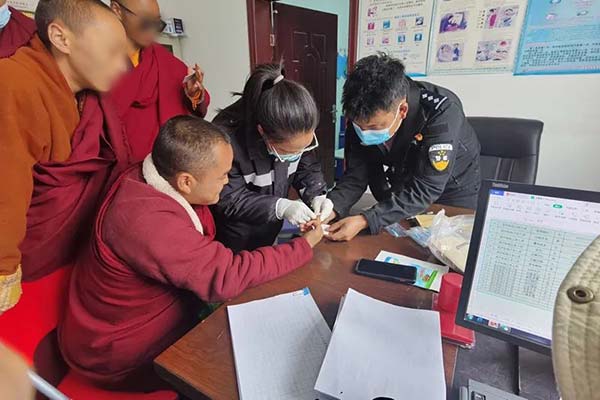
Police taking blood sample from a monk at Ngongha Choede Gon (Talin Qudi Si) in Nakartse (Langkazi) County in Lhoka (Shannan) prefectural-level city. Source: The Paper, June 24, 2020, via The Citizen Lab
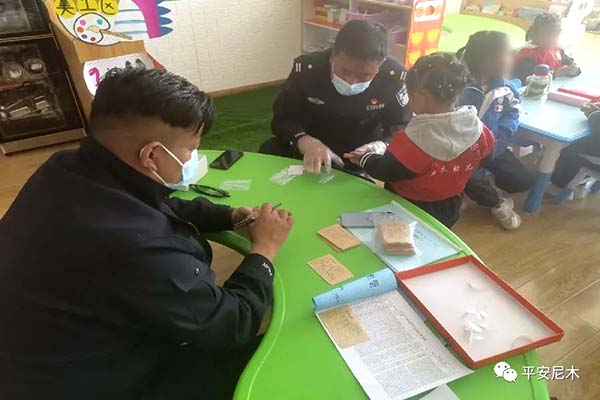
Police DNA collection from a toddler in Nyemo (Nimu) County, Lhasa prefecture-level city, April 22, 2022, via The Citizen Lab
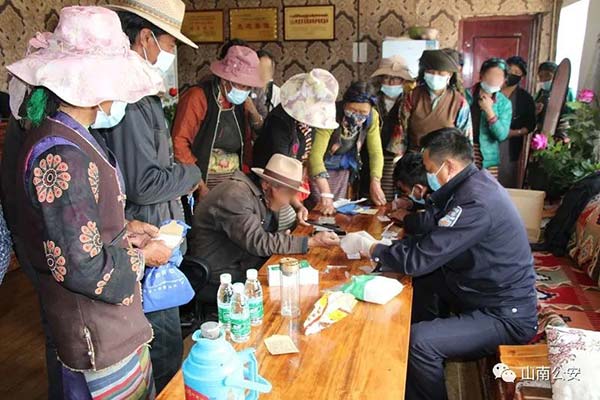
Dramda (Zhangda) Township, Nakartse (Langkazi) County, police collecting blood sample from an elderly Tibetan for DNA collection on August 30, 2021, via The Citizen Lab
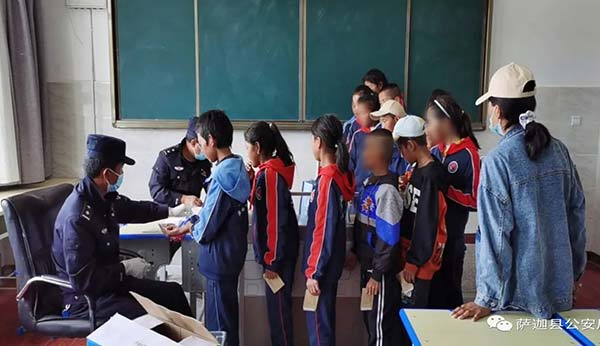
Police take blood sample for DNA collection in Sakya County, Shigatse (Xigaze) prefecture-level city, August 27, 2021, via The Citizen Lab
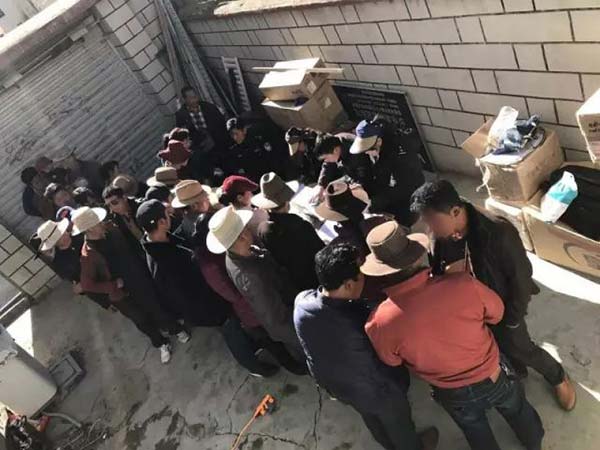
Drakyab (Chaya) County police travel to Lhasa for DNA collection of county Tibetans living in the city, April 7, 2017, via The Citizen Lab
Dirks in his research on DNA data harvesting in the Tibet Autonomous Region estimated that Chinese police may have collected DNA data from around 1 million Tibetans, one third of the TAR, between June 2016 to July 2022. Although outside of his research scope, he suspects that DNA of Tibetans living outside the officially designated Tibet Autonomous Region with equal number of Tibetans may have also been collected. In his research on iris data collection in Qinghai province, where a large population of Tibetans live outside the TAR, he estimated that the iris data of 1.2 to 1.4 million (around a quarter of the Qinghai population) were collected.[73]
The genome data collection of Tibetans is disturbing since both the DNA and iris collection of Tibetans living inside or outside the officially designated Tibet Autonomous Region is outside of any ongoing criminal investigation thus conflating crime control and social control. By targeting Tibetans from the elementary school students to the elderly, genome collection of Tibetans, in the absence of ongoing criminal investigation, leads to the conclusion that Xi Jinping’s party-state views the Tibetans as a threat to the national security of China. According to Dirks, “police surveillance programs – including networks of informants and the “grid management” of urban neighborhoods – are not unique to the Xi administration, nor is police collection of biometric data from criminal suspects. What is unique to the Xi era is police-led mass biometric surveillance of entire populations.”
XI JINPING HAS THE OPPORTUNITY TO POSITIVELY SHAPE TIBET’S (AND CHINA’S) FUTURE
Successive Chinese leaders, including Xi Jinping, have emphasized the importance of unity of “all ethnic groups,” social stability and territorial integrity.[74] Equality among peoples means irrespective of population size, economy or military strength, everyone can co-exist on an equal footing, without any one community being considered superior or better than any other. If the Tibetan and Chinese peoples can co-exist on an equal footing, this will serve as the basis for guaranteeing social stability itself.
This means it is in China’s own interest to work for a mutually beneficial solution to the Tibetan issue with the Dalai Lama. This is because he has the moral authority and is the key (as espoused by Chinese intellectuals like Wang Lixiong[75]) to ensuring that the Tibetan people will honor such a solution.
Xi should view the present Dalai Lama as an opportunity to resolve the Tibet issue. Given Xi’s stress on security of the “Chinese nation,” he should comprehend that “Tibet is very important to China’s sense of nationhood,” as outlined by Adam Segal, China expert at the Council on Foreign Relations.[76] Segal adds that “Chinese authorities have frequently suggested that they are just waiting for the Dalai Lama to die, expecting Tibetan nationalism to disappear after his death, but says this may be a miscalculation. I think the more radical Tibetans would direct the movement for independence after Dalai Lama’s death.”
XI JINPING HAS THE OPPORTUNITY TO POSITIVELY SHAPE TIBET’S (AND CHINA’S) FUTURE
Successive Chinese leaders, including Xi Jinping, have emphasized the importance of unity of “all ethnic groups,” social stability and territorial integrity.[74] Equality among peoples means irrespective of population size, economy or military strength, everyone can co-exist on an equal footing, without any one community being considered superior or better than any other. If the Tibetan and Chinese peoples can co-exist on an equal footing, this will serve as the basis for guaranteeing social stability itself.
This means it is in China’s own interest to work for a mutually beneficial solution to the Tibetan issue with the Dalai Lama. This is because he has the moral authority and is the key (as espoused by Chinese intellectuals like Wang Lixiong[75]) to ensuring that the Tibetan people will honor such a solution.
Xi should view the present Dalai Lama as an opportunity to resolve the Tibet issue. Given Xi’s stress on security of the “Chinese nation,” he should comprehend that “Tibet is very important to China’s sense of nationhood,” as outlined by Adam Segal, China expert at the Council on Foreign Relations.[76] Segal adds that “Chinese authorities have frequently suggested that they are just waiting for the Dalai Lama to die, expecting Tibetan nationalism to disappear after his death, but says this may be a miscalculation. I think the more radical Tibetans would direct the movement for independence after Dalai Lama’s death.”
CONTINUING THE LEGACY OF HIS FATHER XI ZHONGXUN?
What is not seen from Xi Jinping’s 10 years of rule is whether he can continue the legacy of his father. Xi junior is depicted as someone who holds filial piety important in his life, and so ultimately he will work to uphold the values and traditions of his father Xi Zhongxun.
As this report showed, Xi Zhongxun was seen as a reformer and played a pivotal role in CCP policy on Tibet in the initial period before he also suffered persecution and incarceration. “Xi Zhongxun was a reformer who realised that China had committed a lot of mistakes in Tibet,” according to Khedroob Thondup, who accompanied his father Gyalo Thondup, the Dalai Lama’s elder brother, in his meetings in China, including with Xi Zhongxun.[77]
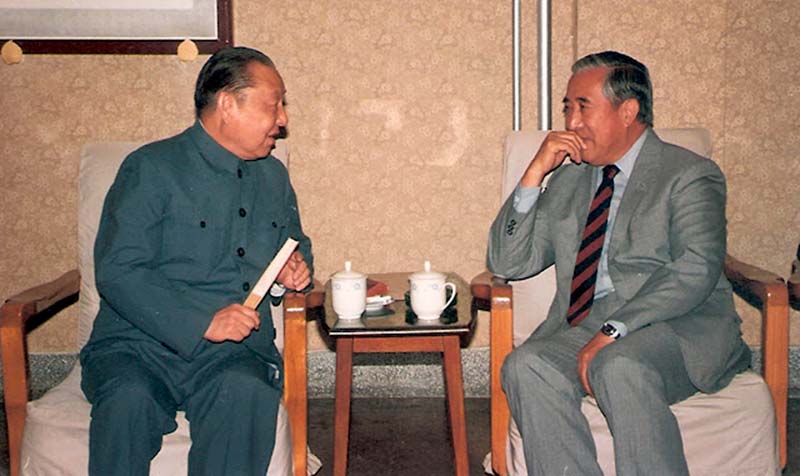
Former Premier of China and father of President Xi Jinping, Xi Zhongxun (wearing a Chinese tunic), converses with Gyalo Thondup (wearing a western suit), the brother of the Dalai Lama, during their meeting in Beijing, 1987. Photo: Khedroob Thondup
In addition to Tibet, Xi senior was seen to have a different view than the official hardline attitude on other issues. According to Professor Joseph Torigian, who has been researching Xi Zhongxun, Xi senior had felt there was the need for a more open policy on religion. Torrigian quotes Xi Zhongxun as saying in 1985: “Looking back upon history, countless facts prove that, with regards to dealing with religious issues, the more that our policies are tight and inflexible, the more that in practical terms religion is suppressed, things run counter to one’s wishes, the exact opposite result occurs, it’s not only impossible to guide activities in the area allowed by policy and law, but in fact makes activities leave the normal track, or even allows people with ulterior motives to use the situation.”[78]
Even regarding Xinjiang (known to Uyghurs as East Turkestan), Torigian says “the Chinese Communist Party has at other times used a much softer approach toward Xinjiang – and that such policies happen to be most closely associated with Xi’s own father, Xi Zhongxun.”[79]
Having dwelt on these aspects of Xi Zhongxun’s life, Torigian is categorical in maintaining that Xi Zhongxun was “the single biggest influence on” Xi Jinping’s life.[80]
For example, to coincide with Father’s Day this year, Chinese state media posted a report on Xi Jinping and his father, saying “Xi Zhongxun’s family tradition was a mirror, a benchmark and guide for his children.”[81] The report also carried a photo, which is said to be on Xi Jinping’s bookshelf, that shows Xi junior pushing his father, who is in a wheelchair, while his wife and daughter walk alongside him.
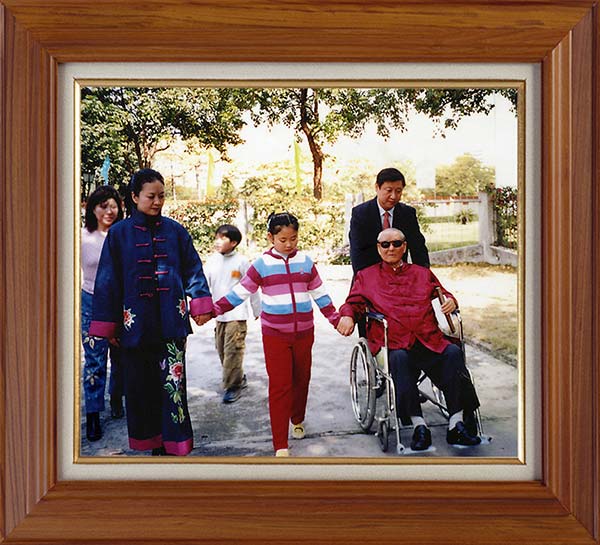
A family picture showing Xi Jinping fulfilling his filial duty by helping his father, who was sitting in a wheelchair, has been on Xi’s bookshelf since 2013. Photo: Xinhua
Ever since Xi Jinping assumed the top position in 2012, Chinese state media has repeatedly focused on his father’s legacy.
In 2013, one year after Xi took over, China state-run TV aired a six-part special series on his father that highlighted Xi Jinping’s devotion to his father.[82]
In the same year, a book of Xi Zhongxun’s articles and speeches on the Communist Party of China’s United Front work was officially released to commemorate his 100th birth anniversary. Jia Juchuan, one of its authors, is quoted by the South China Morning Post as asserting that Xi Zhongxun “maintained a pragmatic attitude about life and work,” adding, “This will certainly have influenced his children.” Jia also said that “Xi senior’s political mindset in the late 1980s was largely in line with the reformist Hu Yaobang.”
One Chinese state media outlet carried a report on Xi Jinping’s achievement in “targeted poverty alleviation,” saying that “Xi has inherited farsightedness from his father Xi Zhongxun.”[83]
If, as projected by state media, Xi Jinping honors his filial piety and upholds the legacy of his father on the issue of Tibet, there is the possibility of seeing positive changes eventually. Only time will reveal.
CONTINUING THE LEGACY OF HIS FATHER XI ZHONGXUN?
What is not seen from Xi Jinping’s 10 years of rule is whether he can continue the legacy of his father. Xi junior is depicted as someone who holds filial piety important in his life, and so ultimately he will work to uphold the values and traditions of his father Xi Zhongxun.
As this report showed, Xi Zhongxun was seen as a reformer and played a pivotal role in CCP policy on Tibet in the initial period before he also suffered persecution and incarceration. “Xi Zhongxun was a reformer who realised that China had committed a lot of mistakes in Tibet,” according to Khedroob Thondup, who accompanied his father Gyalo Thondup, the Dalai Lama’s elder brother, in his meetings in China, including with Xi Zhongxun.[77]
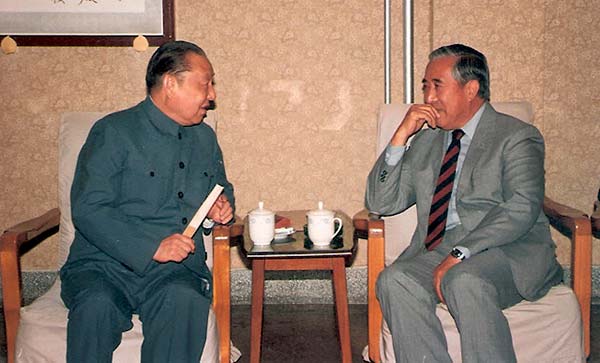
Former Premier of China and father of President Xi Jinping, Xi Zhongxun (wearing a Chinese tunic), converses with Gyalo Thondup (wearing a western suit), the brother of the Dalai Lama, during their meeting in Beijing, 1987. Photo: Khedroob Thondup
In addition to Tibet, Xi senior was seen to have a different view than the official hardline attitude on other issues. According to Professor Joseph Torigian, who has been researching Xi Zhongxun, Xi senior had felt there was the need for a more open policy on religion. Torrigian quotes Xi Zhongxun as saying in 1985: “Looking back upon history, countless facts prove that, with regards to dealing with religious issues, the more that our policies are tight and inflexible, the more that in practical terms religion is suppressed, things run counter to one’s wishes, the exact opposite result occurs, it’s not only impossible to guide activities in the area allowed by policy and law, but in fact makes activities leave the normal track, or even allows people with ulterior motives to use the situation.”[78]
Even regarding Xinjiang (known to Uyghurs as East Turkestan), Torigian says “the Chinese Communist Party has at other times used a much softer approach toward Xinjiang – and that such policies happen to be most closely associated with Xi’s own father, Xi Zhongxun.”[79]
Having dwelt on these aspects of Xi Zhongxun’s life, Torigian is categorical in maintaining that Xi Zhongxun was “the single biggest influence on” Xi Jinping’s life.[80]
For example, to coincide with Father’s Day this year, Chinese state media posted a report on Xi Jinping and his father, saying “Xi Zhongxun’s family tradition was a mirror, a benchmark and guide for his children.”[81] The report also carried a photo, which is said to be on Xi Jinping’s bookshelf, that shows Xi junior pushing his father, who is in a wheelchair, while his wife and daughter walk alongside him.
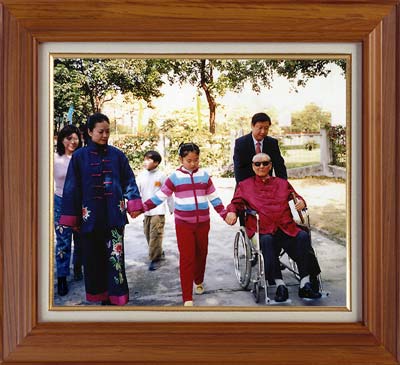
A family picture showing Xi Jinping fulfilling his filial duty by helping his father, who was sitting in a wheelchair, has been on Xi’s bookshelf since 2013. Photo: Xinhua
Ever since Xi Jinping assumed the top position in 2012, Chinese state media has repeatedly focused on his father’s legacy.
In 2013, one year after Xi took over, China state-run TV aired a six-part special series on his father that highlighted Xi Jinping’s devotion to his father.[82]
In the same year, a book of Xi Zhongxun’s articles and speeches on the Communist Party of China’s United Front work was officially released to commemorate his 100th birth anniversary. Jia Juchuan, one of its authors, is quoted by the South China Morning Post as asserting that Xi Zhongxun “maintained a pragmatic attitude about life and work,” adding, “This will certainly have influenced his children.” Jia also said that “Xi senior’s political mindset in the late 1980s was largely in line with the reformist Hu Yaobang.”
One Chinese state media outlet carried a report on Xi Jinping’s achievement in “targeted poverty alleviation,” saying that “Xi has inherited farsightedness from his father Xi Zhongxun.”[83]
If, as projected by state media, Xi Jinping honors his filial piety and upholds the legacy of his father on the issue of Tibet, there is the possibility of seeing positive changes eventually. Only time will reveal.
CONCLUSION
In the past 10 years in Tibet, Xi Jinping’s administration has launched a multifaceted and sophisticated policy in repressing the Tibetans.
Xi’s broader focus on building “Zhonghua Minzu” (the Chinese nation-state) is leading to coerced Sinification of everything Tibetan. Although the discourse on Sinification is projected as Sinification of Tibetan Buddhism, it is in reality Sinification of Tibetan people and everything Tibet by indoctrinating a “firm sense of community for the Chinese nation” for rejuvenation of China by the centennial anniversary of the People’s Republic of China in 2049.
Xi’s administration has already rolled out the second-generation ethnic policy, aimed at assimilating the Tibetan people into the Chinese nation-state. The final step in achieving complete Sinification of Tibetans lies in the abolition of the regional ethnic autonomy law. Advocates for the second-generation ethnic policy in China have previously called for the elimination of the ethnic autonomy law. Although Xi Jinping has not abolished the autonomy law during his 10-year rule, there is no guarantee that it will not be phased out in the future. While Xi Jinping has expressed opposition to its abolition in previous forums, such as the Central Ethnic Work Forum in September 2014 and the 7th Tibet Work Forum in August 2020, his emphasis on national unity, the gradual nature of the ethnic strategy and adherence to Marxist dialectical thinking indicate a potential de-emphasis and eventual complete elimination of the ethnic autonomy law. Until its potential abolition, the ethnic autonomy law and constitutional guarantees can be seen as tools utilized by the party-state to enhance both domestic and international legitimacy, even though their effectiveness may be met with skepticism.[84] With Xi’s indefinite rule in Beijing, there is no certainty that the ethnic autonomy law and the constitutional guarantees for minority peoples will remain unchanged.
If the past 10 years are any indication of the outlook for the present and future Tibet policy of Xi Jinping, then the prognosis is not good. All indications are that there is a decision to wipe out any semblance of Tibetan identity, be it religion, culture or politics, that has a hint of Tibetans being a distinct entity.
However, traditional Chinese society holds filial piety important, and Xi Jinping is being projected as someone who adheres to it and sees his father, Xi Zhongxun, as an inspiration. Xi senior has been known to be among those advocating for a softer approach on Tibet, and so it remains to be seen whether Xi Jinping will uphold his father’s legacy on Tibet.
CONCLUSION
In the past 10 years in Tibet, Xi Jinping’s administration has launched a multifaceted and sophisticated policy in repressing the Tibetans.
Xi’s broader focus on building “Zhonghua Minzu” (the Chinese nation-state) is leading to coerced Sinification of everything Tibetan. Although the discourse on Sinification is projected as Sinification of Tibetan Buddhism, it is in reality Sinification of Tibetan people and everything Tibet by indoctrinating a “firm sense of community for the Chinese nation” for rejuvenation of China by the centennial anniversary of the People’s Republic of China in 2049.
Xi’s administration has already rolled out the second-generation ethnic policy, aimed at assimilating the Tibetan people into the Chinese nation-state. The final step in achieving complete Sinification of Tibetans lies in the abolition of the regional ethnic autonomy law. Advocates for the second-generation ethnic policy in China have previously called for the elimination of the ethnic autonomy law. Although Xi Jinping has not abolished the autonomy law during his 10-year rule, there is no guarantee that it will not be phased out in the future. While Xi Jinping has expressed opposition to its abolition in previous forums, such as the Central Ethnic Work Forum in September 2014 and the 7th Tibet Work Forum in August 2020, his emphasis on national unity, the gradual nature of the ethnic strategy and adherence to Marxist dialectical thinking indicate a potential de-emphasis and eventual complete elimination of the ethnic autonomy law. Until its potential abolition, the ethnic autonomy law and constitutional guarantees can be seen as tools utilized by the party-state to enhance both domestic and international legitimacy, even though their effectiveness may be met with skepticism.[84] With Xi’s indefinite rule in Beijing, there is no certainty that the ethnic autonomy law and the constitutional guarantees for minority peoples will remain unchanged.
If the past 10 years are any indication of the outlook for the present and future Tibet policy of Xi Jinping, then the prognosis is not good. All indications are that there is a decision to wipe out any semblance of Tibetan identity, be it religion, culture or politics, that has a hint of Tibetans being a distinct entity.
However, traditional Chinese society holds filial piety important, and Xi Jinping is being projected as someone who adheres to it and sees his father, Xi Zhongxun, as an inspiration. Xi senior has been known to be among those advocating for a softer approach on Tibet, and so it remains to be seen whether Xi Jinping will uphold his father’s legacy on Tibet.
RECOMMENDATIONS
International Community
- Governments should articulate their Tibet policy on the fact that the Dalai Lama and the elected Tibetan leadership are the legitimate representatives of the Tibetan people, and that Tibet’s stability enhances China’s stability Governments should view rights violations and repression in Tibet as a threat to regional and international security.
- Governments should undertake concrete initiatives to pressure Beijing to engage the Dalai Lama’s envoys in direct, substantive dialogue without preconditions.
- Governments should work with the EU, the UN, and other international bodies to mount forceful opposition to the Chinese policy of securitization of Tibet and the eradication of a self-determined and authentic culture.
- Governments should engage with China, but they should do so while strongly standing up on the fundamental issues of reciprocity, basic human rights, both civil and political and economic, social and cultural rights.
- Governments should work multilaterally to support the traditional spiritual authority of the Dalai Lama and Tibetan Buddhists and counter Chinese interference in Tibet’s religious affairs, particularly in the reincarnation process. Along with international bodies, including the EU, they should undertake coordinated initiatives in developing a united policy on religious freedom of the Tibetan people, including at the UN and other international and regional forums.
- Governments should establish contact and have an open and regular dialogue with the democratically elected leadership of the Central Tibetan Administration in India.
- Governments should empower Tibetans in Tibet and in exile to pursue, preserve and promote their human rights and their distinct cultural, linguistic and religious heritage, and support democratically elected and administered Tibetan institutions in exile.
European Union
- In line with the EU guidelines on the promotion and protection of freedom of religion or belief, the EU should adopt a formal/official public EU position/statement recognizing that the decisions regarding the recognition of Tibetan Buddhist religious leaders, including a future Dalai Lama, are exclusively spiritual matters that should be made by the Tibetan Buddhist community and the present 14th Dalai Lama.
- Given the worsening of the situation in Tibet under Xi Jinping, the EU and its Member States should task their Delegation and Embassies in Beijing to expand their outreach to Tibetan communities and strengthen monitoring of the situation in Tibet, including by maintaining a specific action officer on Tibet in the embassies and requesting visits to Tibetan areas.
- EU should consider sanctioning Chinese officials responsible for implementing policies such as labor programs and compulsory boarding (pre-) schools that threaten the survival of Tibetan culture, religion and Tibetan ways of life and economic subsistence.
- Drawing on the US initiative, the EU’s Member States should decide on establishing consulates in Lhasa and start discussion with China accordingly.
United States
- US should in accordance with the Tibetan Policy & Support Act of 2020 (Public Law No: 116-260) be actively involved multilaterally to support the Tibetan religious rights.
- Congress should pass appropriate legislations that will support the Dalai Lama and the Tibetan people in finding a negotiated solution to resolve the Tibetan issue and ensure that this support will be there until such a solution is found.
- US should implement the Reciprocal Access to Tibet Act of 2018 (Public Law No: 115-330) and establish reciprocity as the cornerstone of U.S.-China relations.
RECOMMENDATIONS
International Community
- Governments should articulate their Tibet policy on the fact that the Dalai Lama and the elected Tibetan leadership are the legitimate representatives of the Tibetan people, and that Tibet’s stability enhances China’s stability Governments should view rights violations and repression in Tibet as a threat to regional and international security.
- Governments should undertake concrete initiatives to pressure Beijing to engage the Dalai Lama’s envoys in direct, substantive dialogue without preconditions.
- Governments should work with the EU, the UN, and other international bodies to mount forceful opposition to the Chinese policy of securitization of Tibet and the eradication of a self-determined and authentic culture.
- Governments should engage with China, but they should do so while strongly standing up on the fundamental issues of reciprocity, basic human rights, both civil and political and economic, social and cultural rights.
- Governments should work multilaterally to support the traditional spiritual authority of the Dalai Lama and Tibetan Buddhists and counter Chinese interference in Tibet’s religious affairs, particularly in the reincarnation process. Along with international bodies, including the EU, they should undertake coordinated initiatives in developing a united policy on religious freedom of the Tibetan people, including at the UN and other international and regional forums.
- Governments should establish contact and have an open and regular dialogue with the democratically elected leadership of the Central Tibetan Administration in India.
- Governments should empower Tibetans in Tibet and in exile to pursue, preserve and promote their human rights and their distinct cultural, linguistic and religious heritage, and support democratically elected and administered Tibetan institutions in exile.
European Union
- In line with the EU guidelines on the promotion and protection of freedom of religion or belief, the EU should adopt a formal/official public EU position/statement recognizing that the decisions regarding the recognition of Tibetan Buddhist religious leaders, including a future Dalai Lama, are exclusively spiritual matters that should be made by the Tibetan Buddhist community and the present 14th Dalai Lama.
- Given the worsening of the situation in Tibet under Xi Jinping, the EU and its Member States should task their Delegation and Embassies in Beijing to expand their outreach to Tibetan communities and strengthen monitoring of the situation in Tibet, including by maintaining a specific action officer on Tibet in the embassies and requesting visits to Tibetan areas.
- EU should consider sanctioning Chinese officials responsible for implementing policies such as labor programs and compulsory boarding (pre-) schools that threaten the survival of Tibetan culture, religion and Tibetan ways of life and economic subsistence.
- Drawing on the U.S. initiative, the EU’s Member States should decide on establishing consulates in Lhasa and start discussion with China accordingly.
United States
- US should in accordance with the Tibetan Policy & Support Act of 2020 (Public Law No: 116-260) be actively involved multilaterally to support the Tibetan religious rights.
- Congress should pass appropriate legislations that will support the Dalai Lama and the Tibetan people in finding a negotiated solution to resolve the Tibetan issue and ensure that this support will be there until such a solution is found.
- US should implement the Reciprocal Access to Tibet Act of 2018 (Public Law No: 115-330) and establish reciprocity as the cornerstone of US-China relations.
NOTE ON COVER PHOTO:
Xi Jinping with his entourage at the Potala square in Tibet’s capital Lhasa on July 22, 2021. Source: Xinhua
NOTE ON GEOGRAPHICAL TERMS:
Tibet traditionally comprised three main areas: Amdo (northeastern Tibet), Kham (eastern Tibet) and U-Tsang (central and western Tibet). The Tibet Autonomous Region was set up by the Chinese government in 1965 and covers the area of Tibet west of the Drichu or Yangtze River, including part of Kham. The rest of Amdo and Kham have been incorporated into Chinese provinces, and where Tibetan communities were said to have “compact inhabitancy” in these provinces, they were designated Tibetan autonomous prefectures and counties. As a result most of Qinghai and parts of Gansu, Sichuan and Yunnan provinces are acknowledged by the Chinese government to be “Tibetan.” ICT uses the term “Tibet” to refer to all Tibetan areas currently under the jurisdiction of the People’s Republic of China.
[1] Academics and policy research analysts have employed various terms to depict the phenomenon of identity transformation in the People’s Republic of China. The selection of these terms depends on their respective interpretations of the process, considering historical perspectives, changes observed since the establishment of the People’s Republic, or the specific focus during Xi Jinping’s leadership. Depending on the author’s viewpoint, terms such as Sinicization, Sinification, Chinafication and Hanification have been utilized. For the purpose of this report, the term “Sinification” is adopted to describe the assimilationist approach and the reconstitution of identity during Xi Jinping’s administration.
[2] Xi Jinping, likely China’s next leader, seen as pragmatic, low-key, August 11, 2011, https://www.washingtonpost.com/world/asia-pacific/xi-jinping-likely-chinas-next-leader-called-pragmatic-low-key/2011/08/15/gIQA5W83GJ_story.html
[3] “Dalai Lama says expects China political reform under Xi” Reuters, November 5, 2012, https://www.reuters.com/article/us-china-tibet-dalailama/dalai-lama-says-expects-china-political-reform-under-xi-idUSBRE8A40ER20121105
[4] “Tibet’s problem is also India’s problem, says His Holiness the Dalai Lama as PM Modi meets President Xi” Central Tibetan Administration, September 18, 2014, https://tibet.net/tibets-problem-is-also-indias-problem-says-his-holiness-the-dalai-lama-as-pm-modi-meets-president-xi/
[5] A Tibetan Revolutionary, The Political Life and Times of Bapa Phüntso Wangye by Melvyn C. Goldstein, Dawei Sherap, William R Siebenschuh, September 2006, p 302-305
[6] Benjamin Kang Lim and Frank Jack Daniel, ‘Does China’s next leader have a soft spot for Tibet?’, Reuters, 1 September 2012, https://www.reuters.com/article/china-tibet-xi-jinping/does-chinas-next-leader-have-a-soft-spot-for-tibet-idINDEE88002I20120901
[8] David Shambaugh, “Don’t Expect Reform from China’s New Leaders,” Brookings (blog), November 15, 2012, https://www.brookings.edu/opinions/dont-expect-reform-from-chinas-new-leaders/.
[9] John Dotson, “Outcomes of the Chinese Communist Party’s 18th National Congress,” Research report, The China Rising Leaders Project (Washington, D.C: U.S.-CHINA ECONOMIC AND SECURITY REVIEW COMMISSION, December 21, 2012), https://www.uscc.gov/sites/default/files/Research/18th-CCP_PartyCongress_Overview.pdf. 22. For the rise of Princelings, see “The Princelings Are Coming,” The Economic Times (Online), June 25, 2011, https://www.economist.com/special-report/2011/06/25/the-princelings-are-coming.
[10] Michał Bogusz, Jakub Jakóbowski, and Jim Todd, The Chinese Communist Party and Its State: Xi Jinping’s Conservative Turn (Warszawa: Ośrodek Studiów Wschodnich im. Marka Karpia, 2020). 6.
[11] Bogusz, Jakóbowski, and Todd. 75
[12] Xi inspects Tibet, stressing lasting stability, high-quality development, Xinhua, July 24, 2021, https://web.archive.org/save/http://www.xinhuanet.com/english/2021-07/24/c_1310081389.htm
[13] “Timeline: Xi Jinping and Tibet’s Development,” China Today, March 29, 2019, http://www.chinatoday.com.cn/ctenglish/2018/ttxw/201903/t20190329_800163688.html.
[14] International Campaign for Tibet, “‘Acts of Significant Evil,’” July 31, 2014, https://savetibet.org/acts-of-significant-evil-report/.
[15] State media Gannan Daily citing the “Opinions on Handling Self-immolation Cases in Tibetan Areas According to Law” is reproduced by Woeser Tsering, “At the beginning of December, two Tibetans set themselves on fire, and the total number rose to 97; the Chinese Communist Party issued the ‘Opinions on Handling Self-immolation Cases in Tibetan Areas According to the Law’ [12月伊始,两位藏人自焚,总数升至97位;中共当局下发《关于依法办理藏区自焚案件的意见》],” n.d., http://woeser.middle-way.net/2012/12/1297.html.
[16] Bogusz, Jakóbowski, and Todd, The Chinese Communist Party and Its State. p 6
[17] “What did the six central forums on work in Tibet talk about?” “六次中央西藏工作座谈会 都谈了什么?”< Xinhua, August 26, 2015, http://www.xinhuanet.com/politics/2015-08/26/c_128168342.htm
[18] “第一观察 | ‘十个必须’传递新时代党的治藏方略要义-新华网 [“Ten Musts” Conveying the Essentials of the Party’s Strategy for Governing Tibet in the New Era],” August 30, 2020, http://www.xinhuanet.com/politics/2020-08/30/c_1126429558.htm.
[19] “Achieving Rejuvenation Is the Dream of the Chinese People,” November 29, 2012, https://web.archive.org/save/http://www.npc.gov.cn/englishnpc/c23934/202006/32191c5bbdb04cbab6df01e5077d1c60.shtml.
[20] Leaders in China in the past had envisioned the cause of the Chinese nation and national unity in various ways, but Xi Jinping has envisioned it in terms of forging the consciousness of the community of the Chinese nation, Jinping Xi, “在全国民族团结进步表彰大会上的讲话 [Speech at the National Commendation Conference for Ethnic Unity and Progress],” Central People’s Government of the People’s Republic of China, September 27, 2019, https://www.gov.cn/gongbao/content/2019/content_5442260.htm.
[21] Berkley Center for Religion Affairs Peace and World, “The Xi Jinping Cohort and the Chinafication of Religion,” March 16, 2020 https://berkleycenter.georgetown.edu/responses/the-xi-jinping-cohort-and-the-chinafication-of-religion.
[22] Uradyn E. Bulag, “Minority Nationalities as Frankenstein’s Monsters? Reshaping ‘the Chinese Nation’ and China’s Quest to Become a ‘Normal Country,’” The China Journal 86 (July 1, 2021): 46–67, https://doi.org/10.1086/714737. 62
[23] Uradyn E. Bulag, “Alter/Native Mongolian Identity: From Nationality to Ethnic Group,” in Chinese Society, 3rd ed. (Routledge, 2010), 261–87. p 263
[24] Zhu Weiqun 朱維群, “Dui dangqian minzu lingyu wenti de jidian sikao 對當前民族領 域問題的幾點思考 [Thoughts on Several Current Issues Concerning Ethnicity],” Xuexi shibao 學習時報 [Study Times], February 13, 2012.
[25] June Teufel Dreyer, China’s Political System: Modernization and Tradition, 9th ed. (Routledge, 2016). 326.
[26] Bulag, “Minority Nationalities as Frankenstein’s Monsters?” p 50
[27] James Leibold, “Planting the Seed: Ethnic Policy in Xi Jinping’s New Era of Cultural Nationalism,” The Jamestown Foundation, December 31, 2019, https://jamestown.org/program/planting-the-seed-ethnic-policy-in-xi-jinpings-new-era-of-cultural-nationalism/.
[28] Weiqun Zhu, “炎黄子孙称呼不科学 伤民族感情_观点库_观点中国 [The Unscientific Name of the Descendants of Yan and Huang Dynasty Hurts National Sentiments],” Study Times, February 14, 2012, https://web.archive.org/web/20230627214432/https://china.huanqiu.com/article/9CaKrnJueWF.
[29] Austin Ramzy and Chris Buckley, “‘Absolutely No Mercy’: Leaked Files Expose How China Organized Mass Detentions of Muslims,” The New York Times, November 16, 2019, sec. World, https://www.nytimes.com/interactive/2019/11/16/world/asia/china-xinjiang-documents.html.
[30] “(受权发布)习近平:在全国民族团结进步表彰大会上的讲话-新华网 [(Authorized to Issue) Xi Jinping: Speech at the National Commendation Unity and Progress Commendation Conference],” Xinhua, September 27, 2019, https://web.archive.org/web/20230627215750/http://www.xinhuanet.com/politics/leaders/2019-09/27/c_1125049000.htm.
[31] “Xi Calls for Efforts to Build Modern Chinese Civilization-Xinhua,” June 3, 2023, https://web.archive.org/save/https://english.news.cn/20230603/197012efecbf4a34992b6df61a05310c/c.html.
[32] “‘中国特色的关键就在于“两个结合”’ [“The Key to Chinese Characteristics Lies in the ‘Combination of Two’”],” People’s Daily, June 5, 2023, https://web.archive.org/web/20230627220611/http://politics.people.com.cn/n1/2023/0605/c1001-40005909.html
[33] “青海省委民族工作会议召开 王建军讲话 信长星主持 多杰热旦出席 [Provincial ethnic work conference held Wang Jianjun’s Speech, Xin Changxing Presided, Dorje Rapten Attended],” Qinghai Daily, December 20, 2021, https://web.archive.org/web/20230627221842/https://www.qhlingwang.com/xinwen/qinghai/2021-12-20/488595.html
[34] Dr Monika Chansoria, “Shadow of Xi Jinping’s ‘Four Histories’ Narrative Darkens First U.S.-China Bilateral Talks | JAPAN Forward,” April 1, 2021, https://japan-forward.com/shadow-of-xi-jinpings-four-histories-narrative-darkens-first-u-s-china-bilateral-talks/.
[35] Quan You, “做好新时代党的民族工作的科学指引 – 求是网 [Scientific Guidance for Doing a Good Job in the Party’s National Work in the New Era],” 求是 [Seeking Truth], November 1, 2021, https://web.archive.org/web/20230627212628/http://www.qstheory.cn/dukan/qs/2021-11/01/c_1128014610.htm
[36] Daniel Tobin, “How Xi Jinping’s ‘New Era’ Should Have Ended U.S. Debate on Beijing’s Ambitions” (Washington, D.C.: Centre for Strategic and International Studies, May 2020), https://www.csis.org/analysis/how-xi-jinpings-new-era-should-have-ended-us-debate-beijings-ambitions.
[37] “Separated From Their Families, Hidden From the World: China’s Vast System of Colonial Boarding Schools Inside Tibet” (Tibet Action Institute, December 2021), https://tibetaction.net/campaigns/colonialboardingschools/. P 8.
[38] “Separated From Their Families, Hidden From the World: China’s Vast System of Colonial Boarding Schools Inside Tibet.” P 10.
[39] Catriona Bass, Education in Tibet: Policy and practice since 1950 (London: Zed books, 1998), 50.
[40] State Council, “Decision of the State Council on Accelerating the Development of Ethnic Education,” National Document [2015] 46, issued August 11, 2015, section 19, https://web.archive.org/web/20210629235302/http://www.gov.cn/zhengce/content/2015-08/17/content_10097.htm
[41] News briefing by the Ministry of Education on the Document No. 27 issued by the State Council in 2018, “Quanmian jiaqiang lianglei xuexiao jianshe, tuidong chengxiang yiwu jiaoyu yitihua fazhan” [Comprehensively strengthen the construction of two types of schools and promote the integrated development of urban and rural compulsory education], June 30, 2018, available at: https://zgszcpjy.com/details_show?NEWS_ID=360df1f4d8 954fdcbc055c7381aafbc8
[42] Maya Wang, Human Rights Watch, “China Signals Roll-Back on Minority Languages,” January 28, 2021, available at: https:// www.hrw.org/news/2021/01/28/china-signals-roll-back-minority-languages citing https://www.sohu.com/a/445682714_161795
[43] “教育部办公厅关于实施学前儿童普通话 教育‘童语同音’计划的通知 – 中华人民共和国教育部政府门户网站,” [Notice of the General Office of the Ministry of Education on the Implementation of the “Children’s Language Homophony” Program for Putonghua Education for Preschool Children, No.3,] July 21, 2021, https://web.archive.org/save/http://www.moe.gov.cn/srcsite/A18/s3129/202108/t20210802_548318.html.
[44] “习近平在中央第七次西藏工作座谈会上强调:全面贯彻新时代党的治藏方略 建设团结富裕文明和谐美丽的社会主义现代化新西藏_滚动新闻_中国政府网,” [ Xi Jinping emphasized at the Seventh Central Tibet Work Symposium: Fully implement the party’s strategy for governing Tibet in the new era and build a socialist modernized new Tibet that is united, prosperous, civilized, harmonious and beautiful], August 30, 2020, https://web.archive.org/save/http://www.gov.cn/xinwen/2020-08/29/content_5538394.htm.
[45] “Speech by H.E. Xi Jinping President of the People’s Republic of China At UNESCO Headquarters,” March 28, 2014, https://web.archive.org/save/https://www.fmprc.gov.cn/mfa_eng/wjdt_665385/zyjh_665391/201403/t20140331_678150.html.
[46] Sarah Cook, “Chinese Buddhism and Taoism: Religious Freedom in China,” Freedom House, 2017, https://freedomhouse.org/report/2017/battle-china-spirit-chinese-buddhism-taoism.
[47] “Xi Calls for Improved Religious Work- China.Org.Cn,” April 24,2016, https://web.archive.org/save/http://www.china.org.cn/china/2016-04/24/content_38312410.htm
[48] “时隔五年再开全国宗教工作会议,习近平为何一再强调这几个问题?–时政–人民网 [After Five Years, the National Religious Work Conference Was Held Again. Why Did Xi Jinping Repeatedly Emphasize These Issues?],” December 6, 2021, CCTV, http://politics.people.com.cn/n1/2021/1206/c1001-32300518.html.
[49] “Xi Jinping: Consolidate and develop the broadest patriotic united front and provide extensive support for the realization of the Chinese Dream. Yu Zhengsheng attended the meeting and delivered a speech.” “习近平:巩固发展最广泛的爱国统一战线 为实现中国梦提供广泛力量支持–新闻报道-中国共产党新闻网,” People’s Daily, May 21, 2015 https://web.archive.org/save/http://cpc.people.com.cn/n/2015/0521/c64094-27032339.html
[50] Pitman B. Potter, “Belief in Control: Regulation of Religion in China,” The China Quarterly 174 (June 2003): 317–37, 321.
[51] Jessica Batke, “PRC Religious Policy: Serving the Gods of the CCP,” Hoover Institution, China Leadership Monitor, no. 15 (Winter 2017), https://www.hoover.org/sites/default/files/research/docs/clm52jb.pdf.
[52] “Xi Jinping: Consolidate and develop the broadest patriotic united front” “习近平:巩固发展最广泛的爱国统一战线,” Xinhuanet, May 20, 2015, https://web.archive.org/save/http://www.xinhuanet.com//politics/2015-05/20/c_1115351358.htm.
[53] International Campaign for Tibet, “Party Above Buddhism,” International Campaign for Tibet, March 10, 2021, https://savetibet.org/party-above-buddhism/.
[54] “Xi Jinping on Work Related to Religious Affairs,” Xinhua, December 5, 2021, https://web.archive.org/save/https://www.chinadaily.com.cn/a/202112/05/WS61ac8769a310cdd39bc79722.html
[55] “十一世班禅勉励僧众要在推动藏传佛教中国化上彰显新担当_藏学_中国西藏网 [The Eleventh Panchen Lama Encourages Monks to Show New Responsibilities in Promoting the Sinicization of Tibetan Buddhism],” China Tibet Net, October 16, 2020, http://www.tibet.cn/cn/culture/zx/202010/t20201016_6871120.html.
[56] “Wu Yingjie attended the region’s religious community representatives forum” “吴英杰出席全区宗教界代表人士座谈会_西藏自治区商务厅,” https://web.archive.org/save/http://swt.xizang.gov.cn/xwzx/xzxw/202101/t20210104_186048.html.
[57] “做好民族工作,少数民族干部是重要桥梁和纽带。[To Do a Good Job in Ethnic Work, Ethnic Minority Cadres Are Important Bridges and Links.],” China Ethnic and Religious Network, July 4, 2019, http://www.mzb.com.cn/html/report/190735721-1.htm.
[58] “Pema Wangdue stressed: Always adhere to the direction of sinicizing Tibetan Buddhism, raise the level of legalization of religious work, and actively guide Tibetan Buddhism to adapt to socialist society,” Lhasa Daily, November 7, 2020 “始终坚持藏传佛教中国化方向 提高宗教工作法治化水平 积极引导藏传佛教与社会主义社会相适应,” https://web.archive.org/save/http://www.lasaribao.com/lsrb/pc/content/202011/07/c103836.html.
[59] “Fully Understand the Significance of Carrying out the ‘Three Consciousness’ Publicity and Education- Theory- Zhonggong.Com,” July 11, 2022, https://www.workercn.cn/c/2022-07-11/7007690.shtml.
[60] “昌都市卡若区召开2023年宗教界代表人士座谈会_工作动态_西藏统一战线 [The 2023 symposium for representatives of the religious circles held in Kharo District],” March 3, 2023, http://www.xztzb.cn/jiaoliu/1677838952118.shtml.
[61] “那曲市宗教界‘三个意识’教育宣讲工作拓新局_民族宗教_西藏统一战线 [Nagchu City Religious Circle’s “Three Consciousness” Education and Publicity Work Expansion ],” April 12, 2023, http://www.xztzb.cn/zongjiao/1681304523403.shtml.
[62] “Tibet Autonomous Region’s Research Center for Casting the Consciousness of Chinese National Community inaugurated” “西藏自治区铸牢中华民族共同体意识研究中心揭牌成立 Tibet Daily, March 23, 2023, https://web.archive.org/save/http://xz.people.com.cn/n2/2023/0323/c138901-40348359.html.
[63] Howard Wang, “‘Security Is a Prerequisite for Development’: Consensus-Building toward a New Top Priority in the Chinese Communist Party,” Journal of Contemporary China (August 7, 2022): 1–15, https://doi.org/10.1080/10670564.2022.2108681.
[64] Sheena Greitens, “How Does China Think about National Security?,” in The China Questions 2: Critical Insights into US-China Relations (Harvard University Press, 2022), 173.
[65] Tai Ming Cheung, “The Chinese National Security State Emerges from the Shadows to Center Stage,” China Leadership, September 1, 2020, https://www.prcleader.org/cheung.
[66] Greitens, “How Does China Think about National Security?”, 171.
[68] “‘Comprehensive National Security’ Unleashed: How Xi’s Approach Shapes China’s Policies at Home and Abroad | Merics,” September 15, 2022, https://www.merics.org/en/report/comprehensive-national-security-unleashed-how-xis-approach-shapes-chinas-policies-home-and. 6.
[69] Greitens, “How Does China Think about National Security?” 174.
[70] “State of Surveillance,” ChinaFile, October 30, 2020, https://www.chinafile.com/state-surveillance-china.
[71] Greitens, “How Does China Think about National Security?” 175.
[72] Emile Dirkss, “Mass DNA Collection in the Tibet Autonomous Region from 2016–2022 – The Citizen Lab,” September 13, 2022, https://citizenlab.ca/2022/09/mass-dna-collection-in-the-tibet-autonomous-region/.
[73] Emile Dirks, “Mass Iris Scan Collection in Qinghai: 2019–2022” (Citizen Lab, University of Toronto, December 14, 2022), https://citizenlab.ca/2022/12/mass-iris-scan-collection-in-qinghai/.
[74] “Xi calls on all ethnic groups to jointly create bright future” Xinhua, September 27, 2019, https://web.archive.org/save/https://chinaplus.cri.cn/chinaplus/news/china/9/20190927/359202.html?5435
[75] “The People’s Republic of China’s 21st Century Underbelly” Wang Lixiong, Beijing Zhanlue Yu Guanli in Chinese on January 2, 1999 http://www.columbia.edu/itc/ealac/barnett/pdfs/link14-wang-lixiong.pdf
[76] “The Question of Tibet” Backgrounder by Jayshree Bajoria, Council on Foreign Relations, December 5, 2008, https://www.cfr.org/backgrounder/question-tibet
[77] “My encounter with Xi Jinping’s father” Khedroob Thondup, The Week, October 30, 2022, https://www.theweek.in/theweek/more/2022/10/21/meeting-xi-jinping-father-xi-zhongxun.html
[78] “What Xi Jinping Learned—And Didn’t Learn—From His Father About Xinjiang”, Joseph Torigian, The Diplomat, November 26, 2019, https://thediplomat.com/2019/11/what-xi-jinping-learned-and-didnt-learn-from-his-father-about-xinjiang/
[80] The Party’s Interests Come First: The Life of Xi Zhongxun, Joseph Torigian, https://chinafellowship.wilsoncenter.org/microsite/2/node/105812
[81] “Father’s Day: Words from Xi Jinping’s father to his son”, CGTN, June 18, 2023, https://web.archive.org/save/https://news.cgtn.com/news/2023-06-18/Father-s-Day-Words-from-Xi-Jinping-s-father-to-his-son-1kJoiEjbMEU/index.html
[82] “CCTV Series Tells the Story of Xi Zhongxun,” South China Morning Post, October 16, 2013, sec. News, https://www.scmp.com/news/china/article/1332590/cctv-series-tells-story-xi-zhongxun. Also see https://tv.cctv.com/2013/10/15/VIDA1381828324618456.shtml
[83] “Cradle of Targeted Poverty Alleviation” China Today, October 15, 2020, https://web.archive.org/save/http://www.chinatoday.com.cn/ctenglish/2018/ln/202010/t20201015_800223688.html
[84] Neil Diament introduced the term “Useful Bullshit” to encapsulate the Chinese government’s perception and utilization of the constitution as a means of bolstering its legitimacy. Neil J. Diamant, Useful Bullshit: Constitutions in Chinese Politics and Society (Ithaca, New York: Cornell University Press, 2021).

